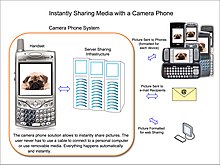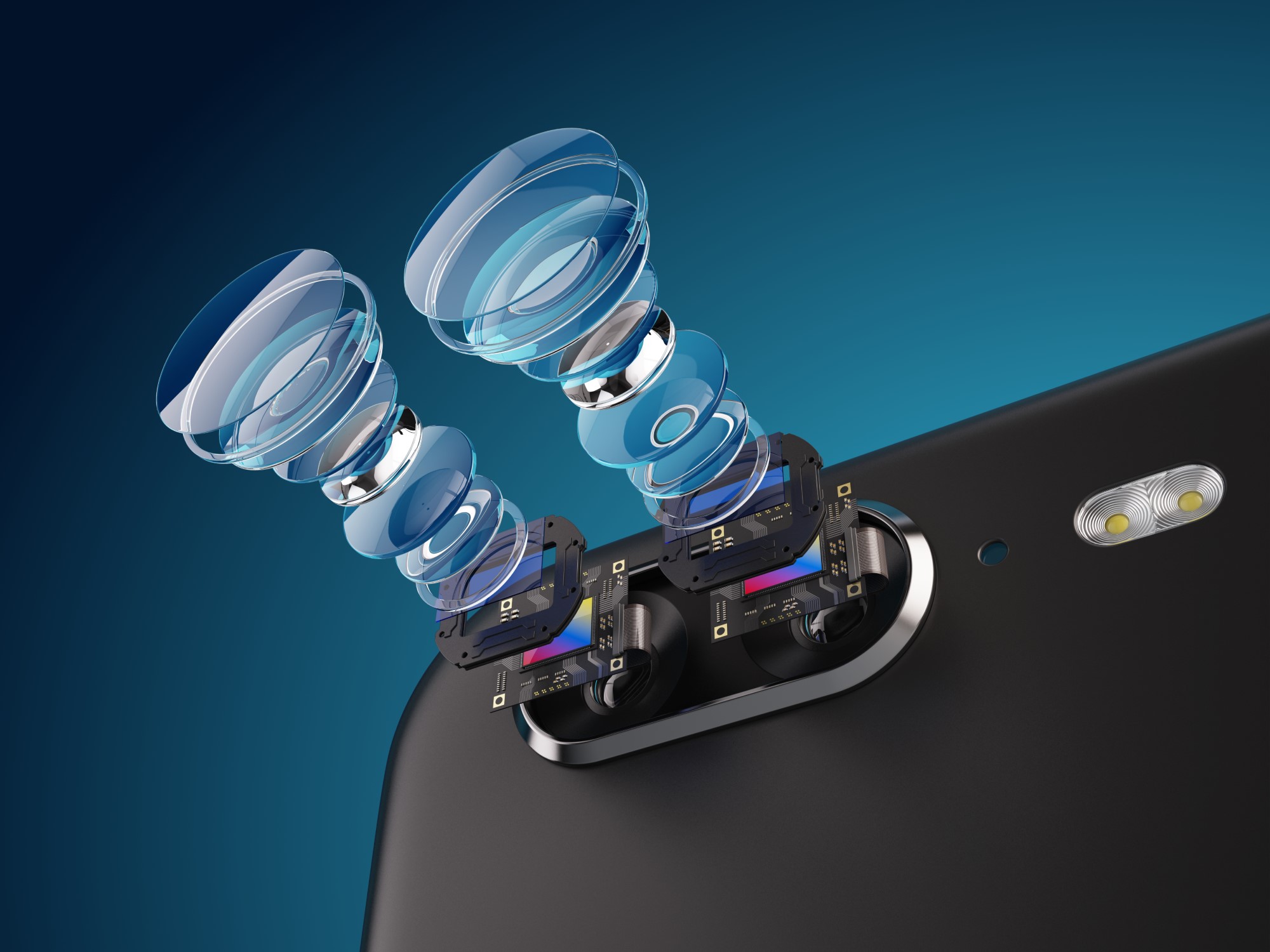
Оценка этой статьи по мнению читателей:
Выбор смартфона — дело важное и очень непростое! Ведь помимо самого телефона, вы выбираете плеер, камеру, «читалку», игровую консоль, GPS-навигатор и многое другое. Конечно, если бюджет не играет для вас никакой роли, выбрав самый дорогой смартфон, вы, в большинстве случаев, получите лучшее устройство по всем параметрам.
Но что делать, когда бюджет ограничен и не хочется ошибиться с выбором? Как вариант можно спросить совет на форуме или довериться консультанту магазина (что будет большой ошибкой, так как консультанты заинтересованы в том, чтобы помочь магазину, а не вам). А можно разобраться самому. Именно этим путем мы и пойдем!
Затронуть все характеристики смартфона в одной статье — задача невыполнимая, поэтому, сконцентрируем внимание лишь на одном (но очень важном) параметре любого современного смартфона — камере.
На какие характеристики следует обращать внимание?
Если мы откроем страничку любого смартфона в интернет-магазине и посмотрим на графу камера, то увидим примерно следующее (конечно, не везде указаны полные характеристики):
- Разрешение 12 Мп
- Диафрагма/апертура ƒ/1.8
- Телеобъектив и широкоугольный объектив
- Датчик глубины DoF, в некоторых случаях — ToF
- Поддержка HDR
- Оптическая стабилизация
- Автофокус (Dual Pixel или Pixel Focus)
- Запись видео в форматах 4K 60 FPS
- Размер пикселя: 1.0μm
- Размер матрицы 1/2.8″, черно-белый сенсор
Что значат все эти слова? Как по ним оценить качество камеры? Давайте разбираться.
Что такое разрешение камеры мобильного телефона?
Разрешение камеры — это базовое понятие в мобильной фотографии. Зачастую, многие производители (особенно недорогих смартфонов) указывают лишь эту информацию.
Разрешение говорит о том, насколько четким получится снимок. Чем выше разрешение — тем больше визуальной информации способна запечатлеть камера. Вот пример двух снимков с разным разрешением (при увеличении на 100%):

Разрешение измеряется в пикселях (точках). Но так как их очень много, то за единицу берется миллион пикселей, то есть 1 мегапиксель (Мп). Соответственно, чем больше мегапикселей — тем больше деталей будет на фото (вы можете увеличивать фотографию и при этом четкость изображения и количество деталей будет только возрастать).
Обратной стороной медали является размер матрицы (поверхность, на которой и размещаются светочувствительные элементы — пиксели). Увеличивать количество мегапикселей можно либо за счет увеличения размера матрицы, либо за счет сокращения размера самого пикселя, что пагубно сказывается на качестве фотографии. Более подробно поговорим об этом чуть ниже.
Вывод
Не стоит брать камеру, у которой менее 10 Мп. К примеру, компания HTC в свое время экспериментировала с размерами пикселей, выпустив в 2013 году смартфон HTC One с камерой на 4 Мп (в то время, как повсюду использовались матрицы размером 8-13 Мп). Не смотря на ряд преимуществ, камера была провальная и стала основным недостатком устройства.
Также не следует брать камеру с очень большим количеством мегапикселей, особенно если смартфон — бюджетный. В этом случае вместо прироста качества и детализации вы получите обратный эффект. Дело в том, что очень плотное размещение пикселей (особенно, если они маленького размера) будет давать много цифрового шума и программное обеспечение камеры будет этот шум подавлять, параллельно убирая детализацию.
12 мегапикселей — золотая средина современных качественных камер. Исключение могут составлять камеры с поддержкой биннинга пикселей.
Что такое матрица в смартфоне и на что следует обратить внимание?
Матрица (или сенсор), как уже было упомянуто чуть выше, — это специальная схема, на которой расположены светочувствительные элементы, называемые пикселями. Свет, проходя через линзы объектива и RGB-фильтры, попадает на эти фотодиоды и преобразовывается в электрические сигналы.
Вот как выглядит, к примеру, матрица Samsung ISOCELL 3T2 на 20 Мп (размером в 1/3.4″):

Чем больше размер матрицы — тем она лучше и дороже ее стоимость. В качестве размера указывается диагональ матрицы в дюймах, например: 1/3.6″ или 1/2.3″. К примеру, размер матрицы на смартфоне Samsung Galaxy S10+ составляет 1/2.55″, а на Xiaomi Mi A2 — 1/2.9″ (то есть, на Samsung установлена более крупная матрица, что при идентичном разрешении гораздо лучше).
С размером матрицы неразрывно связан и размер пикселя. Поэтому всегда следует рассматривать все три параметра (размер матрицы, размер пикселя и количество мегапикселей) в связке. Лучше не брать камеру с размером пикселя <1 мкм (исключение может составлять, разве что, камера с поддержкой биннинга пикселей — выше мы уже говорили об этом).
Иногда на смартфонах дополнительно устанавливают монохромные (черно-белые) сенсоры. Делается это с одной простой целью — получить больше света, сократив тем самым уровень шумов (цифровых помех) и повысив общее качество фотографии.
Монохромный сенсор отличается от цветного отсутствием специального RGB-фильтра, установленного перед матрицей, который и придает цвет фотографии. Проходя через такой фильтр, теряется до 2/3 всего света, попадающего на объектив! Соответственно, убрав цветные фильтры камера получит в 3 раза больше света!
Поэтому наличие монохромного сенсора — неплохой бонус!
Вывод
Обращайте внимание на размеры матрицы и размер пикселя. Чем выше эти значения — тем лучшего качества можно ожидать от камеры. Если на iPhone X установлена матрица 1/2.9″ и размер пикселя составляет 1.22 µm, то на Huawei P20 Pro матрица имеет размер 1/1.7″ (чуть ли не в два раза крупнее iPhone X!), а пиксель — 1.55 мкм:
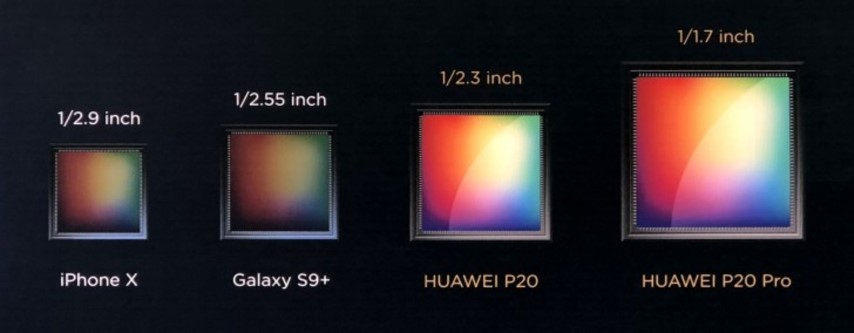
Таким образом, уже только по этим параметрам можно хорошо увидеть, насколько одна камера превосходит другую. Матрица размером 1/1.7″ способна выдать гораздо более качественный снимок (особенно в сложных условиях или при детальном рассмотрении).
С размером матрицы и пикселей связано очень много мифов и заблуждений. Даже некоторые профессиональные фотографы считают, что размер матрицы влияет на красивое размытие фона или на ощущение объема на снимках.
Другие уверены, что маленький пиксель всегда хуже большого, что также совершенно неверно. Если вы хотите разобраться в этих вопросах подробнее, тогда обязательно почитайте нашу новую статью о матрицах и пикселях в современных мобильных камерах (здесь также рассказано, как вообще понимать размер матрицы и что такое эти 1/1.7″ или 1/2.9″).
Типы и количество объективов
Прошли те времена, когда на смартфоне устанавливалась одна основная камера и одна фронтальная для селфи. На том же Samsung Galaxy S10+ установлено целых 5 камер, а на Nokia 9 PureView и того больше! Нужны ли все эти камеры или это очередной маркетинговый трюк?
Если отвечать кратко — да, нужны! И чем больше — тем лучше. Всего есть две причины для установки нескольких камер на одном смартфоне:
- Улучшить качество фотографии. В этом случае устанавливаются дополнительные монохромные камеры для лучшей детализации снимка, более широкого динамического диапазона и отсутствия шумов, также могут присутствовать различные сенсоры глубины для имитации размытия фона, как на зеркальных дорогих камерах.
- Дать больше свободы для творчества. Дополнительные камеры имеют разные объективы с разным фокусным расстоянием. Благодаря этому можно снимать качественные портретные фото на телеобъектив или красочные пейзажи на ультраширокоугольный объектив. О том, что такое фокусное расстояние и на что оно реально влияет, мы также рассказали в отдельном подробном материале. Поверьте, здесь не меньше мифов и заблуждений!
Вот пример двух фотографий, снятых с одного и того же места на разные объективы смартфона (телевик и широкоугольный):

Добиться такого эффекта лишь одной камерой попросту невозможно.
Вывод
Наличие нескольких камер с разными объективами иили разными сенсорами позволит вам получать более интересные и качественные фотографии. Бывают нередко случаи, когда сделать хороший кадр возможно исключительно на широкоугольный объектив (когда нужно захватить больше информации и нет возможности сделать снимок издалека) или телеобъектив (когда приблизиться к объекту съемки также нет возможности).
Что такое диафрагма (или апертура) камеры смартфона?
Свет попадает на матрицу камеры через небольшое отверстие объектива. Диафрагма как раз и сообщает нам о размере этого отверстия:
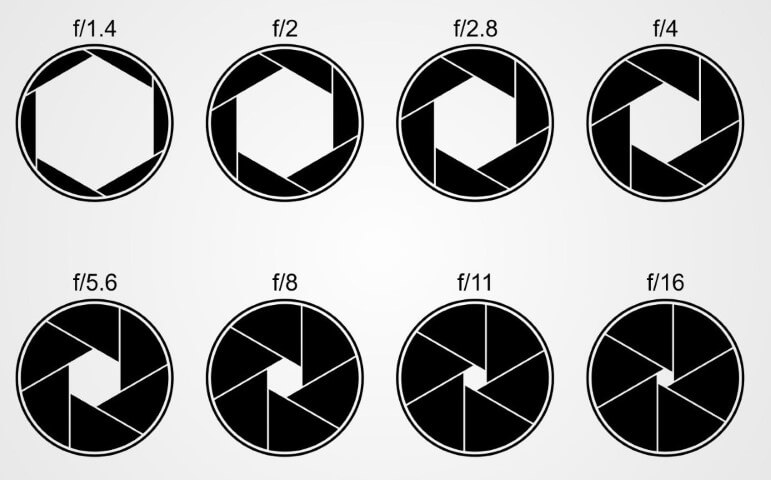
Лучше всего можно понять, как работает диафрагма, сравнив камеру смартфона с человеческим глазом. Свет попадает на сетчатку глаза (матрица камеры) через зрачок (объектив камеры). Чем ярче свет, тем сильнее сужается зрачок (диафрагма прикрывается) и наоборот, чем темнее вокруг — тем крупнее становится зрачок (диафрагма открывается).
Таким способом глаз контролирует количество света, попадающего на сетчатку, позволяя нам хорошо видеть как при ярком свете, так и при недостаточной освещенности.
За редким исключением диафрагма мобильных камер, в отличие от зеркальных фотоаппаратов, статична (то есть, размер отверстия не изменяется). Поэтому, желательно выбирать камеру с максимальной диафрагмой или, говоря другими словами, с наибольшим размером отверстия.
Указывается этот параметр в виде буквы f и числа: f/2.4 или f/1.9 (это так называемое диафрагменное число).
Чем меньше число после буквы f/ — тем больше отверстие в объективе, а значит и больше его светосила. Еще одним плюсом большой диафрагмы является эффект боке (красивое размытие фона). При идентичных прочих параметрах, камера с диафрагмой f/1.8 более предпочтительней камеры с диафрагмой f/2.8.
Вывод
Именно размер отверстия объектива, через который свет проникает в камеру (входной зрачок) — один из важнейших параметров камеры. Он влияет на количество шумов, производительность камеры при недостаточном освещении. Более того, размер диафрагмы — это единственный параметр камеры, влияющий на степень размытия фона (на глубину резкости).
Но проблема заключается в том, что диафрагменное число (f/2.8 или f/1.8) — это относительный параметр. То есть, может быть так, что размер отверстия f/1.8 на одном смартфоне будет крупнее, чем отверстие f/1.6 на другом.
Обо всем этом мы подробно рассказывали в статье о диафрагме мобильной камеры.
Что такое HDR-режим и зачем он нужен в современном смартфоне?
Одной из главных проблем любого компактного фотоаппарата является слишком маленький динамический диапазон камеры. Говоря простым языком, камера не способна передать все полутона от самого яркого до самого темного участка фотографии.
К примеру, если мы захотим запечатлеть Эйфелевую башню на фоне неба, тогда камера смартфона не сможет одновременно хорошо показать и башню и текстуру неба — где-то будет пересвет изображения, а где-то — завалы в тенях:

HDR-режим способен исправить эту ситуацию. Если в смартфоне поддерживается данная технология, в момент съемки практически одновременно будет сделано несколько снимков (один — чтобы увидеть текстуру неба, второй — деревья и саму башню), после чего программное обеспечение объединит полученную информацию в одну красочную фотографию.
Оптическая стабилизация изображения (OIS)
Когда в момент съемки вы держите смартфон в руках (вместо использования штатива или подставки), достаточно даже мельчайшего движения для того, чтобы «смазать» кадр. Если в солнечную погоду это не особо влияет на качество фото (так как скорость съемки очень высокая), то при недостаточной освещенности, когда камере смартфона может потребоваться, скажем, пол секунды, чтобы захватить достаточно света, картинка получится нечеткой.
При съемке видео без стабилизации изображение будет «дерганным» вне зависимости от количества света
Решением этой проблемы является наличие в камере технологии оптической стабилизации (OIS — optical image stabilization). Это позволяет не только снимать более плавные видео, но и увеличивает четкость фотографии при недостаточном освещении. Зачастую, принцип работы оптической стабилизации заключается в использовании подвижных линз или сенсора. Движение смартфона компенсируется движением линзсенсора внутри камеры в противоположную сторону.
Есть более дешевый и менее эффективный вариант — цифровая стабилизация, но относится она лишь к записи видео. В любом случае, цифровая стабилизация не является заменой оптической и при выборе камеры необходимо убедиться в наличии именно оптической стабилизации изображения.
Процессор
Скорее всего, последнее, что вы ожидали увидеть в этом списке — это процессор смартфона. Какое отношение он вообще имеет к фотографии? На самом деле, матрица, объектив, мегапиксели — все это очень важно, однако одну из ключевых ролей в современной мобильной фотографии играют алгоритмы.
Высокий динамический диапазон, красивое размытие фона при портретном режиме (боке), хорошее качество при ночной съемке и высокая детализация — все это является заслугой вычислительной фотографии и нейронных сетей.
Поэтому даже две идентичные по характеристикам камеры на разных смартфонах могут давать совершенно разный результат. Соответственно, чем более мощный процессор используется в смартфоне, тем более интересные алгоритмы могут быть применены во время работы камеры.
Общие выводы
Многие важные технологии, улучшающие качество фото и видео, присутствуют практически во всех современных смартфонах. Если еще во времена первых iPhone наличие того же автофокуса было экзотикой, то сегодня даже в бюджетных аппаратах используется оптическая стабилизация и многие другие недоступные ранее возможности.
В любом случае, вне зависимости от характеристик камеры, перед покупкой всегда следует посмотреть примеры снимков в интернете.
Также можно обратить внимание на поддерживаемые форматы записи видео. Некоторые камеры позволяют снимать в разрешении 4K с частотой 60 кадров в секунду. Изображение при такой частоте кадров очень четкое, даже самое быстрое движение в кадре не будет смазываться.
И последнее замечание. Если камера делает прекрасные фотографии, это совершенно не значит, что она будет также хорошо снимать и видео. Есть много примеров неплохих камерофонов, которые довольно плохо справляются со съемкой видео. Поэтому обязательно проверяйте на YouTube примеры съемки перед покупкой.
P.S. Не забудьте подписаться в Telegram на наш научно-популярный сайт о мобильных технологиях, чтобы не пропустить самое интересное!
В серии материалов мы подробно разбираем техническую сторону смартфонов. Мы уже писали про процессоры и дисплеи. Сегодня речь пойдет о камерах. Ведь смартфоны уже давно являются той самой «лучшей камерой», которая всегда с собой. Камера смартфона уже давно стала основной причиной для обновления. Мы поговорим о технических характеристиках камер и развеем конфузы вокруг светосилы, диагонали сенсора и автофокусировки, а еще расскажем, что такое HDR, OIS и DPAF.
Гонка мегапикселей продолжается
Компактные камеры PowerShot, Cybershot, Coolpix и прочие мыльницы остались в прошлом-позапрошлом десятилетии. Но это не значит, что старые уловки маркетологов не работают. Работают еще лучше, чем раньше. И камеры телефонов перевалили за 100 мегапикселей.
Пиксели — маленькие квадратные точки, из которых состоит любое цифровое изображение. Это его строительные блоки. Они располагаются в строках и столбцах, как на шахматной доске, только в сильно уменьшенном формате. Если камера снимает в разрешении 12 мегапикселей, это значит, что конечное изображение будет построено из 12 млн пикселей, или же разрешение картинки составит 12 мегапикселей. Например, соотношение сторон 4:3 позволяет уместить те самые 12 млн пикселей в табличке 4000 на 3000. Более высокое разрешение означает более четкую картинку. Ну, или что-то вроде этого.
Мы любим большие цифры, но еще больше их любят маркетологи. Еще в эпоху компактных цифровых камер мегапиксельные гонки сводили с ума подкованную часть аудитории. Не стоит вестись на большое разрешение камеры в мегапикселях: оно не гарантирует лучшего качества снимков. Роль также играет очень много других факторов. О них ниже.
Размер сенсора
Высокое качество изображения по результатам многих исследований — одна из основных причин, по которым фотография считается хорошей и нравится другим людям. Физический размер сенсора вносит в качество картинки основной вклад. Сегодняшний цифровой сенсор — по сути, вчерашняя пленка, но не требующая замены и проявки. Когда телефон делает снимок, свет проходит через объектив и попадает на светочувствительную матрицу. Смартфон захватывает этот световой сигнал и превращает его в изображение.
Чем больше размер сенсора, тем больше света на него попадает. Чем больше света на него попадает, тем лучше качество изображения.
Размер сенсора указывает на его физические габариты, но в цифрах габаритов сенсора легко запутаться. Традиционно производители указывают размер сенсора в долях дюйма, что обозначается знаком ″ в конце дроби. Какое-то время стандартом был сенсор 1/3″. Не влезая в детали, чем ближе дробь к полному дюйму (1″), тем больше сенсор.
Например, Samsung и Xiaomi уже пробуют использовать гораздо бо́льшие (соответственно, 1/1.33″) сенсоры в своих флагманах, близок к ним и Huawei P40 Pro с 1/1.54″. В iPhone 11 Pro используется меньший сенсор — 1/2.55″.
Чем больше размер сенсора, тем труднее уместить его в компактный корпус телефона вместе с оптикой. Современные телефоны уже близки к этому пределу.
По площади сенсора смартфоны даже в лучших случаях в десятки раз уступают зеркальным полноформатным камерам.
Размер пикселей сенсора
Этот параметр упоминается не очень часто, но также является важным в определении того, хороша или плоха мобильная камера.
Размер пикселя соотносится с физическим размером каждого отдельного пикселя на матрице. Их измеряют в микрометрах, или микронах, используя греческие буквы µm или просто µ. 1 миллиметр равен 1000 микрометрам. Чем больше пикселей умещает производитель в сенсор, тем меньше они будут. Это на самом деле не очень хорошо, потому что тут начинают играть квантовые эффекты и пиксели становятся более подверженными цифровому шуму, особенно при слабом освещении.
Более крупные пиксели, в свою очередь, могут собирать больше ценной световой информации и, таким образом, демонстрировать более качественную картинку при слабом освещении.
Сенсор с размером пикселя 1,7 микрометра будет значительно лучше при слабом свете, чем маленький пиксель размером 1,0 микрометра. Другими словами, сенсор 1/2.5″ с 12 мегапикселями на борту имеет более крупные пиксели, чем такой же сенсор, в который втиснули 20 мегапикселей. Это значит, что 12-мегапиксельный сенсор, скорее всего, обставит 20-мегапиксельный по качеству при слабом освещении. Однако 20-мегапиксельный сенсор даст больше разрешения при хорошем освещении.
Размер пикселя — это характеристика светочувствительной матрицы. Производители используют различные модели сенсоров в разных телефонах. Технологии производства полупроводниковых сенсоров постоянно улучшаются такими производителями, как Sony, OmniVision, Samsung и другие. Поэтому смартфоны каждого нового поколения при, казалось бы, прочих равных будут снимать лучше только благодаря новым матрицам.
Во флагманских моделях смартфонов можно найти самые современные сенсоры последних поколений c размером пикселей от 1,4 до 2,44 микрометра. На простых смартфонах размер пикселей может быть маленьким, около 0,8 микрона.
Хотя смартфоны с камерами на 64 мегапикселя и больше тоже неизбежно получают пиксели в 0,8 микрона. Но тут есть уловка: биннинг пикселей 4:1, объединяющий квадратик 2×2 из четырех 0,8-микронных пикселей в один большой 1,6-миллиметровый пиксель. В случае флагмана Samsung S20 Ultra биннинг на его 108-мегапиксельной матрице идет уже в соотношении 9:1 (квадрат 3×3), и мы получаем «суперпиксель» размером 2,4 микрона. Но даже эти пиксели меркнут перед размером пикселя полноформатной зеркальной камеры: там он составляет 8,4 микрона и может быть даже больше. Именно поэтому тепловые эффекты любой электроники будут еще более заметны на маленьких пикселях при попытке усилить сигнал, тогда как на больших пикселях вклад шумов в соотношение будет невелик.
Объектив и его фокусное расстояние
Световое излучение и весь видимый свет распространяются прямолинейно. Когда свет проходит через линзу, лучи в какой-то момент сходятся в одной точке. В обычных камерах расстояние от точки схождения лучей до сенсора называется фокусным расстоянием и изменяется в миллиметрах.
Разные объективы отличаются числом линз, оптической схемой и обладают разными фокусными расстояниями. Фокусное расстояние в Samsung Galaxy S10, например, составляет 26 миллиметров в эквиваленте, что типично для широкоугольной оптики. Она имеет широкий угол обзор, а значит, в одной фотографии камера захватит больше пространства.
Бо́льшие фокусные расстояния означают уменьшенный угол обзора и большее увеличение — это характерно для так называемых телеобъективов. В Samsung Galaxy S10, к примеру, фокусное расстояние телеобъектива в два раза больше широкоугольного модуля и составляет 52 миллиметра в эквиваленте. Это значит, что Samsung S10 обладает 2-кратным оптическим зумом.
Ультраширокоугольные объективы отличаются еще бо́льшим углом обзора и еще меньшим фокусным расстоянием. Например, в случае ультраширокоугольной камеры Samsung S10 оно составит всего 12 миллиметров в эквиваленте.
Не все смартфоны выпускаются с тремя камерами с разной оптикой. Большинство из них имеют одну, максимум две камеры.
Фокусное расстояние и углы обзора камер отличаются у разных моделей смартфонов и производителей.
Обратите внимание, что фокусное расстояние камеры смартфона (например, 26 миллиметров) не является физическим расстоянием от точки схождения лучей до матрицы камеры смартфона. Смартфоны слишком маленькие для таких расстояний (иначе они не поместились бы даже в нашей руке), и это всего лишь визуальный эквивалент популярных 35-миллиметровых камер пленочной эпохи.
Объектив и его зум
Обычно во флагманском смартфоне сейчас три камеры: телефотообъектив, широкоугольная и ультраширокоугольная линза. Все эти объективы отличаются фокусным расстоянием и углом обзора. Когда вы зумируете на телефоне, он автоматически переключается между линзами, которые дадут нужную картинку. Ведь реализовывать на практике один объектив с зумом было бы глупо: он был бы темнее, не выдержал бы и единого падения, требовал бы скрупулезного ремонта.
Если вы захотите «отзумить» с основной камеры, телефон переключится на ультраширокоугольную. Если захотите «зазумить», телефон автоматически переключится на телеобъектив. Насколько сильно вы можете увеличить картинку, определяется телеобъективом камеры.
Оптический зум сохраняет качество картинки. Цифровой зум в последние годы стал сильно лучше, но все равно это не реальность, а цифровая симуляция оптического зума. В худшем случае детали будут просто размазаны, в лучшем — дорисованы алгоритмами. Камера просто обрежет картинку и затем растянет ее до размера изначального кадра.
Цифровой зум, по сути, единственная причина, по которой производители запаковывают в свои телефоны столько много мегапикселей. Он дает нам иллюзию увеличения.
Производитель и указание знаменитых брендов, таких как Zeiss и Leica, по сути, не говорит ни о чем, кроме кооперации брендов на уровне маркетинга и идей.
Объективы смартфонов могут производиться из пластика китайских вендоров и по чертежам немцев, а основной упор в коллаборации и вовсе может быть сделан на алгоритмы обработки сигнала и получение фирменных цвета и текстуры изображений модных камер.
Объектив и его светосила
Как правило, светосила — это изменяемая характеристика объектива. Она касается диафрагмы — круглого отверстия, которое может меняться в диаметре и тем самым уменьшать/увеличивать световой поток, который проходит к сенсору. Чем шире диафрагма, тем больше света попадет на сенсор, чем у́же, тем, соответственно, меньше света доходит до сенсора.
Степень открытости диафрагмы (опустим математические выкладки) измеряется в F-стопах. Низкий F-стоп (например, f/2) означает более открытую диафрагму. Чем больше цифра в F-стопе (например, f/8), тем у́же отверстие и тем меньше света проходит через объектив к сенсору.
В начале мы написали «как правило». Ведь в смартфонах, в отличие от обычных камер, диафрагма обычно фиксирована, и светосила отличается от телефона к телефону. Некоторые телефоны получают камеры со светосилой f/1.7, некоторые получают f/2.2 или даже f/1.4.
Причина, по которой смартфоны получают светосильные объективы, проста: критически важно, чтобы на микроскопическую оптику камеры и светочувствительный сенсор попадало как можно больше света. Это же позволяет ему лучше «видеть» в неблагоприятных условиях съемки.
Однако некоторые смартфоны получают фотомодели со сменной диафрагмой: например, Samsung S10 умеет снимать как при f/1.5, так и при f/2.4. При некоторых условиях (избыток освещения) закрытая диафрагма может уменьшать виньетирование по краям кадра, а также увеличивать резкость изображения. Можете проверить этот эффект сами, просто посмотрев через отверстие в ремешке своих часов.
Объектив как на подводной лодке — с перископом
Последние смартфоны Samsung и Huawei получили модули с большим оптическим зумом.
Этого удалось добиться только благодаря конструкции перископа, как в подводной лодке. Самая длинная часть оптической схемы таких камер лежит перпендикулярно внешней линзе внутри корпуса смартфона, потому что в прямую линию она бы просто не уместилась в худеньком корпусе современного телефона. Лучи на 90 градусов поворачивает или призма, или зеркало. Именно перископ позволил Samsung S20 и Huawei P30 Pro добиться оптического зума.
Автофокус
Автофокус описывает способность камеры смартфона добиться резкого изображения на любых расстояниях до объекта съемки.
- Автофокусировка по контрасту (CDAF).
- Лазерный автофокус.
- Фазодетектный автофокус (PDAF).
- Автофокус по модели Dual Pixel.
Автофокусировка по контрасту (CDAF)
Это наиболее популярный тип фокусировки, и он используется в большинстве камер смартфонов — настолько часто, что его просто указывают как «автофокус». Но это не самая совершенная технология.
C автофокусом по контрасту камера смартфона перемещает объектив вперед-назад, пока не найдет точку, в которой изображение отличается наивысшей контрастностью.
То есть то положение, когда границы между объектами в кадре наиболее резкие, и будет самым контрастным изображением. И хотя этот метод дает отличные результаты по точности, он может быть медленным и с трудом наводиться на резкость при слабом освещении или на однородных объектах.
Видели, когда резкость картинки на телефоне «рыскала» туда-сюда и отказывалась давать резкую картинку? Это наш друг автофокус по контрасту не смог справиться со сценой.
Лазерный автофокус
Это не такая популярная технология фокусировки, но она все чаще используется в современных смартфонах. Телефон освещает сцену пучком инфракрасных лучей и замеряет время, которое потребовалось им, чтобы отразиться обратно в камеру. По времени она определяет расстояние до объекта. Исходя из этого простого расчета, камера фокусируется на рассчитанную дистанцию и гарантированно попадает в резкость.
Лазерный автофокус отличается высокой скоростью и может работать в темноте. К сожалению, ИК-излучатель используется довольно слабый, и на длинные дистанции он не добивает, максимум на 1,5 метра. Наиболее эффективно он работает при макросъемке и съемке на близких дистанциях.
Фазовая автофокусировка (PDAF)
Топовые производители смартфонов используют эту систему автофокусировки в своих флагманских устройствах из-за скорости и эффективности. На эту же систему автофокусировки полагаются производители в топовых репортажных зеркальных камерах.
С фазовой автофокусировкой небольшое количество реальных пикселей на сенсоре смартфона (2—5%) убрано и замещено на фазодетектные фотодиоды — особые пиксели, созданные специально для нужд автофокусировки. Используя сигнал с этих микродатчиков, алгоритм и может рассчитать, резкое ли изображение, и сразу знает, на какую дистанцию нужно сфокусироваться. То есть фокусировка может корректироваться из текущего положения объектива на лету и без «рысканья». Впрочем, на однородных поверхностях у фокусировки по фазам тоже могут быть затруднения.
Фокусировка Dual Pixel (DPAF)
Эта технология была первой придумана Canon и разбивала все пиксели на подпиксели, которые работали в парах и обеспечивали упомянутую выше фазовую фокусировку. Но по сути это улучшение технологии фазовой автофокусировки. Если в том случае используется не более 5% площади пикселей для фокусировки, то в случае Dual Pixel для автофокусировки можно использовать все 100% из-за специальной микроархитектуры пикселей. Это означает высокую скорость и точность фокусировки, потому что как только хотя бы одна пара из миллионов пикселей уверенно подтвердит наводку на резкость, остальные подхватят.
Оптическая стабилизация
Оптическая стабилизация, или Optical Image Stabilization (OIS), указывается в характеристиках многих топовых смартфонов. Другие телефоны могут иметь в описании камеры аббревиатуру EIS, что означает Electronic Image Stabilization — электронная стабилизация изображения.
OIS — довольно устоявшаяся технология, которая зарекомендовала себя еще в эпоху до смартфонов, но набирает популярность и в мобильниках. По сути, оптическая стабилизация — это компенсационный сдвиг отдельных линз или сенсора в противовес естественному сотрясению камеры в ваших руках. Это такой миниатюрный амортизатор, чтобы сохранить камеру максимально неподвижной в краткое мгновение съемки.
Стабилизатор помогает побороть размытость снимков и сделать фотографии более резкими. Минусы — это дополнительные тонкости производства и дополнительно занятое место в корпусе смартфона.
Электронная стабилизация изображения — не механическая, а программная функция. Этот способ задействует информацию со встроенного в любой смартфон гироскопического сенсора или путем отслеживания определенных точек на изображении/видео. После этого изображение анализируется, а ненужные сдвиги компенсируются или обрезаются по записям гироскопа. Электронная стабилизация особенно хорошо зарекомендовала себя при съемке видео, при съемке же фотографий ее преимущества сомнительны и идут рука об руку вместе с потерей качества.
Сенсор глубины (Depth Sensor, ToF Camera, ToF 3D Camera)
Сенсор глубины — маленький помощник многокамерных смартфонов, благодаря которому они могут снимать с небольшой глубиной резкости кадра и размытым фоном.
Основная камера работает вместе с датчиком глубины, который создает карту объема пространства. Так как обе камеры смотрят на сцену с немного разными перспективами, система может вычислить расстояние между объектами на картинке и отделить объекты переднего плана от фона. Она также используется при распознавании лиц (и для разблокировки лицом) и для автофокуса в слабом свете.
ToF-камера, или Time-of-Flight, работает по тому же принципу, что и лазерный автофокус. ToF-камера использует инфракрасную сетку точек, чтобы собрать данные об объеме сцены и расстоянии до объектов. А расстояние она замеряет по времени, которое нужно свету, чтобы отразиться от объектов сцены и вернуться в объектив.
HDR
HDR позволяет снимать изображения с широким динамическим диапазоном, то есть равномерной детализацией в очень темных и очень ярких участках кадра. С включенным HDR камера делает несколько снимков с разной яркостью.
После этого изображения собираются в конечную картинку, но из них берутся лишь части с наилучшей детализацией: отдельно светлые участки, отдельно темные, отдельно средние тона.
Вспышка
В смартфонах используются разные типы вспышек. Наиболее популярная — светодиодная вспышка, или LED. Эта вспышка использует высокоэффективные светодиоды, которые также могут работать в роли постоянного источника света при съемке видео.
Dual LED — вспышки используют два светодиода с разной цветовой температурой. В этом случае телефон определяет необходимую цветовую температуру или тон (теплее/холоднее) в зависимости от баланса белого в кадре, чтобы дать более естественный по атмосфере кадра цвет. Другие варианты LED-вспышек могут включать и четыре светодиода. Удивительно, но принципами работы True Tone — вспышки Apple не позволяет управлять даже разработчикам App Store.
Иногда можно встретить ксеноновые вспышки, они более мощные и с лучшими спектральными характеристиками света, но требуют больше энергии и не могут использоваться в качестве фонарика или при съемке видео.
Видео
Разрешение видео указывает на число пикселей, которое дисплей может демонстрировать по каждой стороне:
- 2160p — это 4K;
- 1080p — это Full HD;
- 720p — это HD.
Число типа @24p указывает на число кадров в секунду, которое возможно при этом разрешении съемки. Например, 4K@24p означает, что видеозапись будет идти в 4K с частотой 24 кадра в секунду. Чем больше кадров в секунду указывается производителем, тем более плавным будет видеоряд. Сейчас смартфоны без проблем снимают видео частотой 60 к/c.
Высокая частота кадров, например 960 к/c, идеально подходит для замедленных видео. На такой частоте можно рассматривать в деталях самые быстротечные, забавные и нелепые процессы.
Процессор обработки сигнала (ISP) и невидимые алгоритмы вычислительной фотографии
Чтобы компенсировать свои недостатки, камеры телефона полагаются на вычислительную фотографию, то есть алгоритмы и хитрости обработки сигнала могут вносить более существенный вклад в качество картинки, чем физическая начинка. Создание изображения не заканчивается на сенсоре и объективе, оно там только начинается.
Хорошим примером этого можно считать ночной режим съемки, набирающий сейчас популярность во флагманах. Смартфоны не очень хорошо (как вы поняли, ужасно) подходят для съемки при слабом свете: сенсоры небольшие, пиксели ужасно маленькие. Так как с этим ничего не поделаешь без превращения телефона в громадину, смартфонам приходится хитрить, благо вычислительные мощности современных телефонов кладут на лопатки некоторые компьютеры.
За качество изображения отвечает специальный процессор обработки сигнала (ISP) — мозг мобильной камеры. Он перехватывает на себя весь поток массива данных с сенсора. Прежде чем мы получим конечную картинку, он проведет триллионы манипуляций.
Они включают демозаику байеровской структуры сенсора, «вычисление» цвета пикселей, подавление шумов, коррекцию теней и светов, выделение однородных зон и дополнительную очистку их от шума, исправление искажений оптики, ретушь телесных тонов, создание HDR, особые алгоритмы съемки в ночном режиме, электронную стабилизацию, цветокоррекцию, сжатие и много чего еще. Также нейронные алгоритмы ISP натренированы огромной базой данных и сверяют цвета картинки с наиболее оптимальными.
В отличие от механического затвора, электронный затвор камеры может кодироваться на самые невероятные комбинации для сбора серии кадров: брекетинг экспозиции, по времени, движению и много чего еще доступно нам благодаря светлым умам инженеров.
В этом плане наиболее продвинулись инженеры Google и Apple, но не перестают удивлять Samsung и Huawei. К радости всех мобильных фотографов, жесткая конкуренция продолжается. Но конкретных метрик тут нет: читайте отзывы, снимайте сами и смотрите, насколько камера понимает ваши мысли при съемке. Если кажется, что смартфон понимает вас без слов даже в сложных условиях, берите смело и снимайте на радость.
Продолжение следует.
Читайте также:
- iPhone или Samsung? Протестировали Galaxy S20 Ultra
- Почему ядерные батарейки так и не стали популярны? История почти забытой технологии
- Apple, Huawei, Samsung, Honor или Xiaomi? Послушали и сравнили компактные наушники
Хроника коронавируса в Беларуси и мире. Все главные новости и статьи здесь
Наш канал в Telegram. Присоединяйтесь!
Быстрая связь с редакцией: читайте паблик-чат Onliner и пишите нам в Viber!
Самые оперативные новости о пандемии и не только в новом сообществе Onliner в Viber. Подключайтесь
Перепечатка текста и фотографий Onliner без разрешения редакции запрещена. nak@onliner.by
Camera phones allow instant, automatic photo sharing. There is no need for a cable or removable card to connect to a desktop or laptop to transfer photos.
A camera phone is a mobile phone which is able to capture photographs and often record video using one or more built-in digital cameras. It can also send the resulting image wirelessly and conveniently. The first commercial phone with color camera was the Kyocera Visual Phone VP-210, released in Japan in May 1999.[1]
Most camera phones are smaller and simpler than the separate digital cameras. In the smartphone era, the steady sales increase of camera phones caused point-and-shoot camera sales to peak about 2010 and decline thereafter.[2] The concurrent improvement of smartphone camera technology, and its other multifunctional benefits, have led to it gradually replacing compact point-and-shoot cameras.[3]
Most modern smartphones only have a menu choice to start a camera application program and an on-screen button to activate the shutter.[4] Some also have a separate camera button, for quickness and convenience. A few such as the 2009 Samsung i8000 Omnia II have a two-level shutter button as in dedicated digital cameras.[5] Some camera phones are designed to resemble separate low-end digital compact cameras in appearance and to some degree in features and picture quality, and are branded as both mobile phones and cameras—an example being the 2013 Samsung Galaxy S4 Zoom.
The principal advantages of camera phones are cost and compactness; indeed for a user who carries a mobile phone anyway, the addition is negligible. Smartphones that are camera phones may run mobile applications to add capabilities such as geotagging and image stitching. Also, modern smartphones can use their touch screens to direct their camera to focus on a particular object in the field of view, giving even an inexperienced user a degree of focus control exceeded only by seasoned photographers using manual focus. However, the touch screen, being a general purpose control, lacks the agility of a separate camera’s dedicated buttons and dial(s).
Starting in the mid-2010s, some advanced camera phones feature optical image stabilisation (OIS), larger sensors, bright lenses, 4K video and even optical zoom, for which a few use a physical zoom lens. Multiple lenses and multi-shot night modes are also familiar.[6] Since the late 2010s, high-end smartphones typically have multiple lenses with different functions, to make more use of a device’s limited physical space. Common lens functions include an ultrawide sensor, a telephoto sensor, a macro sensor, and a depth sensor. Some phone cameras have a label that indicates the lens manufacturer, megapixel count, or features such as autofocus or zoom ability for emphasis, including the Samsung Omnia II (2009), Samsung Galaxy S II (2011), Sony Xperia Z1 (2013) and some successors, Nokia Lumia 1020 (2013), and the Samsung Galaxy S20 (2020).
Technology[edit]
Camera[edit]
Mobile phone cameras typically feature CMOS active-pixel image sensors (CMOS sensors) due to largely reduced power consumption compared to charge-coupled device (CCD) type cameras, which few camera phones use[citation needed]. Some use CMOS back-illuminated sensors, which use even less energy, at higher price than CMOS and CCD.
The usual fixed-focus lenses and smaller sensors limit performance in poor lighting. Lacking a physical shutter, some have a long shutter lag. Photoflash by the typical internal LED source illuminates less intensely over a much longer exposure time than a flash strobe, and none has a hot shoe for attaching an external flash. Optical zoom[7] and tripod screws are rare and some also lack a USB connection or a removable memory card. Most have Bluetooth and WiFi, and can make geotagged photographs. Some of the more expensive camera phones have only a few of these technical disadvantages, but with bigger image sensors (a few are up to 1″, such as the Panasonic Lumix DMC-CM1), their capabilities approach those of low-end point-and-shoot cameras. The few hybrid camera phones such as Samsung Galaxy S4 Zoom and K Zoom were equipped with real optical zoom lenses.

Samsung Galaxy S5 camera module, with floating element group suspended by ceramic bearings and a small magnet

Image showing the six molded elements in the Samsung Galaxy S5
As camera phone technology has progressed, lens design has evolved from a simple double Gauss or Cooke triplet to many molded plastic aspheric lens elements made with varying dispersion and refractive indexes. Some phone cameras also apply distortion (optics), vignetting, and various optical aberration corrections to the image before it is compressed into a JPEG format.
Optical image stabilization allows longer exposures without blurring, despite trembling. The earliest known smartphone to feature it on the rear camera is in late 2012 on the Nokia Lumia 920, and the first known front camera to feature one is on the HTC 10 from early 2016.[8][9]
Few smartphones such as LG initially with the 2014 G3 are equipped with a time-of-flight camera with infrared laser beam assisted auto focus. A thermal imaging camera has initially been implemented in 2016 on the Caterpillar S60.
High dynamic range imaging merges multiple images with different exposure values for a balanced brightness across the image and was first implemented in early 2010s smartphones such as the Samsung Galaxy S III and iPhone 5. The earliest known smartphone to feature high dynamic range filming is the Sony Xperia Z, 2013, where frames are arrayed by changing the exposure every two lines of pixels to create a spatially varying exposure (SVE).[10][11]
As of 2019, high-end camera phones can produce video with up to 4K resolution at 60 frames per second for smoothness.[12]
Zooming[edit]
Most camera phones have a digital zoom feature, which may allow zooming without quality loss if a lower resolution than the highest image sensor resolution is selected, as it makes use of image sensors’ spare resolution. For example, at twice digital zoom, only a quarter of the image sensor resolution is available. A few have optical zoom, and several have a few cameras with different field of view, combined with digital zoom as a hybrid zoom feature. For example, the Huawei P30 Pro uses a «periscope» 5x telephoto camera with up to 10x digital zoom, resulting in 50x hybrid zoom.[13] An external camera can be added, coupled wirelessly to the phone by Wi-Fi. They are compatible with most smartphones. Windows Phones can be configured to operate as a camera even if the phone is asleep.
Physical location[edit]
When viewed vertically from behind, the rear camera module on some mobile phones is located in the top center, while other mobile phones have cameras located in the upper left corner. The latter has benefits in terms of ergonomy due to the lower likelihood of covering and soiling the lens when held horizontally, as well as more efficient packing of tight physical device space due to neighbouring components not having to be built around the lens.
Image format and mode[edit]
Images are usually saved in the JPEG file format. Since the mid-2010s, some high-end camera phones have a RAW photography feature, HDR, and «Bokeh mode». Phones with Android 5.0 Lollipop[14][15] and later versions can install phone apps that provide similar features.
Since iOS 11 (HEIC), Android 8 (Oreo) (HEIF), Android 10 (HEIC) and Android 12 (AVIF), HEIC and AVIF compression formats in HEIF container format are available.[16][17][18] HEIC support on Android requires hardware support.[18]
Audio recording[edit]
Mobile phones with multiple microphones usually allow video recording with stereo audio. Samsung, Sony, and HTC initially implemented it in 2012 on their Samsung Galaxy S3, Sony Xperia S, and HTC One X.[19][20][21] Apple implemented stereo audio starting with the 2018 iPhone Xs family and iPhone XR.[22]
Files and directories[edit]
Like dedicated (stand-alone) digital cameras, mobile phone camera software usually stores pictures and video files in a directory called DCIM/ in the internal memory, with numbered or dated file names. The former prevents missing out files during file transfers and facilitates counting files, whereas the latter facilitates searching files by date/time, regardless of file attribute resets during transfer and possible lack of in-file metadata date/time information .[23][24]
Some can store this media in external memory (secure digital card or USB on the go pen drive).
Multimedia Messaging Service[edit]

A camera phone sending a photo taken by it using MMS
Camera phones can share pictures almost instantly and automatically via a sharing infrastructure integrated with the carrier network. Early developers including Philippe Kahn envisioned a technology that would enable service providers to «collect a fee every time anyone snaps a photo».[25] The resulting technologies, Multimedia Messaging Service (MMS) and Sha-Mail, were developed parallel to and in competition to open Internet-based mobile communication provided by GPRS and later 3G networks.
The first commercial camera phone complete with infrastructure was the J-SH04, made by Sharp Corporation; it had an integrated CCD sensor, with the Sha-Mail (Picture-Mail in Japanese) infrastructure developed in collaboration with Kahn’s LightSurf venture, and marketed from 2001 by J-Phone in Japan today owned by Softbank. It was also the world’s first cellular mobile camera phone. The first commercial deployment in North America of camera phones was in 2004. The Sprint wireless carriers deployed over one million camera phones manufactured by Sanyo and launched by the PictureMail infrastructure (Sha-Mail in English) developed and managed by LightSurf.
While early phones had Internet connectivity, working web browsers and email-programs, the phone menu offered no way of including a photo in an email or uploading it to a web site. Connecting cables or removable media that would enable the local transfer of pictures were also usually missing. Modern smartphones have almost unlimited connectivity and transfer options with photograph attachment features.
External camera[edit]
During 2003 (as camera phones were gaining popularity), in Europe some phones without cameras had support for MMS and external cameras that could be connected with a small cable or directly to the data port at the base of the phone. The external cameras were comparable in quality to those fitted on regular camera phones at the time, typically offering VGA resolution.
One of these examples was the Nokia Fun Camera (model number PT-3) announced together with the Nokia 3100 in June 2003.[26] The idea was for it to be used on devices without a built-in camera (connected via the Pop-Port interface) and be able to transfer images taken on the camera (VGA resolution and a flash) directly to the phone to be stored or sent via MMS.[27]
In 2013-2014 Sony and other manufacturers announced add-on camera modules for smartphones called lens-style cameras. They have larger sensors and lenses than those in a camera phone but lack a viewfinder, display and most controls. They can be mounted to an Android or iOS phone or tablet and use its display and controls. Lens-style cameras include:
- Sony SmartShot QX series, announced and released in mid 2013. They include the DSC-QX100/B,[28] the large Sony ILCE-QX1, and the small Sony DSC-QX30.
- Kodak PixPro smart lens camera series, announced in 2014.[29]
- Vivicam smart lens camera series from Vivitar/Sakar, announced in 2014.[30]
- HTC RE HTC also announced an external camera module for smartphones, which can capture 16 MP still shots and Full HD videos. The RE Module is also waterproof and dustproof, so it can be used in a variety of conditions.[31]
External cameras for thermal imaging also became available in late 2014.[32]
Microscope attachments were available from several manufacturers in 2019,[33] as are adapters for connecting an astronomical telescope.[34]
Limitations[edit]
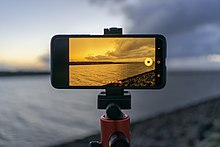
Camera phone clamped to a tripod
- Mobile phone form factors are small. They lack space for a large image sensor and dedicated knobs and buttons for easier ergonomy.
- Controls work by a touchscreen menu system. The photographer must look at the menu instead of looking at the target.
- Dedicated cameras have a compartment housing the memory card and battery. For most it is easily accessible by hand, allowing uninterrupted operation when storage or energy is exhausted (hot swapping). Meanwhile, the battery can be charged externally. Most mobile phones have a non-replaceable battery and many lack a memory card slot entirely. Others have a memory card slot inside a tray, requiring a tool for access.
- Mobile phone operating systems are not able to boot immediately like the firmwares of dedicated digital cameras/camcorders,[35] and are prone to interference from processes running in background.
- Dedicated digital cameras, even low-budget ones, are typically equipped with a photoflash capacitor-discharging Xenon flash, larger and by far more powerful than LED lamps found on mobile phones.[36]
- Due to the default orientation of mobile phones being vertical, inexperienced users might intuitively be encouraged to film vertically, making a portrait mode poorly suited to the usual horizontal screens used at home.
- Due to their comparatively thin form factor, smartphones are typically unable to stand upright on their own and must be leaned, whereas dedicated digital cameras and camcorders typically have a flat bottom that lets them stand upright.
- Smartphones lack dedicated stable tripod mounts, and can only be mounted through a less stable device that grips the unit’s edges.
Software[edit]
Users may use bundled camera software, or install alternative software. Bundled software may be optimized by the vendor for performance, whereas alternative software may offer functionality and controls and customization missing in bundled software.[37]
The graphical user interface typically features a virtual on-screen shutter button located towards the usual home button and charging port side, and a thumbnail previewing the last photo, and some status icons that may display settings such as selected resolution, scene mode, stabilization, flash, and a battery indicator. The camera software may indicate the estimated number of remaining photographs until exhausted space, the current video file size, and remaining space storage while recording, as done on early-2010s Samsung smartphones. Shortcuts to settings in the camera viewfinder may be customizable.[38][39][40]

This layout of the camera viewfinder was first introduced by Apple with iOS 7 in 2013. Towards the late 2010s, several other smartphone vendors have ditched their layout and implemented variations of this layout.
In September 2013, Apple introduced a camera viewfinder layout with iOS 7 that would be implemented by several other major vendors towards the late 2010s. This layout has a circular and usually solid-colour shutter button and a camera mode selector using perpendicular text and separate camera modes for photo and video. Vendors that have ditched their layout to implement variations of Apple’s layout include Samsung, Huawei, LG, OnePlus, Xiaomi, and UleFone.[41]
There may be an option to utilize volume keys for photo, video, or zoom.[42] Specific objects can usually be focused on by tapping on the viewfinder, and exposure may adjust accordingly; there may be an option to capture a photo with each tap.[43]
Exposure value may be adjustable by swiping vertically after tapping to focus or through a separate menu option. It may be possible to lock focus and exposure by holding the touch for a short time, and exposure value may remain adjustable in this state.[44][45] These gestures may be available while filming and for the front camera.
Retaining focus also has in the past been implemented through holding the virtual shutter button.[46] Another common use of holding the shutter button is burst shot, where multiple photos are captured in quick succession, with varying resolutions, speeds, and sequential limits among devices, and possibly with an option to adjust between speed and resolution.[47]
Shutter lag varies depending on computing speed, software implementation, and environmental brightness.[48] A shutter animation such as skeuomorphic aperture diaphragm blades or a simple short black-out may be featured.[49] A haptic (vibration) feedback may be used to signify a captured photograph, which is of use when holding the smartphone in an angle with poor visibility of the screen.[50]
Lock screens typically allow the user to launch the camera without unlocking to prevent missing moments. This may be implemented through an icon swiped away from. Launching from anywhere may be possible through double-press of power/stand-by or home button, or a dedicated shutter button if present.[51][52][53]
Camera software on more recent and higher-end smartphones (e.g. Samsung since 2015) allows for more manual control of parameters such as exposure and focus. This was first featured in 2013 on the camera-centric Samsung Galaxy S4 Zoom and Nokia Lumia 1020, but was later expanded among smartphones.[54][55] Few smartphones’ bundled camera software such as that of the LG V10 features an image histogram, a feature known from higher-end dedicated cameras.[56]
Video recording[edit]
Video recording may be implemented as a separate camera mode, or merged on the first viewfinder page as done since the Samsung Galaxy S4 until the S9.[42][57] Specific resolutions may be implemented as separate camera mode, like Sony has done with 4K (2160p) on the Xperia Z2.[58]
During video recording, it may be possible to capture still photos, possibly with a higher resolution than the video itself. For example, the Samsung Galaxy S4 captures still photos during video recording at 9.6 Megapixels, which is the largest 16:9 aspect ratio crop of the 13-Megapixel 4:3 image sensor.[38]
Parameters adjustable during video recording may include flashlight illumination, focus, exposure, light sensitivity (ISO), and white balance. Some settings may only be adjustable while idle and locked while filming, such as light sensitivity and exposure on the Samsung Galaxy S7.[59][60][61]
Recording time may be limited by software to fixed durations at specific resolutions, after which recording can be restarted. For example, 2160p (4K) recording is capped to five minutes on Samsung flagship smartphones released before 2016, ten minutes on the Galaxy Note 7, four minutes on the Galaxy Alpha, and six minutes on the HTC One M9. The camera software may temporarily disable recording while a high device temperature is detected.[62]
«Slow motion» (high frame rate) video may be stored as real-time video which retains the original image sensor frame rate and audio track, or slowed down and muted. While the latter allows slow-motion playback on older video player software which lacks playback speed control, the former can act both as real-time video and as slow-motion video, and is preferable for editing as the playback speed and duration indicated in the video editor are real-life equivalent.[63]
[edit]
Camera settings may appear as a menu on top of an active viewfinder in the background, or as a separate page, the former of which allows returning to the viewfinder immediately without having to wait for it to initiate again. The settings may appear as a grid or a list.[64] On Apple iOS, some camera settings such as video resolution are located separately in the system settings, outside the camera application.[65]
The range of selectable resolution levels for photos and videos varies among camera software. There may be settings for frame rate and bit rate, as on the LG V10, where they are implemented independently within a supported pixel rate (product of resolution and frame rate).[60][61]
When the selected photo or video resolution is below that of the image sensor, digital zooming may allow limited magnification without quality loss by cropping into the image sensor’s spare resolution. This is known as «lossless digital zoom». Zooming is typically implemented through pinch and may additionally be controllable through a slider. On early-2010s Samsung Galaxy smartphones, a square visualizes the magnification.
Other functionality[edit]
- Capturing in both directions
The ability to take photographs and film from both front and rear cameras simultaneously was first implemented in 2013 on the Samsung Galaxy S4, where the two video tracks are stored picture-in-picture.[42] An implementation with separate video tracks within a file or separate video files is not known yet.
- Voice commands
Voice commands were first featured in 2012 on the camera software of the Samsung Galaxy S3, and the ability to take a photo after a short countdown initiated by hand gesture was first featured in 2015 on the Galaxy S6.[66][67]
- Camera controls
Camera software may allow locking and unlocking touch input using the power button to prevent accidentally exiting or otherwise undesirably interfering with the viewfinder while recording video or keeping the camera idle in pocket for quicker access.[68][better source needed]
Camera software may have an option for automatically capturing a photograph or video when launched.[47]
- «Live photo» / «Motion photo»
Some smartphones since the mid-2010s have the ability to attach short videos surrounding or following the moment to a photo. Apple has branded this feature as «live photo», and Samsung as «motion photo».[69][70]
- Remote viewfinder
A «remote viewfinder» feature has been implemented into few smartphones’ camera software (Samsung Galaxy S4, S4 Zoom, Note 3, S5, K Zoom, Alpha), where the viewfinder and camera controls are cast to a supported device through WiFi Direct.[71]
- High dynamic range (HDR)
High-dynamic-range imaging, also referred to as «rich tone», keeps brightness across the image within a visible range. Camera software may have an option for turning HDR off, to avoid possible shutter lag and ghosting. Some software allows retaining both HDR and non-HDR variants of the same photo. HDR may be supported for panorama shots and video recording, if supported by the image sensor.[72][73]
- Visual effects and low light
The camera effects introduced by Samsung on the Galaxy S3 or S4 including «best photo» which automatically picks a photo and «drama shot» for multiplying moving objects and «eraser» which can remove moving objects, were merged to «shot & more» on the Galaxy S5, allowing retrospectively applying them to a burst of eight images stored in a single file.[74]
In 2014, HTC implemented several visual effect features as part of their dual-camera setup on the One M8, including weather, 3D tilting, and focus adjustment after capture, branded «uFocus». The last was branded «Selective Focus» by Samsung, additionally with the «pan focus» option to make the entire depth of field appear in focus.[75]
Huawei has branded a dedicated camera feature for prolonged exposure «light painting», as the long exposure time allows creating trails of objects that emit light.[76] A «handheld night shot» mode tries compositing a picture as clear as possible from many frames captured in a dark environment throughout several seconds. The user is instructed to hold the unit as steady as possible.[77]
- Object tracking
The earliest known smartphone to feature an autofocus with the ability from dedicated camcorders to track objects is the Galaxy S6.[78]
- Augumented reality
Starting in 2013 on the Xperia Z1, Sony experimented with real-time augmented reality camera effects such as floating text, virtual plants, volcano, and a dinosaur walking in the scenery.[79] Apple later did similarly in 2017 with the iPhone X.[80]
- Artificial intelligence
An artificial intelligence that notifies of flaws after each photograph such as blinking eyes, misfocus, blur, and shake, was first implemented in 2018 on the Samsung Galaxy Note 9.[81] Later phones from other manufacturers have more advanced IA features.[82]
History[edit]

The J-SH04, developed by Sharp and released by J-Phone in 2000, was the first mass-market camera phone.
The camera phone, like many complex systems, is the result of converging and enabling technologies. Compared to digital cameras, a consumer-viable camera in a mobile phone would require far less power and a higher level of camera electronics integration to permit the miniaturization.
The metal-oxide-semiconductor (MOS) active pixel sensor (APS) was developed by Tsutomu Nakamura at Olympus in 1985.[83] The complementary MOS (CMOS) active pixel sensor (CMOS sensor) «camera-on-a-chip» was later developed by Eric Fossum and his team in the early 1990s. This was an important step towards realizing the modern camera phone as described in a March 1995 Business Week article. While the first camera phones (e.g. J-SH04) successfully marketed by J-Phone in Japan used charge-coupled device (CCD) sensors rather than CMOS sensors, more than 90% of camera phones sold today[when?] use CMOS image sensor technology.[citation needed]
Another important enabling factor was advances in data compression, due to the impractically high memory and bandwidth requirements of uncompressed media.[84] The most important compression algorithm is the discrete cosine transform (DCT),[84][85] a lossy compression technique that was first proposed by Nasir Ahmed while he was working at the University of Texas in 1972.[86] Camera phones were enabled by DCT-based compression standards, including the H.26x and MPEG video coding standards introduced from 1988 onwards,[85] and the JPEG image compression standard introduced in 1992.[87][88]
Experiments[edit]
There were several early videophones and cameras that included communication capability. Some devices experimented with integration of the device to communicate wirelessly with the Internet, which would allow instant media sharing with anyone anywhere. The DELTIS VC-1100 by Japanese company Olympus was the world’s first digital camera with cellular phone transmission capability, revealed in the early 1990s and released in 1994.[89] In 1995, Apple experimented with the Apple Videophone/PDA.[90] There was also a digital camera with cellular phone designed by Shosaku Kawashima of Canon in Japan in May 1997.[91] In Japan, two competing projects were run by Sharp and Kyocera in 1997. Both had cell phones with integrated cameras. However, the Kyocera system was designed as a peer-to-peer video-phone as opposed to the Sharp project which was initially focused on sharing instant pictures. That was made possible when the Sharp devices was coupled to the Sha-mail infrastructure designed in collaboration with American technologist Kahn. The Kyocera team was led by Kazumi Saburi.[citation needed] In 1995, work by James Greenwold of Bureau Of Technical Services, in Chippewa Falls, Wisconsin, was developing a pocket video camera for surveillance purposes. By 1999, the Tardis[92] recorder was in prototype and being used by the government. Bureau Of Technical Services advanced further by the patent No. 6,845,215,B1 on «Body-Carryable, digital Storage medium, Audio/Video recording Assembly».[93]
A camera phone was patented by Kari-Pekka Wilska, Reijo Paajanen, Mikko Terho and Jari Hämäläinen, four employees at Nokia, in 1994. Their patent application was filed with the Finnish Patent and Registration Office on May 19, 1994, followed by several filings around the world making it a global family of patent applications. The patent application specifically described the combination as either a separate digital camera connected to a cell phone or as an integrated system with both sub-systems combined in a single unit. Their patent application design included all of the basic functions camera phones implemented for many years: the capture, storage, and display of digital images and the means to transmit the images over the radio frequency channel. On August 12, 1998, the United Kingdom granted patent GB 2289555B and on July 30, 2002, the USPTO granted US Patent 6427078B1 based on the original Finnish Patent and Registration Office application to Wilska, Paajanen, Terho and Hämäläinen.[94]

The photo taken by Philippe Kahn on June 11th, 1997
On June 11, 1997, Philippe Kahn instantly shared the first pictures from the maternity ward where his daughter Sophie was born. In the hospital waiting room he devised a way to connect his laptop to his digital camera and to his cell phone for transmission to his home computer.[95] This improvised system transmitted his pictures to more than 2,000 family, friends and associates around the world. Kahn’s improvised connections augured the birth of instant visual communications.[25][96][97] Kahn’s cell phone transmission is the first known publicly shared picture via a cell phone.[98]
Commercialization[edit]

The first commercial camera phone was the Kyocera Visual Phone VP-210, released in Japan in May 1999.[99] It was called a «mobile videophone» at the time,[100] and had a 110,000-pixel front-facing camera.[99] It stored up to 20 JPEG digital images, which could be sent over e-mail, or the phone could send up to two images per second over Japan’s Personal Handy-phone System (PHS) cellular network.[99] The Samsung SCH-V200, released in South Korea in June 2000, was also one of the first phones with a built-in camera. It had a TFT liquid-crystal display (LCD) and stored up to 20 digital photos at 350,000-pixel resolution. However, it could not send the resulting image over the telephone function, but required a computer connection to access photos.[101] The first mass-market camera phone was the J-SH04, a Sharp J-Phone model sold in Japan in November 2000.[102][101] It could instantly transmit pictures via cell phone telecommunication.[103]
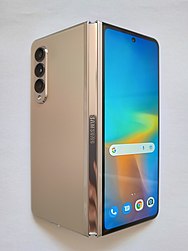

Cameras on cell phones proved popular right from the start, as indicated by the J-Phone in Japan having had more than half of its subscribers using cell phone cameras in two years. The world soon followed. In 2003, more camera phones were sold worldwide than stand-alone digital cameras largely due to growth in Japan and Korea.[104] In 2005, Nokia became the world’s most sold digital camera brand. In 2006, half of the world’s mobile phones had a built-in camera.[citation needed] In 2006, Thuraya released the first satellite phone with an integrated camera. The Thuraya SG-2520 was manufactured by Korean company APSI and ran Windows CE. In 2008, Nokia sold more camera phones than Kodak sold film-based simple cameras, thus becoming the biggest manufacturer of any kind of camera.[citation needed] In 2010, the worldwide number of camera phones totaled more than a billion.[105] Since 2010, most mobile phones, even the cheapest ones, are being sold with a camera. High-end camera phones usually had a relatively good lens and high resolution.


Higher resolution camera phones started to appear in the 2010s. 12-megapixel camera phones have been produced by at least two companies.[106][107] To highlight the capabilities of the Nokia N8 (Big CMOS Sensor) camera, Nokia created a short film, The Commuter,[108] in October 2010. The seven-minute film was shot entirely on the phone’s 720p camera. A 14-megapixel smartphone with 3× optical zoom was announced in late 2010.[109] In 2011, the first phones with dual rear cameras were released to the market but failed to gain traction. Originally, dual rear cameras were implemented as a way to capture 3D content, which was something that electronics manufacturers were pushing back then. Several years later, the release of the iPhone 7 would popularize this concept, but instead using the second lens as a wide angle lens.[110][111][112][113][114][115] In 2012, Nokia announced Nokia 808 PureView. It features a 41-megapixel 1/1.2-inch sensor and a high-resolution f/2.4 Zeiss all-aspherical one-group lens. It also features Nokia’s PureView Pro technology, a pixel oversampling technique that reduces an image taken at full resolution into a lower resolution picture, thus achieving higher definition and light sensitivity, and enables lossless zoom. In mid-2013, Nokia announced the Nokia Lumia 1020. In 2014, the HTC One M8 introduced the concept of having a camera as a depth sensor. In late 2016, Apple introduced the iPhone 7 Plus, one of the phones to popularize a dual camera setup. The iPhone 7 Plus included a main 12 MP camera along with a 12 MP telephoto camera which allowed for 2x optical zoom and Portrait Mode for the first time in a smartphone. In early 2018 Huawei released a new flagship phone, the Huawei P20 Pro, with the first triple camera lens setup. Making up its three sensors (co-engineered with Leica) are a 40 megapixel RGB lens, a 20 megapixel monochrome lens, and an 8 megapixel telephoto lens. Some features on the Huawei P20 Pro include 3x optical zoom, and 960 fps slow motion. In late 2018, Samsung released a new mid-range smartphone, the Galaxy A9 (2018) with the world’s first quad camera setup. The quadruple camera setup features a primary 24MP f/1.7 sensor for normal photography, an ultra-wide 8MP f/2.4 sensor with a 120 degrees viewing angle, a telephoto 10MP f/2.4 with 2x optical zoom and a 5MP depth sensor for effects such as b`okeh. Nokia 9 PureView was released in 2019 featuring penta-lens camera system.[116]
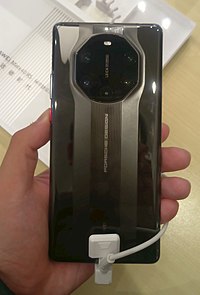

In 2019, Samsung Electronics announced the Galaxy A80, which has only rear cameras. When the user wants to take a selfie, the cameras automatically slide out of the back and rotate towards the user. This is known as a pop-up camera, and it allows smartphone displays to cover the entire front of the phone body without a notch or a punch hole on the top of the screen. Samsung, Xiaomi, OnePlus, and other manufacturers adopted a system where the camera «pops» out of the phone’s body.[117][118] Also in 2019, Samsung developed and began commercialization of 64 and 108-megapixel cameras for phones. The 108 MP sensor was developed in cooperation with Chinese electronics company Xiaomi and both sensors are capable of pixel binning, which combines the signals of 4 or 9 pixels, and makes the 4 or 9 pixels act as a single, larger pixel. A larger pixel can capture more light (resulting in a higher ISO rating and lower image noise).[119][120][121] Under display cameras are under development, which would place a camera under a special display that would allow the camera to see through the display, such as Samsung Galaxy Z Fold 3.[122][123][124][125]
Manufacturers[edit]
Major manufacturers of cameras for phones include Sony, Toshiba, ST Micro, Sharp, Omnivision, and Aptina (Now part of ON Semiconductor).[citation needed]
[edit]

Taking a photograph with a cell phone

Taking a photo on a smartphone in landscape mode
Personal photography allows people to capture and construct personal and group memory, maintain social relationships as well as expressing their identity.[126] The hundreds of millions[127]
of camera phones sold every year provide the same opportunities, yet these functions are altered and allow for a different user experience. As mobile phones are constantly carried, they allow for capturing moments at any time. Mobile communication also allows for immediate transmission of content (for example via Multimedia Messaging Services), which cannot be reversed or regulated. Brooke Knight observes that «the carrying of an external, non-integrated camera (like a DSLR) always changes the role of the wearer at an event, from participant to photographer».[128] The camera phone user, on the other hand, can remain a participant in whatever moment they photograph. Photos taken on a camera phone serve to prove the physical presence of the photographer. The immediacy of sharing and the liveness that comes with it allows the photographs shared through camera phones to emphasize their indexing of the photographer.
While phones have been found useful by tourists and for other common civilian purposes, as they are cheap, convenient, and portable; they have also posed controversy, as they enable secret photography. A user may pretend to be simply talking on the phone or browsing the internet, drawing no suspicion while photographing a person or place in non-public areas where photography is restricted, or against that person’s wishes. Camera phones have enabled everyone to exercise freedom of speech by quickly communicating to others what they see with their own eyes. In most democratic free countries, there are no restrictions against photography in public and thus camera phones enable new forms of citizen journalism, fine art photography, and recording one’s life experiences for facebooking or blogging.
Camera phones have also been very useful to street photographers and social documentary photographers as they enable them to take pictures of strangers in the street without them noticing, thus allowing the artist/photographer to get close to subjects and take more lively photos.[129] While most people are suspect of secret photography, artists who do street photography (like Henri Cartier-Bresson did), photojournalists and photographers documenting people in public (like the photographers who documented the Great Depression in 1930s America) must often work unnoticed as their subjects are often unwilling to be photographed or are not aware of legitimate uses of secret photography like those photos that end up in fine art galleries and journalism.
As a network-connected device, megapixel camera phones are playing significant roles in crime prevention, journalism and business applications as well as individual uses. They can also be used for activities such as voyeurism, invasion of privacy, and copyright infringement. Because they can be used to share media almost immediately, they are a potent personal content creation tool.
Camera phones limit the «right to be let alone», since this recording tool is always present. A security bug can allow attackers to spy on users through a phone camera.[130]
In January 2007, New York City Mayor Michael Bloomberg announced a plan to encourage people to use their camera phones to capture crimes happening in progress or dangerous situations and send them to emergency responders. The program enables people to send their images or video directly to 911.[131] The service went live in 2020.[132]
Camera phones have also been used to discreetly take photographs in museums, performance halls, and other places where photography is prohibited. However, as sharing can be instantaneous, even if the action is discovered, it is too late, as the image is already out of reach, unlike a photo taken by a digital camera that only stores images locally for later transfer. However, as the newer digital cameras support Wi-Fi, a photographer can perform photography with a DSLR and instantly post the photo on the internet through the mobile phone’s Wi-Fi and 3G capabilities.
Apart from street photographers and social documentary photographers or cinematographers, camera phones have also been used successfully by war photographers.[133] The small size of the camera phone allows a war photographer to secretly film the men and women who fight in a war, without them realizing that they have been photographed, thus the camera phone allows the war photographer to document wars while maintaining her or his safety.
In 2010, in Ireland the annual «RTÉ 60 second short award» was won by 15-year-old Laura Gaynor, who made her winning cartoon, «Piece of Cake» on her Sony Ericsson C510 camera phone.[134][135][136] In 2012, director and writer Eddie Brown Jr.[137] made the reality thriller Camera Phone,[138] one of the first commercial produced movies using camera phones as the story’s perspective. The film is a reenactment of an actual case, and the names were changed to protect those involved. Some modern camera phones (in 2013–2014) have big sensors, thus allowing a street photographer or any other kind of photographer to take photos of similar quality to a semi-professional camera.
Camera as an interaction device[edit]
The cameras of smartphones are used as input devices in numerous research projects and commercial applications. A commercially successful example is the use of QR codes attached to physical objects. QR codes can be sensed by the phone using its camera and provide an according link to related digital content, usually a URL. Another approach is using camera images to recognize objects. Content-based image analysis is used to recognize physical objects such as advertisement posters[139] to provide information about the object. Hybrid approaches use a combination of un-obtrusive visual markers and image analysis. An example is to estimate the pose of the camera phone to create a real-time overlay for a 3D paper globe.[140]
Some smartphones can provide an augmented reality overlay for 2D objects[141] and to recognize multiple objects on the phone using a stripped down object recognition algorithm[142] as well as using GPS and compass. A few can translate text from a foreign language.
[143]
Auto-geotagging can show where a picture is taken, promoting interactions and allowing a photo to be mapped with others for comparison.
Smartphones can use their front camera (of lesser performance as compared to rear camera) facing the user for purposes like self-portraiture (selfie) and videoconferencing.[144]

A bystander uses his camera phone to record a skateboarder at LES skatepark, 2019
Laws[edit]
Camera phones, or more specifically, widespread use of such phones as cameras by the general public, has increased exposure to laws relating to public and private photography. The laws that relate to other types of cameras also apply to camera phones. There are no special laws for camera phones. Enforcing bans on camera phones has proven nearly impossible. They are small and numerous and their use is easy to hide or disguise, making it hard for law enforcement and security personnel to detect or stop use. Total bans on camera phones would also raise questions about freedom of speech and the freedom of the press, since camera phone ban would prevent a citizen or a journalist (or a citizen journalist) from communicating to others a newsworthy event that could be captured with a camera phone.
From time to time, organizations and places have prohibited or restricted the use of camera phones and other cameras because of the privacy, security, and copyright issues they pose. Such places include the Pentagon, federal and state courts,[145] museums, schools, theaters, and local fitness clubs. Saudi Arabia, in April 2004, banned the sale of camera phones nationwide for a time before reallowing their sale in December 2004 (although pilgrims on the Hajj were allowed to bring in camera phones). There is the occasional anecdote of camera phones linked to industrial espionage and the activities of paparazzi (which are legal but often controversial), as well as some hacking into wireless operators’ network.
Notable events involving camera phones[edit]
- The 2004 Indian Ocean earthquake was the first global news event where the majority of the first day news footage was no longer provided by professional news crews, but rather by citizen journalists, using primarily camera phones.
- On November 17, 2006, during a performance at the Laugh Factory comedy club, comedian Michael Richards was recorded responding to hecklers with racial slurs by a member of the audience using a camera phone. The video was widely circulated in television and internet news broadcasts.
- On December 30, 2006, the execution of former Iraqi dictator Saddam Hussein was recorded by a video camera phone, and made widely available on the Internet. A guard was arrested a few days later.[146]
- Camera phone video and photographs taken in the immediate aftermath of the 7 July 2005 London bombings were featured worldwide. CNN executive Jonathan Klein predicts camera phone footage will be increasingly used by news organizations.
- Camera phone digital images helped to spread the 2009 Iranian election protests.
- Camera phones recorded the BART Police shooting of Oscar Grant.
Camera phone photography[edit]

«Storm is coming», an example of iPhoneography
Photography produced specifically with phone cameras has become an art form in its own right.[147][148][149][150][151][152] Work in this genre is sometimes referred to as iPhoneography (whether for photographs taken with an iPhone,[153][154][155] or any brand of smart phone).[156][157][158] The movement, though already a few years old, became mainstream with the advent of the iPhone and its App Store which provided better, easier, and more creative tools for people to shoot, process, and share their work.[159]
Reportedly, the first gallery exhibition to feature iPhoneography exclusively opened on June 30, 2010: «Pixels at an Exhibition» was held in Berkeley, California, organized and curated by Knox Bronson and Rae Douglass.[160] Around the same time, the photographer Damon Winter used Hipstamatic to make photos of the war in Afghanistan.[161][162] A collection of these was published November 21, 2010 in the New York Times in a series titled «A Grunt’s Life»,[163] earning an international award (3rd) sponsored by RJI, Donald W. Reynolds Journalism Institute.[164] Also in Afghanistan, in 2011, photojournalist David Guttenfelder used an iPhone and the Polarize application.[165] In 2013, National Geographic published a photo feature in which phoneographer Jim Richardson used his iPhone 5s to photograph the Scottish Highlands.[166]
Camera phone filmmaking[edit]
Since they got their video cameras, smartphones came to be widely used for videography. Filmmakers gradually became interested in their capabilities.[167] Mobile filmmaking is developing its own aesthetics due to its compactness, portability and its technological limitations that are being overcome every day by new implementations.[168]
Many filmmakers work with smartphones as the main camera for their films. Steven Soderbergh’s films Unsane[169] and High Flying Bird were shot entirely on iPhone.
See also[edit]
- Auxiliary memory
- Mobile phone accessories
- Modular smartphone
- Smartwatch
- Video editor
References[edit]
- ^ «Image of kyocera visual phone vp-210, japan, 2008». Science & Society Picture Library. Retrieved 2021-10-12.
- ^ «Camera Sales in 2020 Have Plummeted as Much as 54%». PetaPixel. 6 November 2020. Retrieved 2021-05-22.
- ^ «StackPath».
- ^ «Motorola DROID X vs. HTC Droid Incredible». Phone Arena. Archived from the original on 2011-12-28.
- ^ «Review: Samsung Omnia II’s Camera». Windows Central. 28 January 2010.
- ^ «Top 16 Best Camera Phones For Photography 2019». April 4, 2019. Archived from the original on May 12, 2019. Retrieved May 12, 2019.
- ^ Johnson, Joel (October 2009). «Take High-Quality Pics With Your Phone’s Low-Quality Camera». Popular Mechanics. Archived from the original on 2010-09-12.
- ^ Ferenczi, Peter M. (2013-03-07). «Nokia Lumia 920 Camera Review». DPReview. Retrieved 27 March 2022.
It’s the first phone with an optically stabilized (OIS) camera, and this is the big low-light news. Note that a number of phones claim «image stabilization» as a feature, but this is not stratospheric ISO abuse and/or waiting for a relatively steady moment to release the shutter.
- ^ Rehm, Lars (2016-04-12). «HTC 10 is the first smartphone with OIS in front and rear cameras». DPReview. Retrieved 27 March 2022.
- ^ P., Daniel (2013-01-21). «Sony Xperia Z HDR video compilation: less burn, more detail». Phone Arena. Retrieved 2 December 2021.
- ^ «Shoot great videos in all conditions with the new HDR functionality in Xperia™ Z – Developer World». Sony Developer World. 22 January 2013. Archived from the original on 26 January 2013. Retrieved 2 December 2021.
- ^ Adam Ismail (May 11, 2019). «Best Smartphone Cameras 2019». Archived from the original on May 15, 2019. Retrieved May 18, 2019.
- ^ Ron Amadeo (March 27, 2019). «New Huawei phone has a 5x optical zoom, thanks to a periscope lens». Archived from the original on November 30, 2019. Retrieved November 20, 2019.
- ^ Monckton, Paul. «Android 5.0 Camera Tests Show Update Instantly Improves Every Smartphone». Forbes. Archived from the original on December 18, 2014. Retrieved December 27, 2014.
- ^ Rehm, Lars. «Panasonic announces Lumix DMC-CM1 smartphone with 1-inch sensor». Archived from the original on December 18, 2014. Retrieved December 27, 2014.
- ^ Snell, Jason (2017-09-20). «iOS 11: HEVC, HEIF, and what you need to know about these new video and photo formats». Macworld. Archived from the original on 2018-11-16. Retrieved 2017-09-30.
- ^ «Supported media formats». Android Developers. Retrieved 2022-08-05.
- ^ a b «HEIF Imaging». Android Open Source Project. Retrieved 2022-08-05.
- ^ «Samsung I9300 Galaxy S III review: S to the third». GSMArena.com. p. 9.
- ^ «Sony Xperia S review: NXT of kin». GSMArena.com. p. 6.
- ^ «HTC One X review: eXtra special». GSMArena.com. Retrieved 2021-04-02.
- ^ «Apple iPhone XS review». GSMArena.com. p. 7.
- ^ Hristov, Victor (2018-07-31). «How to see the filename of photo or video on iPhone». Phone Arena.
- ^ «Where are images stored on Android? What is the DCIM thumbnails folder? | How to recover». howtorecover.me. 2020-06-22.
- ^ a b Parks, Bob (October 2000). «Wired Magazine, The Big Picture — Philippe Kahn». Archived from the original on 2006-03-26. Retrieved 2006-04-20.
- ^ «Nokia 3100 Sheds Light on Mobile Personal Expression». www.businesswire.com. June 16, 2003. Archived from the original on November 11, 2018. Retrieved November 10, 2018.
- ^ «Nokia Fun Camera PT-3 — Mobile Phone Review — CNET Asia». January 12, 2008. Archived from the original on January 12, 2008.
- ^ photobug22 (4 October 2013). «Smartphone Attachable Lens-style Camera — DSCQX100/B Review — Sony US». Sony US. Archived from the original on 4 October 2014.
- ^ Crisp, Simon (January 18, 2014). «Kodak smart lens cameras try to take on Sony». Archived from the original on October 6, 2014.
- ^ «Sakar shows QX-style, Vivitar-branded modular smart camera». January 14, 2014.
- ^ «NEW ARRIVAL: HTC RE Camera». March 20, 2016. Archived from the original on March 29, 2016.
- ^ Clark, Don (August 18, 2014). «Add-on thermal imaging». The Wall Street Journal. Archived from the original on January 13, 2017.
- ^ Linder, Courtney (2019-11-22). «If You’ve Ever Wanted a Smartphone Microscope, Now’s Your Chance». Popular Mechanics. Retrieved 2020-11-03.
- ^ «Equipment reviews». Walton Astronomy Group. Retrieved 2020-11-26.
- ^ «Panasonic Lumix DMC-FZ1000 Review». PCMAG.
- ^ Angove, Alex (2013-08-15). «Xenon vs LED Flash: what’s best for a phone photographers?». www.whistleout.com. Archived from the original on 2013-08-17. Retrieved 2021-04-16.
- ^ «Use Different Camera Apps to Improve Photo Quality». Phone Scoop. 2014-04-05. Retrieved 10 January 2022.
In general, I was quite pleased with all the images I captured using the FV-5 app. Images were in focus, well-exposed, and had proper white balance. It is a little slow to focus sometimes, and that can affect the outcome depending on the subject. For still lifes, it doesn’t matter, but for action shots it might.
- ^ a b «Samsung Galaxy S4 review: Supernova – 9. Camera». www.gsmarena.com. 2013-03-28. p. 9. Retrieved 8 November 2021.
- ^ «Das Samsung Galaxy S5 Tagebuch — Traumflieger.de». www.traumflieger.de. 2014-06-17. Retrieved 25 January 2022.
- ^ «Samsung i9000 Galaxy S User manual» (PDF). Samsung Mobile. 2010. pp. 47–56. Retrieved 25 January 2022.
- ^ c. f. camera software of Samsung since the Galaxy S10, of Huawei since the P20, of LG since the G8, since the OnePlus 6, of Xiaomi since Redmi Note 5, and of UleFone smartphones released since at least 2017 (as of 2022).
- ^ a b c «Samsung Galaxy S4 review: Supernova – Camera». GSMArena.com. 2013-03-28. p. 9. Retrieved 14 November 2021.
The viewfinder is handles both still and video capture, so you don’t have to switch modes.
- ^ «Samsung Galaxy S5 Activate Touch & Shoot within the Camera settings». Solvemix — quick tips, tricks and solutions.
- ^ «How to Use Autofocus and Auto Exposure Lock on Your iPhone Camera». www.iphonelife.com. 11 August 2015. Retrieved 15 November 2021.
- ^ «How to Adjust Exposure on Galaxy S7 • Android Flagship». Android Flagship. 6 October 2016. Retrieved 15 November 2021.
- ^ Rehm, Lars (2012-11-01). «Samsung Galaxy S3 Camera Review». DPReview. Retrieved 1 December 2021.
You focus by tapping on the screen and you can lock focus by tapping and holding.
- ^ a b Sonigra, Mitesh (2013-09-26). «Sony Xperia Z Review: The Fragile yet Beautiful Swimmer». Mobile Jury. p. 2. Archived from the original on 2013-09-30. Retrieved 1 December 2021.
- ^ «iPhone 13 review: The one to get?». www.pocket-lint.com. 21 September 2021. Retrieved 1 January 2022.
In low-light conditions, we did find there was some lag after pressing the shutter button before Night Mode kicked in, but the results are still good.
- ^ «Bring back the iOS 6 camera shutter animation». The iPhone FAQ. 16 February 2016. Retrieved 10 January 2022.
- ^ Kim, Eric (7 September 2018). «iPhone 8 Camera Review». Eric Kim Photography. Retrieved 1 January 2022.
. I like the haptic response of the phone buzzing a bit when you take a photo. It reminds me of the haptic feedback when you shoot with a camera with a mirror, or with an old film camera.
- ^ Samsung Galaxy, Apple iPhone, Sony Xperia, HTC, Open Camera
- ^ «How to use the Sony Xperia Z2 camera to take better photos: Background defocus, timeshift burst, manual mode». Expert Reviews. 2014-10-16. Retrieved 8 November 2021.
- ^ «How to quickly launch the camera on Samsung Galaxy S6 and Galaxy S6 edge». Android Beat | Android News, Hacks, Apps, Tips & Reviews Blog. 3 April 2015. Retrieved 8 November 2021.
- ^ «How To Use Pro Camera Mode On Samsung’s Galaxy S7 And S7 Edge». Digital Trends. 25 April 2017. Retrieved 8 November 2021.
- ^ «Manual Shutter Speed Adjustment on Galaxy Note 5 and S6 edge+». www.cameradebate.com. 2015-08-19. Retrieved 13 November 2021.
- ^ Petric, Dragan (2016-03-11). «LG V10 Review: A Different Kind of Flagship — NotebookReview.com». www.notebookreview.com. Retrieved 25 January 2022.
- ^ Kronfli, Basil (29 July 2019). «Samsung Galaxy S10 5G review». digitalcameraworld. Retrieved 14 November 2021.
- ^ «Sony Xperia Z2 review». Android Authority. 4 April 2014. Retrieved 14 November 2021.
- ^ «Pro mode on Galaxy S7 and Galaxy S7 edge works even when video recording is active». SamMobile.
- ^ a b «LG V10 review: Screen play – 8. Camera features». GSMArena.com. 2015-11-02. p. 8. Retrieved 24 November 2021.
- ^ a b S., Ray (2015-11-05). «LG V10 Review — Camera and Multimedia». Phone Arena. p. 2. Retrieved 24 November 2021.
- ^ «Sony Xperia Z2 Prone To Overheating When Recording 4K Video». Cult of Android. 9 April 2014. Retrieved 15 November 2021.
- ^ «How do I take pictures by Slow motion mode on Galaxy S6/S6 edge (Hong-Kong version)?». Samsung hk_en.
- ^ H, Victor (2014-04-07). «Samsung Galaxy S5 vs Samsung Galaxy S4 — Camera and Multimedia». Phone Arena. p. 3. Retrieved 14 November 2021.
- ^ Lynch, Jim (24 November 2015). «iPhone 6s: Enable 4K video recording». CIO. Retrieved 14 November 2021.
- ^ Cozma, Nicole (2012-09-07). «Use your voice to take pictures with the Samsung Galaxy S III». CNET. Retrieved 2 December 2021.
- ^ «How to use Galaxy S6 camera gesture control?». Gadget Guide Online. 22 May 2015. Retrieved 2 December 2021.
- ^ «Tips and Tricks for Samsung Galaxy S». Unp.me. 2010-10-27. Retrieved 25 January 2022.
11. How to lock camera screen. If you press power button while camera is running, the touch screen is locked to prevent unintentional manipulation or re-loading time. This feature is useful for the touch sensitive camera phone. You can toggle by power button and use the back key to close the camera program.
- ^ «Live Photos explained: How the new iPhone 6S, 6S Plus and SE camera feature works». Trusted Reviews. 1 October 2015. Retrieved 14 November 2021.
- ^ Cipriani, Jason (2016-03-17). «What you need to know about Motion Photo on the Galaxy S7». CNET. Retrieved 14 November 2021.
- ^ «What is Remote ViewFinder mode in Samsung Galaxy S5(SM-G900H)? | Samsung Support India». Samsung India. Retrieved 1 December 2021.
- ^ Samung Galaxy S4 Zoom (SM-C101) user manual
- ^ «iPhone 6s vs. Galaxy S6 vs. Xperia Z5: Monster Brawl». GSMArena.com. 2015-10-23. p. 9. Retrieved 1 December 2021.
- ^ «What is the Shot & more camera mode on my Samsung Galaxy S5 and how Do I use it? | Samsung South Africa». Samsung za. 2020-10-20. Retrieved 2021-11-15.
- ^ «Samsung Galaxy S5 User Guide». Tom’s Guide. 3 October 2018. Retrieved 14 November 2021.
- ^ «How to use LIGHT PAINTING to shoot LIGHT TRAILS… [ EMUI 10 TIPS ]». consumer.huawei.com. Retrieved 1 January 2022.
- ^ Li, Deng (4 July 2018). «What is Huawei’s AIS super night camera technology?- explained, sample shots included». Huawei Central. Retrieved 1 January 2022.
- ^ «Samsung Galaxy S6 camera tips and tricks». Android Beat | Android News, Hacks, Apps, Tips & Reviews Blog. 31 July 2015. Retrieved 1 January 2022.
- ^ «Sony Xperia Z1 review: A smartphone with a camera-sized sensor». DPReview. 2013-11-01.
- ^ Carson, Biz (2017-09-12). «Tim Cook Isn’t Wrong: Why The iPhone X Could Change How We Use Phones Forever». Forbes.
- ^ Jason Cipriani (2018-08-27). «13 tips and tricks for the Note 9’s camera». CNet. Retrieved 2021-12-09.
- ^ Shankland, Stephen. «Pixel 6 cameras go all in on AI. Here’s the inside story». CNET. Retrieved 2021-12-12.
- ^ Matsumoto, Kazuya; et al. (1985). «A new MOS phototransistor operating in a non-destructive readout mode». Japanese Journal of Applied Physics. 24 (5A): L323. Bibcode:1985JaJAP..24L.323M. doi:10.1143/JJAP.24.L323. S2CID 108450116.
- ^ a b Belmudez, Benjamin (2014). Audiovisual Quality Assessment and Prediction for Videotelephony. Springer. pp. 11–13. ISBN 9783319141664.
- ^ a b Huang, Hsiang-Cheh; Fang, Wai-Chi (2007). Intelligent Multimedia Data Hiding: New Directions. Springer. p. 41. ISBN 9783540711698. Archived from the original on 2020-02-26. Retrieved 2019-09-15.
- ^ Ahmed, Nasir (January 1991). «How I Came Up With the Discrete Cosine Transform». Digital Signal Processing. 1 (1): 4–5. doi:10.1016/1051-2004(91)90086-Z. Archived from the original on 2016-06-10. Retrieved 2019-09-15.
- ^ Hudson, Graham; Léger, Alain; Niss, Birger; Sebestyén, István; Vaaben, Jørgen (31 August 2018). «JPEG-1 standard 25 years: past, present, and future reasons for a success». Journal of Electronic Imaging. 27 (4): 1. doi:10.1117/1.JEI.27.4.040901.
- ^ «What Is a JPEG? The Invisible Object You See Every Day». The Atlantic. 24 September 2013. Archived from the original on 9 October 2019. Retrieved 13 September 2019.
- ^ «History of digital camera». 2007-02-19. Archived from the original on February 19, 2007. Retrieved 2016-05-19.
- ^ «Apple Prototypes: 5 Products We Never Saw». Tech Weird News. 2006-11-30. Archived from the original on 2011-12-10.
- ^ «United States Patent: D405457 — Digital camera with cellular phone and portable computer». Archived from the original on 2016-10-12.
- ^ «tardispanel.swf». Archived from the original on December 8, 2013.
- ^ «PatentCert.pdf» (PDF). Archived from the original (PDF) on May 2, 2014.
- ^ «The device for personal communications, data collection and handling and for PCB». Archived from the original on 2019-12-29.
- ^ «A baby girl and the camera phone were born 20 years ago». The Mercury News. 2017-06-08. Retrieved 2021-03-11.
- ^ Maney, Kevin (2007-01-23). «Baby’s birth foretells «birth» of the cell phone camera — and societal evolution». USA Today. Archived from the original on 2007-10-21. Retrieved 2007-12-25.
- ^ Epstein, Sonia (August 2018). «The Birth of the Camera Phone». Archived from the original on 2018-08-07. Retrieved 2018-08-07.
- ^ Sullivan, Robert (2011). 100 Photographs That Changed The World. LIFE Books. p. 19. ISBN 978-1-60320-176-6.
- ^ a b c «Camera phones: A look back and forward». Computerworld. 11 May 2012. Archived from the original on 9 October 2019. Retrieved 15 September 2019.
- ^ «First mobile videophone introduced». CNN. May 18, 1999. Archived from the original on 25 August 2019. Retrieved 15 September 2019.
- ^ a b «From J-Phone to Lumia 1020: A complete history of the camera phone». Digital Trends. August 11, 2013. Archived from the original on 14 September 2019. Retrieved 15 September 2019.
- ^ «Evolution of the Camera phone: From Sharp J-SH04 to Nokia 808 Pureview». Hoista.net. 2012-02-28. Archived from the original on 2013-07-31. Retrieved 2013-06-21.
- ^ «Taking pictures with your phone». BBC News. BBC. 18 September 2001. Archived from the original on 28 August 2017. Retrieved 15 September 2019.
- ^ «Strategy Analytics: Camera Phones Outsell Digital Still Cameras Worldwide; NEC, Panasonic and Nokia Lead 25 Million Unit Market». Business Wire. September 25, 2003. Archived from the original on 4 January 2018. Retrieved 17 December 2017.
- ^ «Dotty but dashing». The Economist. 8 April 2010. Archived from the original on 5 August 2013.
- ^ «Samsung Pixon12 M8910 Price in India — 12 megapixel camera-phone». Newtechnology.co.in. Archived from the original on 2012-04-24. Retrieved 2013-06-21.
- ^ «Sony Ericsson Satio – A Phone with Ultimate multimedia experience». Newtechnology.co.in. Archived from the original on 2012-07-14. Retrieved 2013-06-21.
- ^ «The Commuter (2010)». IMDb. 26 October 2010. Archived from the original on 17 November 2010.
- ^ «Crave». CNET. CBS Interactive. Archived from the original on 2012-04-03.
- ^ «Dual, triple, quad camera smartphones: The history running through to the Samsung Galaxy S10». Pocket-lint. February 20, 2019. Archived from the original on April 20, 2020. Retrieved December 26, 2019.
- ^ «Take Your Photos to the Next Level With Dual Camera Phones». Lifewire. Archived from the original on 2019-12-26. Retrieved 2019-12-26.
- ^ «A Brief History of the Past, Present, and Future of Dual Camera Smartphones». March 2, 2017. Archived from the original on April 17, 2020. Retrieved December 26, 2019.
- ^ «A Look at Dual Camera Systems in Smartphones». B&H Explora. Archived from the original on 2019-12-26. Retrieved 2019-12-26.
- ^ «Dual, triple, quad camera smartphones: The history running through to the Samsung Galaxy S10». Pocket-lint. Archived from the original on 2020-04-20. Retrieved 2019-12-26.
- ^ «Dual cameras in smartphones: 7 little-known facts | Gadgets Now». Gadget Now. Archived from the original on 2019-12-26. Retrieved 2019-12-26.
- ^ «Nokia 9 PureView — Full phone specifications». www.gsmarena.com. Archived from the original on 2019-06-06. Retrieved 2019-05-20.
- ^ Rayner, Tristan (April 4, 2020). «RIP pop-up selfie cameras. We hardly knew ye». Archived from the original on April 27, 2020. Retrieved May 10, 2020.
- ^ Porter, Jon (April 10, 2019). «Samsung’s Galaxy A80 is an automated notchless slider with a rotating triple camera». The Verge. Archived from the original on April 12, 2019. Retrieved April 12, 2019.
- ^ «Samsung makes industry’s first 108 MP smartphone camera sensor for Xiaomi». Archived from the original on 2019-12-08. Retrieved 2019-12-08.
- ^ «64-megapixel phone cameras are coming». 8 May 2019. Archived from the original on 2019-05-10. Retrieved 2019-12-08.
- ^ «Samsung to Bring Industry’s Highest Resolution for Mobile Cameras with New 64Mp ISOCELL Image Sensor». Archived from the original on 2019-12-16. Retrieved 2019-12-08.
- ^ «Want under-display cameras? Sorry to burst your bubble, says Xiaomi». Android Central. January 30, 2020.
- ^ «Oppo’s under-display camera means we can finally stop arguing about notches». December 11, 2019. Archived from the original on April 10, 2020. Retrieved May 10, 2020.
- ^ «Hands-on with Oppo’s under-display camera prototype». December 11, 2019. Archived from the original on April 28, 2020. Retrieved May 10, 2020.
- ^ Lovejoy, Ben (February 28, 2020). «Second proof of concept of under-display camera, but won’t come to iPhone soon». 9to5Mac. Archived from the original on March 1, 2020. Retrieved May 10, 2020.
- ^ Gye, Lisa (2007) Picture This: The Impact of Mobile Camera Phones on Personal Photographic Practices in Continuum Vol 21 Issue 2. pp 279-288
- ^ «Asia-Pacific Camera Phone Market Tops 600 Million Units in 2010, Says New Lyra Report». PRWeb. 10 October 2006. Archived from the original on 5 February 2007.
- ^ Brooke A. Knight, «Performative Pictures: Camera Phones at the Ready,» in New Visualities, New Technologies: The New Ecstasy of Communication, ed. J. Macgregor Wise and Hille Koskela (Farnham, Surrey, England: Ashgate, 2012), 162.
- ^ Kim, Eric (11 October 2012). «3 Reasons Why You Should Use the iPhone 5 For Street Photography by Mike Avina». Eric Kim Street Photography Blog. Archived from the original on 2014-03-06.
- ^ Android flaw allowed attackers to spy on users through phone camera. https://mashable.com/article/google-samsung-android-camera-flaw/. Archived 2019-11-20 at the Wayback Machine Mashable 2019-11-19
- ^ «Textually.org, NY Mayor Bloomberg outlines citizen camphone hotline». January 2007. Archived from the original on 2007-01-27. Retrieved 2007-01-18.
- ^ «NYC launches Text-to-911 service after years of delays». Smart Cities Dive. Retrieved 2021-05-16.
- ^ Estrin, James (2010-11-21). «Finding the Right Tool to Tell a War Story». The New York Times. Archived from the original on 2014-03-02.
- ^ LauraGaynorTV (31 March 2010). «Two Tube -Piece of cake — RTE 60 second short award 2010». Archived from the original on 12 October 2016 – via YouTube.
- ^ «Life after the Leaving: «You have to be a bit of a chancer.»«. The Irish Times. Archived from the original on 2016-04-23.
- ^ LauraGaynorTV (9 May 2010). «Piece of cake (original mobile version)». Archived from the original on 13 March 2016 – via YouTube.
- ^ «Eddie Brown Jr». IMDb. Archived from the original on 2012-10-22.
- ^ «Camera Phone (2012)». IMDb. 29 September 2012. Archived from the original on 19 October 2012.
- ^ Pielot, M.; Henze, N.; Nickel, C.; Menke, C.; Samadi, S.; Boll, S. (2008). «Evaluation of Camera Phone Based Interaction to Access Information Related to Posters» (PDF). Proceedings of Mobile Interaction with the Real World. Archived from the original (PDF) on 2011-07-19.
- ^ Schöning, J.; Rohs, M.; Krüger, A (2008). «Mobile Interaction with the «Real World»» (PDF). Proceedings of Mobile Interaction with the Real World. Archived from the original (PDF) on 2011-07-19.
- ^ Wagner, D.; Reitmayr, G; Mulloni, A; Drummond, T; Schmalstieg, D (2008). «Pose Tracking from Natural Features on Mobile Phones» (PDF). Proceedings of the Symposium on Mixed and Augmented Reality. Archived from the original (PDF) on 2009-06-12.
- ^ Henze, N.; Schinke, T.; Boll, S. (2009). «What is that? Object recognition from Natural Features on a mobile Phone» (PDF). Proceedings of Mobile Interaction with the Real World. Archived from the original (PDF) on 2011-07-19.
- ^ «Smartphone app to boost translation». Press Association. Jan 14, 2015. Retrieved 26 January 2015.
- ^ «Front-Facing Camera». phonescoop.com. Archived from the original on 2012-06-12. Retrieved 2012-07-27.
- ^ «Notice from the Clerk». Archived from the original on August 19, 2006.
- ^ «Guard at Hanging Blamed for Covert Video of Hussein». washingtonpost.com. Archived from the original on 2008-10-11.
- ^ Alshawaf, Eman, ‘iPhoneography and New Aesthetics: The Emergence of a Social Visual Communication Through Image‐based Social Media’ DRS2016: Design + Research + Society, Future-Focused Thinking [2016 Design Research Society 50th Anniversary Conference, 27–30 June 2016, Brighton, UK].
- ^ Alshawaf, Eiman, ‘iPhoneography and Contemporary Image-Making: Examining a New Form of Visual Communication in the Age of Social Media Archived 2019-04-01 at the Wayback Machine’ (unpublished Ph.D dissertation, University of Minnesota, 2017).
- ^ Chopra-Gant, Mike, ‘Pictures or It Didn’t Happen: Photo-nostalgia, iPhoneography and the Representation of Everyday Life’, Photography and Culture, 9.2 (2016), 121-33, doi:10.1080/17514517.2016.1203632.
- ^ De Panbehchi, Maria Lourdes, ‘Nostalgia and iPhone Camera Apps: An Ethnographic Visual Approach to iPhoneography Archived 2019-03-31 at the Wayback Machine’ (unpublished Ph.D. dissertation, Virginia Commonwealth University, 2016).
- ^ Halpern, Megan and Lee Humphreys, ‘Iphoneography as an Emergent Art World’, New Media & Society, 18 (2014), 62-81, doi:10.1177/1461444814538632
- ^ Harrington, Justine, ‘Connotations: An Exploration of iPhoneography Archived 2019-04-01 at the Wayback Machine’, Art Journal (2012), 109-13.
- ^ «Question: What is iPhoneography?». Archived from the original on November 10, 2012.
- ^ Roberts, Stephanie (2011). The Art of iphoneography. Pixiq. ISBN 978-1600599231. Retrieved 2019-03-31.
- ^ Goldsworthy, Sophie (2011). The Rough Guide to Digital Photography. Rough Guides. pp. 187. ISBN 978-1405381178.
Iphoneography.
- ^ iPhoneography — How to Create Inspiring Photos with Your Smartphone — Michael Clawson. Apress. 2018-02-05. Archived from the original on 2019-04-01. Retrieved 2019-03-19.
- ^ Clawson, Michael, iPhoneography: How to Create Inspiring Photos with Your Smartphone (Apress, 2015), , ISBN 978-1-4842-1756-6, doi:10.1007/978-1-4842-1757-3.
- ^ Roberts, Stephanie, The Art of iPhoneography: A Guide to Mobile Creativity (Brooklyn, NY: Pixel Communications, 2011), ISBN 9781600599231.
- ^ «How-to: Use the new Camera app in iOS 7». 9to5Mac. 2013-09-20. Archived from the original on 2016-12-30. Retrieved 2019-03-19.
- ^ Yawnick, Marty (February 2010). «Review: Pixels at an Exhibition, Giorgi Gallery | Life In LoFi». Life in LoFi: iPhoneography. Archived from the original on 2015-07-09. Retrieved 2016-02-12.
- ^ Estrin, James (November 21, 2010). «Finding The Right Tool To Tell A War Story». Archived from the original on January 4, 2014. Retrieved March 6, 2014.
- ^ «Hipstamatic War Photography on the Front Page of The New York Times«. PetaPixel. 2010-11-23. Archived from the original on 2019-04-01. Retrieved 2019-03-19.
- ^ Dao, James (21 November 2010). «Between Firefights, Jokes, Sweat and Tedium». The New York Times. Archived from the original on 24 March 2019. Retrieved 24 March 2019.
- ^ «Feature Picture Story». Home Ι Pictures of the Year. Archived from the original on April 1, 2019. Retrieved March 24, 2019.
- ^ Lavoie, Vincent (2012-05-24). «War and the iPhone». Études photographiques (29). ISSN 1270-9050. Archived from the original on 2017-07-22. Retrieved 2019-03-31.
- ^ «Capturing the Aura of the Scottish Highlands With the iPhone 5s». Photography. 2013-10-07. Archived from the original on 2019-03-31. Retrieved 2019-03-19.
- ^ Nihan Gider Işıkman, A Milestone in Film History: Smartphone Filmmaking. International Journal of Culture and History, Vol. 4, No. 4, December 2018
- ^ C. Baker, M. Schleser, and K. Molga, ―Aesthetics of mobile media art,‖ Journal of Media Practice, vol. 10, no. 2-3, 101-122, 2009.
- ^ Steven Soderbergh — Unsane exclusive interview. [Online]. Available:https://www.youtube.com/watch?v=n7zC9gfi60E
«Best Camera Phones 2021 Overview». Retrieved 2021-01-01.
External links[edit]
 Media related to Mobile phones with camera at Wikimedia Commons
Media related to Mobile phones with camera at Wikimedia Commons
Camera phones allow instant, automatic photo sharing. There is no need for a cable or removable card to connect to a desktop or laptop to transfer photos.
A camera phone is a mobile phone which is able to capture photographs and often record video using one or more built-in digital cameras. It can also send the resulting image wirelessly and conveniently. The first commercial phone with color camera was the Kyocera Visual Phone VP-210, released in Japan in May 1999.[1]
Most camera phones are smaller and simpler than the separate digital cameras. In the smartphone era, the steady sales increase of camera phones caused point-and-shoot camera sales to peak about 2010 and decline thereafter.[2] The concurrent improvement of smartphone camera technology, and its other multifunctional benefits, have led to it gradually replacing compact point-and-shoot cameras.[3]
Most modern smartphones only have a menu choice to start a camera application program and an on-screen button to activate the shutter.[4] Some also have a separate camera button, for quickness and convenience. A few such as the 2009 Samsung i8000 Omnia II have a two-level shutter button as in dedicated digital cameras.[5] Some camera phones are designed to resemble separate low-end digital compact cameras in appearance and to some degree in features and picture quality, and are branded as both mobile phones and cameras—an example being the 2013 Samsung Galaxy S4 Zoom.
The principal advantages of camera phones are cost and compactness; indeed for a user who carries a mobile phone anyway, the addition is negligible. Smartphones that are camera phones may run mobile applications to add capabilities such as geotagging and image stitching. Also, modern smartphones can use their touch screens to direct their camera to focus on a particular object in the field of view, giving even an inexperienced user a degree of focus control exceeded only by seasoned photographers using manual focus. However, the touch screen, being a general purpose control, lacks the agility of a separate camera’s dedicated buttons and dial(s).
Starting in the mid-2010s, some advanced camera phones feature optical image stabilisation (OIS), larger sensors, bright lenses, 4K video and even optical zoom, for which a few use a physical zoom lens. Multiple lenses and multi-shot night modes are also familiar.[6] Since the late 2010s, high-end smartphones typically have multiple lenses with different functions, to make more use of a device’s limited physical space. Common lens functions include an ultrawide sensor, a telephoto sensor, a macro sensor, and a depth sensor. Some phone cameras have a label that indicates the lens manufacturer, megapixel count, or features such as autofocus or zoom ability for emphasis, including the Samsung Omnia II (2009), Samsung Galaxy S II (2011), Sony Xperia Z1 (2013) and some successors, Nokia Lumia 1020 (2013), and the Samsung Galaxy S20 (2020).
Technology[edit]
Camera[edit]
Mobile phone cameras typically feature CMOS active-pixel image sensors (CMOS sensors) due to largely reduced power consumption compared to charge-coupled device (CCD) type cameras, which few camera phones use[citation needed]. Some use CMOS back-illuminated sensors, which use even less energy, at higher price than CMOS and CCD.
The usual fixed-focus lenses and smaller sensors limit performance in poor lighting. Lacking a physical shutter, some have a long shutter lag. Photoflash by the typical internal LED source illuminates less intensely over a much longer exposure time than a flash strobe, and none has a hot shoe for attaching an external flash. Optical zoom[7] and tripod screws are rare and some also lack a USB connection or a removable memory card. Most have Bluetooth and WiFi, and can make geotagged photographs. Some of the more expensive camera phones have only a few of these technical disadvantages, but with bigger image sensors (a few are up to 1″, such as the Panasonic Lumix DMC-CM1), their capabilities approach those of low-end point-and-shoot cameras. The few hybrid camera phones such as Samsung Galaxy S4 Zoom and K Zoom were equipped with real optical zoom lenses.

Samsung Galaxy S5 camera module, with floating element group suspended by ceramic bearings and a small magnet

Image showing the six molded elements in the Samsung Galaxy S5
As camera phone technology has progressed, lens design has evolved from a simple double Gauss or Cooke triplet to many molded plastic aspheric lens elements made with varying dispersion and refractive indexes. Some phone cameras also apply distortion (optics), vignetting, and various optical aberration corrections to the image before it is compressed into a JPEG format.
Optical image stabilization allows longer exposures without blurring, despite trembling. The earliest known smartphone to feature it on the rear camera is in late 2012 on the Nokia Lumia 920, and the first known front camera to feature one is on the HTC 10 from early 2016.[8][9]
Few smartphones such as LG initially with the 2014 G3 are equipped with a time-of-flight camera with infrared laser beam assisted auto focus. A thermal imaging camera has initially been implemented in 2016 on the Caterpillar S60.
High dynamic range imaging merges multiple images with different exposure values for a balanced brightness across the image and was first implemented in early 2010s smartphones such as the Samsung Galaxy S III and iPhone 5. The earliest known smartphone to feature high dynamic range filming is the Sony Xperia Z, 2013, where frames are arrayed by changing the exposure every two lines of pixels to create a spatially varying exposure (SVE).[10][11]
As of 2019, high-end camera phones can produce video with up to 4K resolution at 60 frames per second for smoothness.[12]
Zooming[edit]
Most camera phones have a digital zoom feature, which may allow zooming without quality loss if a lower resolution than the highest image sensor resolution is selected, as it makes use of image sensors’ spare resolution. For example, at twice digital zoom, only a quarter of the image sensor resolution is available. A few have optical zoom, and several have a few cameras with different field of view, combined with digital zoom as a hybrid zoom feature. For example, the Huawei P30 Pro uses a «periscope» 5x telephoto camera with up to 10x digital zoom, resulting in 50x hybrid zoom.[13] An external camera can be added, coupled wirelessly to the phone by Wi-Fi. They are compatible with most smartphones. Windows Phones can be configured to operate as a camera even if the phone is asleep.
Physical location[edit]
When viewed vertically from behind, the rear camera module on some mobile phones is located in the top center, while other mobile phones have cameras located in the upper left corner. The latter has benefits in terms of ergonomy due to the lower likelihood of covering and soiling the lens when held horizontally, as well as more efficient packing of tight physical device space due to neighbouring components not having to be built around the lens.
Image format and mode[edit]
Images are usually saved in the JPEG file format. Since the mid-2010s, some high-end camera phones have a RAW photography feature, HDR, and «Bokeh mode». Phones with Android 5.0 Lollipop[14][15] and later versions can install phone apps that provide similar features.
Since iOS 11 (HEIC), Android 8 (Oreo) (HEIF), Android 10 (HEIC) and Android 12 (AVIF), HEIC and AVIF compression formats in HEIF container format are available.[16][17][18] HEIC support on Android requires hardware support.[18]
Audio recording[edit]
Mobile phones with multiple microphones usually allow video recording with stereo audio. Samsung, Sony, and HTC initially implemented it in 2012 on their Samsung Galaxy S3, Sony Xperia S, and HTC One X.[19][20][21] Apple implemented stereo audio starting with the 2018 iPhone Xs family and iPhone XR.[22]
Files and directories[edit]
Like dedicated (stand-alone) digital cameras, mobile phone camera software usually stores pictures and video files in a directory called DCIM/ in the internal memory, with numbered or dated file names. The former prevents missing out files during file transfers and facilitates counting files, whereas the latter facilitates searching files by date/time, regardless of file attribute resets during transfer and possible lack of in-file metadata date/time information .[23][24]
Some can store this media in external memory (secure digital card or USB on the go pen drive).
Multimedia Messaging Service[edit]

A camera phone sending a photo taken by it using MMS
Camera phones can share pictures almost instantly and automatically via a sharing infrastructure integrated with the carrier network. Early developers including Philippe Kahn envisioned a technology that would enable service providers to «collect a fee every time anyone snaps a photo».[25] The resulting technologies, Multimedia Messaging Service (MMS) and Sha-Mail, were developed parallel to and in competition to open Internet-based mobile communication provided by GPRS and later 3G networks.
The first commercial camera phone complete with infrastructure was the J-SH04, made by Sharp Corporation; it had an integrated CCD sensor, with the Sha-Mail (Picture-Mail in Japanese) infrastructure developed in collaboration with Kahn’s LightSurf venture, and marketed from 2001 by J-Phone in Japan today owned by Softbank. It was also the world’s first cellular mobile camera phone. The first commercial deployment in North America of camera phones was in 2004. The Sprint wireless carriers deployed over one million camera phones manufactured by Sanyo and launched by the PictureMail infrastructure (Sha-Mail in English) developed and managed by LightSurf.
While early phones had Internet connectivity, working web browsers and email-programs, the phone menu offered no way of including a photo in an email or uploading it to a web site. Connecting cables or removable media that would enable the local transfer of pictures were also usually missing. Modern smartphones have almost unlimited connectivity and transfer options with photograph attachment features.
External camera[edit]
During 2003 (as camera phones were gaining popularity), in Europe some phones without cameras had support for MMS and external cameras that could be connected with a small cable or directly to the data port at the base of the phone. The external cameras were comparable in quality to those fitted on regular camera phones at the time, typically offering VGA resolution.
One of these examples was the Nokia Fun Camera (model number PT-3) announced together with the Nokia 3100 in June 2003.[26] The idea was for it to be used on devices without a built-in camera (connected via the Pop-Port interface) and be able to transfer images taken on the camera (VGA resolution and a flash) directly to the phone to be stored or sent via MMS.[27]
In 2013-2014 Sony and other manufacturers announced add-on camera modules for smartphones called lens-style cameras. They have larger sensors and lenses than those in a camera phone but lack a viewfinder, display and most controls. They can be mounted to an Android or iOS phone or tablet and use its display and controls. Lens-style cameras include:
- Sony SmartShot QX series, announced and released in mid 2013. They include the DSC-QX100/B,[28] the large Sony ILCE-QX1, and the small Sony DSC-QX30.
- Kodak PixPro smart lens camera series, announced in 2014.[29]
- Vivicam smart lens camera series from Vivitar/Sakar, announced in 2014.[30]
- HTC RE HTC also announced an external camera module for smartphones, which can capture 16 MP still shots and Full HD videos. The RE Module is also waterproof and dustproof, so it can be used in a variety of conditions.[31]
External cameras for thermal imaging also became available in late 2014.[32]
Microscope attachments were available from several manufacturers in 2019,[33] as are adapters for connecting an astronomical telescope.[34]
Limitations[edit]

Camera phone clamped to a tripod
- Mobile phone form factors are small. They lack space for a large image sensor and dedicated knobs and buttons for easier ergonomy.
- Controls work by a touchscreen menu system. The photographer must look at the menu instead of looking at the target.
- Dedicated cameras have a compartment housing the memory card and battery. For most it is easily accessible by hand, allowing uninterrupted operation when storage or energy is exhausted (hot swapping). Meanwhile, the battery can be charged externally. Most mobile phones have a non-replaceable battery and many lack a memory card slot entirely. Others have a memory card slot inside a tray, requiring a tool for access.
- Mobile phone operating systems are not able to boot immediately like the firmwares of dedicated digital cameras/camcorders,[35] and are prone to interference from processes running in background.
- Dedicated digital cameras, even low-budget ones, are typically equipped with a photoflash capacitor-discharging Xenon flash, larger and by far more powerful than LED lamps found on mobile phones.[36]
- Due to the default orientation of mobile phones being vertical, inexperienced users might intuitively be encouraged to film vertically, making a portrait mode poorly suited to the usual horizontal screens used at home.
- Due to their comparatively thin form factor, smartphones are typically unable to stand upright on their own and must be leaned, whereas dedicated digital cameras and camcorders typically have a flat bottom that lets them stand upright.
- Smartphones lack dedicated stable tripod mounts, and can only be mounted through a less stable device that grips the unit’s edges.
Software[edit]
Users may use bundled camera software, or install alternative software. Bundled software may be optimized by the vendor for performance, whereas alternative software may offer functionality and controls and customization missing in bundled software.[37]
The graphical user interface typically features a virtual on-screen shutter button located towards the usual home button and charging port side, and a thumbnail previewing the last photo, and some status icons that may display settings such as selected resolution, scene mode, stabilization, flash, and a battery indicator. The camera software may indicate the estimated number of remaining photographs until exhausted space, the current video file size, and remaining space storage while recording, as done on early-2010s Samsung smartphones. Shortcuts to settings in the camera viewfinder may be customizable.[38][39][40]

This layout of the camera viewfinder was first introduced by Apple with iOS 7 in 2013. Towards the late 2010s, several other smartphone vendors have ditched their layout and implemented variations of this layout.
In September 2013, Apple introduced a camera viewfinder layout with iOS 7 that would be implemented by several other major vendors towards the late 2010s. This layout has a circular and usually solid-colour shutter button and a camera mode selector using perpendicular text and separate camera modes for photo and video. Vendors that have ditched their layout to implement variations of Apple’s layout include Samsung, Huawei, LG, OnePlus, Xiaomi, and UleFone.[41]
There may be an option to utilize volume keys for photo, video, or zoom.[42] Specific objects can usually be focused on by tapping on the viewfinder, and exposure may adjust accordingly; there may be an option to capture a photo with each tap.[43]
Exposure value may be adjustable by swiping vertically after tapping to focus or through a separate menu option. It may be possible to lock focus and exposure by holding the touch for a short time, and exposure value may remain adjustable in this state.[44][45] These gestures may be available while filming and for the front camera.
Retaining focus also has in the past been implemented through holding the virtual shutter button.[46] Another common use of holding the shutter button is burst shot, where multiple photos are captured in quick succession, with varying resolutions, speeds, and sequential limits among devices, and possibly with an option to adjust between speed and resolution.[47]
Shutter lag varies depending on computing speed, software implementation, and environmental brightness.[48] A shutter animation such as skeuomorphic aperture diaphragm blades or a simple short black-out may be featured.[49] A haptic (vibration) feedback may be used to signify a captured photograph, which is of use when holding the smartphone in an angle with poor visibility of the screen.[50]
Lock screens typically allow the user to launch the camera without unlocking to prevent missing moments. This may be implemented through an icon swiped away from. Launching from anywhere may be possible through double-press of power/stand-by or home button, or a dedicated shutter button if present.[51][52][53]
Camera software on more recent and higher-end smartphones (e.g. Samsung since 2015) allows for more manual control of parameters such as exposure and focus. This was first featured in 2013 on the camera-centric Samsung Galaxy S4 Zoom and Nokia Lumia 1020, but was later expanded among smartphones.[54][55] Few smartphones’ bundled camera software such as that of the LG V10 features an image histogram, a feature known from higher-end dedicated cameras.[56]
Video recording[edit]
Video recording may be implemented as a separate camera mode, or merged on the first viewfinder page as done since the Samsung Galaxy S4 until the S9.[42][57] Specific resolutions may be implemented as separate camera mode, like Sony has done with 4K (2160p) on the Xperia Z2.[58]
During video recording, it may be possible to capture still photos, possibly with a higher resolution than the video itself. For example, the Samsung Galaxy S4 captures still photos during video recording at 9.6 Megapixels, which is the largest 16:9 aspect ratio crop of the 13-Megapixel 4:3 image sensor.[38]
Parameters adjustable during video recording may include flashlight illumination, focus, exposure, light sensitivity (ISO), and white balance. Some settings may only be adjustable while idle and locked while filming, such as light sensitivity and exposure on the Samsung Galaxy S7.[59][60][61]
Recording time may be limited by software to fixed durations at specific resolutions, after which recording can be restarted. For example, 2160p (4K) recording is capped to five minutes on Samsung flagship smartphones released before 2016, ten minutes on the Galaxy Note 7, four minutes on the Galaxy Alpha, and six minutes on the HTC One M9. The camera software may temporarily disable recording while a high device temperature is detected.[62]
«Slow motion» (high frame rate) video may be stored as real-time video which retains the original image sensor frame rate and audio track, or slowed down and muted. While the latter allows slow-motion playback on older video player software which lacks playback speed control, the former can act both as real-time video and as slow-motion video, and is preferable for editing as the playback speed and duration indicated in the video editor are real-life equivalent.[63]
[edit]
Camera settings may appear as a menu on top of an active viewfinder in the background, or as a separate page, the former of which allows returning to the viewfinder immediately without having to wait for it to initiate again. The settings may appear as a grid or a list.[64] On Apple iOS, some camera settings such as video resolution are located separately in the system settings, outside the camera application.[65]
The range of selectable resolution levels for photos and videos varies among camera software. There may be settings for frame rate and bit rate, as on the LG V10, where they are implemented independently within a supported pixel rate (product of resolution and frame rate).[60][61]
When the selected photo or video resolution is below that of the image sensor, digital zooming may allow limited magnification without quality loss by cropping into the image sensor’s spare resolution. This is known as «lossless digital zoom». Zooming is typically implemented through pinch and may additionally be controllable through a slider. On early-2010s Samsung Galaxy smartphones, a square visualizes the magnification.
Other functionality[edit]
- Capturing in both directions
The ability to take photographs and film from both front and rear cameras simultaneously was first implemented in 2013 on the Samsung Galaxy S4, where the two video tracks are stored picture-in-picture.[42] An implementation with separate video tracks within a file or separate video files is not known yet.
- Voice commands
Voice commands were first featured in 2012 on the camera software of the Samsung Galaxy S3, and the ability to take a photo after a short countdown initiated by hand gesture was first featured in 2015 on the Galaxy S6.[66][67]
- Camera controls
Camera software may allow locking and unlocking touch input using the power button to prevent accidentally exiting or otherwise undesirably interfering with the viewfinder while recording video or keeping the camera idle in pocket for quicker access.[68][better source needed]
Camera software may have an option for automatically capturing a photograph or video when launched.[47]
- «Live photo» / «Motion photo»
Some smartphones since the mid-2010s have the ability to attach short videos surrounding or following the moment to a photo. Apple has branded this feature as «live photo», and Samsung as «motion photo».[69][70]
- Remote viewfinder
A «remote viewfinder» feature has been implemented into few smartphones’ camera software (Samsung Galaxy S4, S4 Zoom, Note 3, S5, K Zoom, Alpha), where the viewfinder and camera controls are cast to a supported device through WiFi Direct.[71]
- High dynamic range (HDR)
High-dynamic-range imaging, also referred to as «rich tone», keeps brightness across the image within a visible range. Camera software may have an option for turning HDR off, to avoid possible shutter lag and ghosting. Some software allows retaining both HDR and non-HDR variants of the same photo. HDR may be supported for panorama shots and video recording, if supported by the image sensor.[72][73]
- Visual effects and low light
The camera effects introduced by Samsung on the Galaxy S3 or S4 including «best photo» which automatically picks a photo and «drama shot» for multiplying moving objects and «eraser» which can remove moving objects, were merged to «shot & more» on the Galaxy S5, allowing retrospectively applying them to a burst of eight images stored in a single file.[74]
In 2014, HTC implemented several visual effect features as part of their dual-camera setup on the One M8, including weather, 3D tilting, and focus adjustment after capture, branded «uFocus». The last was branded «Selective Focus» by Samsung, additionally with the «pan focus» option to make the entire depth of field appear in focus.[75]
Huawei has branded a dedicated camera feature for prolonged exposure «light painting», as the long exposure time allows creating trails of objects that emit light.[76] A «handheld night shot» mode tries compositing a picture as clear as possible from many frames captured in a dark environment throughout several seconds. The user is instructed to hold the unit as steady as possible.[77]
- Object tracking
The earliest known smartphone to feature an autofocus with the ability from dedicated camcorders to track objects is the Galaxy S6.[78]
- Augumented reality
Starting in 2013 on the Xperia Z1, Sony experimented with real-time augmented reality camera effects such as floating text, virtual plants, volcano, and a dinosaur walking in the scenery.[79] Apple later did similarly in 2017 with the iPhone X.[80]
- Artificial intelligence
An artificial intelligence that notifies of flaws after each photograph such as blinking eyes, misfocus, blur, and shake, was first implemented in 2018 on the Samsung Galaxy Note 9.[81] Later phones from other manufacturers have more advanced IA features.[82]
History[edit]

The J-SH04, developed by Sharp and released by J-Phone in 2000, was the first mass-market camera phone.
The camera phone, like many complex systems, is the result of converging and enabling technologies. Compared to digital cameras, a consumer-viable camera in a mobile phone would require far less power and a higher level of camera electronics integration to permit the miniaturization.
The metal-oxide-semiconductor (MOS) active pixel sensor (APS) was developed by Tsutomu Nakamura at Olympus in 1985.[83] The complementary MOS (CMOS) active pixel sensor (CMOS sensor) «camera-on-a-chip» was later developed by Eric Fossum and his team in the early 1990s. This was an important step towards realizing the modern camera phone as described in a March 1995 Business Week article. While the first camera phones (e.g. J-SH04) successfully marketed by J-Phone in Japan used charge-coupled device (CCD) sensors rather than CMOS sensors, more than 90% of camera phones sold today[when?] use CMOS image sensor technology.[citation needed]
Another important enabling factor was advances in data compression, due to the impractically high memory and bandwidth requirements of uncompressed media.[84] The most important compression algorithm is the discrete cosine transform (DCT),[84][85] a lossy compression technique that was first proposed by Nasir Ahmed while he was working at the University of Texas in 1972.[86] Camera phones were enabled by DCT-based compression standards, including the H.26x and MPEG video coding standards introduced from 1988 onwards,[85] and the JPEG image compression standard introduced in 1992.[87][88]
Experiments[edit]
There were several early videophones and cameras that included communication capability. Some devices experimented with integration of the device to communicate wirelessly with the Internet, which would allow instant media sharing with anyone anywhere. The DELTIS VC-1100 by Japanese company Olympus was the world’s first digital camera with cellular phone transmission capability, revealed in the early 1990s and released in 1994.[89] In 1995, Apple experimented with the Apple Videophone/PDA.[90] There was also a digital camera with cellular phone designed by Shosaku Kawashima of Canon in Japan in May 1997.[91] In Japan, two competing projects were run by Sharp and Kyocera in 1997. Both had cell phones with integrated cameras. However, the Kyocera system was designed as a peer-to-peer video-phone as opposed to the Sharp project which was initially focused on sharing instant pictures. That was made possible when the Sharp devices was coupled to the Sha-mail infrastructure designed in collaboration with American technologist Kahn. The Kyocera team was led by Kazumi Saburi.[citation needed] In 1995, work by James Greenwold of Bureau Of Technical Services, in Chippewa Falls, Wisconsin, was developing a pocket video camera for surveillance purposes. By 1999, the Tardis[92] recorder was in prototype and being used by the government. Bureau Of Technical Services advanced further by the patent No. 6,845,215,B1 on «Body-Carryable, digital Storage medium, Audio/Video recording Assembly».[93]
A camera phone was patented by Kari-Pekka Wilska, Reijo Paajanen, Mikko Terho and Jari Hämäläinen, four employees at Nokia, in 1994. Their patent application was filed with the Finnish Patent and Registration Office on May 19, 1994, followed by several filings around the world making it a global family of patent applications. The patent application specifically described the combination as either a separate digital camera connected to a cell phone or as an integrated system with both sub-systems combined in a single unit. Their patent application design included all of the basic functions camera phones implemented for many years: the capture, storage, and display of digital images and the means to transmit the images over the radio frequency channel. On August 12, 1998, the United Kingdom granted patent GB 2289555B and on July 30, 2002, the USPTO granted US Patent 6427078B1 based on the original Finnish Patent and Registration Office application to Wilska, Paajanen, Terho and Hämäläinen.[94]

The photo taken by Philippe Kahn on June 11th, 1997
On June 11, 1997, Philippe Kahn instantly shared the first pictures from the maternity ward where his daughter Sophie was born. In the hospital waiting room he devised a way to connect his laptop to his digital camera and to his cell phone for transmission to his home computer.[95] This improvised system transmitted his pictures to more than 2,000 family, friends and associates around the world. Kahn’s improvised connections augured the birth of instant visual communications.[25][96][97] Kahn’s cell phone transmission is the first known publicly shared picture via a cell phone.[98]
Commercialization[edit]

The first commercial camera phone was the Kyocera Visual Phone VP-210, released in Japan in May 1999.[99] It was called a «mobile videophone» at the time,[100] and had a 110,000-pixel front-facing camera.[99] It stored up to 20 JPEG digital images, which could be sent over e-mail, or the phone could send up to two images per second over Japan’s Personal Handy-phone System (PHS) cellular network.[99] The Samsung SCH-V200, released in South Korea in June 2000, was also one of the first phones with a built-in camera. It had a TFT liquid-crystal display (LCD) and stored up to 20 digital photos at 350,000-pixel resolution. However, it could not send the resulting image over the telephone function, but required a computer connection to access photos.[101] The first mass-market camera phone was the J-SH04, a Sharp J-Phone model sold in Japan in November 2000.[102][101] It could instantly transmit pictures via cell phone telecommunication.[103]


Cameras on cell phones proved popular right from the start, as indicated by the J-Phone in Japan having had more than half of its subscribers using cell phone cameras in two years. The world soon followed. In 2003, more camera phones were sold worldwide than stand-alone digital cameras largely due to growth in Japan and Korea.[104] In 2005, Nokia became the world’s most sold digital camera brand. In 2006, half of the world’s mobile phones had a built-in camera.[citation needed] In 2006, Thuraya released the first satellite phone with an integrated camera. The Thuraya SG-2520 was manufactured by Korean company APSI and ran Windows CE. In 2008, Nokia sold more camera phones than Kodak sold film-based simple cameras, thus becoming the biggest manufacturer of any kind of camera.[citation needed] In 2010, the worldwide number of camera phones totaled more than a billion.[105] Since 2010, most mobile phones, even the cheapest ones, are being sold with a camera. High-end camera phones usually had a relatively good lens and high resolution.


Higher resolution camera phones started to appear in the 2010s. 12-megapixel camera phones have been produced by at least two companies.[106][107] To highlight the capabilities of the Nokia N8 (Big CMOS Sensor) camera, Nokia created a short film, The Commuter,[108] in October 2010. The seven-minute film was shot entirely on the phone’s 720p camera. A 14-megapixel smartphone with 3× optical zoom was announced in late 2010.[109] In 2011, the first phones with dual rear cameras were released to the market but failed to gain traction. Originally, dual rear cameras were implemented as a way to capture 3D content, which was something that electronics manufacturers were pushing back then. Several years later, the release of the iPhone 7 would popularize this concept, but instead using the second lens as a wide angle lens.[110][111][112][113][114][115] In 2012, Nokia announced Nokia 808 PureView. It features a 41-megapixel 1/1.2-inch sensor and a high-resolution f/2.4 Zeiss all-aspherical one-group lens. It also features Nokia’s PureView Pro technology, a pixel oversampling technique that reduces an image taken at full resolution into a lower resolution picture, thus achieving higher definition and light sensitivity, and enables lossless zoom. In mid-2013, Nokia announced the Nokia Lumia 1020. In 2014, the HTC One M8 introduced the concept of having a camera as a depth sensor. In late 2016, Apple introduced the iPhone 7 Plus, one of the phones to popularize a dual camera setup. The iPhone 7 Plus included a main 12 MP camera along with a 12 MP telephoto camera which allowed for 2x optical zoom and Portrait Mode for the first time in a smartphone. In early 2018 Huawei released a new flagship phone, the Huawei P20 Pro, with the first triple camera lens setup. Making up its three sensors (co-engineered with Leica) are a 40 megapixel RGB lens, a 20 megapixel monochrome lens, and an 8 megapixel telephoto lens. Some features on the Huawei P20 Pro include 3x optical zoom, and 960 fps slow motion. In late 2018, Samsung released a new mid-range smartphone, the Galaxy A9 (2018) with the world’s first quad camera setup. The quadruple camera setup features a primary 24MP f/1.7 sensor for normal photography, an ultra-wide 8MP f/2.4 sensor with a 120 degrees viewing angle, a telephoto 10MP f/2.4 with 2x optical zoom and a 5MP depth sensor for effects such as b`okeh. Nokia 9 PureView was released in 2019 featuring penta-lens camera system.[116]


In 2019, Samsung Electronics announced the Galaxy A80, which has only rear cameras. When the user wants to take a selfie, the cameras automatically slide out of the back and rotate towards the user. This is known as a pop-up camera, and it allows smartphone displays to cover the entire front of the phone body without a notch or a punch hole on the top of the screen. Samsung, Xiaomi, OnePlus, and other manufacturers adopted a system where the camera «pops» out of the phone’s body.[117][118] Also in 2019, Samsung developed and began commercialization of 64 and 108-megapixel cameras for phones. The 108 MP sensor was developed in cooperation with Chinese electronics company Xiaomi and both sensors are capable of pixel binning, which combines the signals of 4 or 9 pixels, and makes the 4 or 9 pixels act as a single, larger pixel. A larger pixel can capture more light (resulting in a higher ISO rating and lower image noise).[119][120][121] Under display cameras are under development, which would place a camera under a special display that would allow the camera to see through the display, such as Samsung Galaxy Z Fold 3.[122][123][124][125]
Manufacturers[edit]
Major manufacturers of cameras for phones include Sony, Toshiba, ST Micro, Sharp, Omnivision, and Aptina (Now part of ON Semiconductor).[citation needed]
[edit]

Taking a photograph with a cell phone

Taking a photo on a smartphone in landscape mode
Personal photography allows people to capture and construct personal and group memory, maintain social relationships as well as expressing their identity.[126] The hundreds of millions[127]
of camera phones sold every year provide the same opportunities, yet these functions are altered and allow for a different user experience. As mobile phones are constantly carried, they allow for capturing moments at any time. Mobile communication also allows for immediate transmission of content (for example via Multimedia Messaging Services), which cannot be reversed or regulated. Brooke Knight observes that «the carrying of an external, non-integrated camera (like a DSLR) always changes the role of the wearer at an event, from participant to photographer».[128] The camera phone user, on the other hand, can remain a participant in whatever moment they photograph. Photos taken on a camera phone serve to prove the physical presence of the photographer. The immediacy of sharing and the liveness that comes with it allows the photographs shared through camera phones to emphasize their indexing of the photographer.
While phones have been found useful by tourists and for other common civilian purposes, as they are cheap, convenient, and portable; they have also posed controversy, as they enable secret photography. A user may pretend to be simply talking on the phone or browsing the internet, drawing no suspicion while photographing a person or place in non-public areas where photography is restricted, or against that person’s wishes. Camera phones have enabled everyone to exercise freedom of speech by quickly communicating to others what they see with their own eyes. In most democratic free countries, there are no restrictions against photography in public and thus camera phones enable new forms of citizen journalism, fine art photography, and recording one’s life experiences for facebooking or blogging.
Camera phones have also been very useful to street photographers and social documentary photographers as they enable them to take pictures of strangers in the street without them noticing, thus allowing the artist/photographer to get close to subjects and take more lively photos.[129] While most people are suspect of secret photography, artists who do street photography (like Henri Cartier-Bresson did), photojournalists and photographers documenting people in public (like the photographers who documented the Great Depression in 1930s America) must often work unnoticed as their subjects are often unwilling to be photographed or are not aware of legitimate uses of secret photography like those photos that end up in fine art galleries and journalism.
As a network-connected device, megapixel camera phones are playing significant roles in crime prevention, journalism and business applications as well as individual uses. They can also be used for activities such as voyeurism, invasion of privacy, and copyright infringement. Because they can be used to share media almost immediately, they are a potent personal content creation tool.
Camera phones limit the «right to be let alone», since this recording tool is always present. A security bug can allow attackers to spy on users through a phone camera.[130]
In January 2007, New York City Mayor Michael Bloomberg announced a plan to encourage people to use their camera phones to capture crimes happening in progress or dangerous situations and send them to emergency responders. The program enables people to send their images or video directly to 911.[131] The service went live in 2020.[132]
Camera phones have also been used to discreetly take photographs in museums, performance halls, and other places where photography is prohibited. However, as sharing can be instantaneous, even if the action is discovered, it is too late, as the image is already out of reach, unlike a photo taken by a digital camera that only stores images locally for later transfer. However, as the newer digital cameras support Wi-Fi, a photographer can perform photography with a DSLR and instantly post the photo on the internet through the mobile phone’s Wi-Fi and 3G capabilities.
Apart from street photographers and social documentary photographers or cinematographers, camera phones have also been used successfully by war photographers.[133] The small size of the camera phone allows a war photographer to secretly film the men and women who fight in a war, without them realizing that they have been photographed, thus the camera phone allows the war photographer to document wars while maintaining her or his safety.
In 2010, in Ireland the annual «RTÉ 60 second short award» was won by 15-year-old Laura Gaynor, who made her winning cartoon, «Piece of Cake» on her Sony Ericsson C510 camera phone.[134][135][136] In 2012, director and writer Eddie Brown Jr.[137] made the reality thriller Camera Phone,[138] one of the first commercial produced movies using camera phones as the story’s perspective. The film is a reenactment of an actual case, and the names were changed to protect those involved. Some modern camera phones (in 2013–2014) have big sensors, thus allowing a street photographer or any other kind of photographer to take photos of similar quality to a semi-professional camera.
Camera as an interaction device[edit]
The cameras of smartphones are used as input devices in numerous research projects and commercial applications. A commercially successful example is the use of QR codes attached to physical objects. QR codes can be sensed by the phone using its camera and provide an according link to related digital content, usually a URL. Another approach is using camera images to recognize objects. Content-based image analysis is used to recognize physical objects such as advertisement posters[139] to provide information about the object. Hybrid approaches use a combination of un-obtrusive visual markers and image analysis. An example is to estimate the pose of the camera phone to create a real-time overlay for a 3D paper globe.[140]
Some smartphones can provide an augmented reality overlay for 2D objects[141] and to recognize multiple objects on the phone using a stripped down object recognition algorithm[142] as well as using GPS and compass. A few can translate text from a foreign language.
[143]
Auto-geotagging can show where a picture is taken, promoting interactions and allowing a photo to be mapped with others for comparison.
Smartphones can use their front camera (of lesser performance as compared to rear camera) facing the user for purposes like self-portraiture (selfie) and videoconferencing.[144]

A bystander uses his camera phone to record a skateboarder at LES skatepark, 2019
Laws[edit]
Camera phones, or more specifically, widespread use of such phones as cameras by the general public, has increased exposure to laws relating to public and private photography. The laws that relate to other types of cameras also apply to camera phones. There are no special laws for camera phones. Enforcing bans on camera phones has proven nearly impossible. They are small and numerous and their use is easy to hide or disguise, making it hard for law enforcement and security personnel to detect or stop use. Total bans on camera phones would also raise questions about freedom of speech and the freedom of the press, since camera phone ban would prevent a citizen or a journalist (or a citizen journalist) from communicating to others a newsworthy event that could be captured with a camera phone.
From time to time, organizations and places have prohibited or restricted the use of camera phones and other cameras because of the privacy, security, and copyright issues they pose. Such places include the Pentagon, federal and state courts,[145] museums, schools, theaters, and local fitness clubs. Saudi Arabia, in April 2004, banned the sale of camera phones nationwide for a time before reallowing their sale in December 2004 (although pilgrims on the Hajj were allowed to bring in camera phones). There is the occasional anecdote of camera phones linked to industrial espionage and the activities of paparazzi (which are legal but often controversial), as well as some hacking into wireless operators’ network.
Notable events involving camera phones[edit]
- The 2004 Indian Ocean earthquake was the first global news event where the majority of the first day news footage was no longer provided by professional news crews, but rather by citizen journalists, using primarily camera phones.
- On November 17, 2006, during a performance at the Laugh Factory comedy club, comedian Michael Richards was recorded responding to hecklers with racial slurs by a member of the audience using a camera phone. The video was widely circulated in television and internet news broadcasts.
- On December 30, 2006, the execution of former Iraqi dictator Saddam Hussein was recorded by a video camera phone, and made widely available on the Internet. A guard was arrested a few days later.[146]
- Camera phone video and photographs taken in the immediate aftermath of the 7 July 2005 London bombings were featured worldwide. CNN executive Jonathan Klein predicts camera phone footage will be increasingly used by news organizations.
- Camera phone digital images helped to spread the 2009 Iranian election protests.
- Camera phones recorded the BART Police shooting of Oscar Grant.
Camera phone photography[edit]

«Storm is coming», an example of iPhoneography
Photography produced specifically with phone cameras has become an art form in its own right.[147][148][149][150][151][152] Work in this genre is sometimes referred to as iPhoneography (whether for photographs taken with an iPhone,[153][154][155] or any brand of smart phone).[156][157][158] The movement, though already a few years old, became mainstream with the advent of the iPhone and its App Store which provided better, easier, and more creative tools for people to shoot, process, and share their work.[159]
Reportedly, the first gallery exhibition to feature iPhoneography exclusively opened on June 30, 2010: «Pixels at an Exhibition» was held in Berkeley, California, organized and curated by Knox Bronson and Rae Douglass.[160] Around the same time, the photographer Damon Winter used Hipstamatic to make photos of the war in Afghanistan.[161][162] A collection of these was published November 21, 2010 in the New York Times in a series titled «A Grunt’s Life»,[163] earning an international award (3rd) sponsored by RJI, Donald W. Reynolds Journalism Institute.[164] Also in Afghanistan, in 2011, photojournalist David Guttenfelder used an iPhone and the Polarize application.[165] In 2013, National Geographic published a photo feature in which phoneographer Jim Richardson used his iPhone 5s to photograph the Scottish Highlands.[166]
Camera phone filmmaking[edit]
Since they got their video cameras, smartphones came to be widely used for videography. Filmmakers gradually became interested in their capabilities.[167] Mobile filmmaking is developing its own aesthetics due to its compactness, portability and its technological limitations that are being overcome every day by new implementations.[168]
Many filmmakers work with smartphones as the main camera for their films. Steven Soderbergh’s films Unsane[169] and High Flying Bird were shot entirely on iPhone.
See also[edit]
- Auxiliary memory
- Mobile phone accessories
- Modular smartphone
- Smartwatch
- Video editor
References[edit]
- ^ «Image of kyocera visual phone vp-210, japan, 2008». Science & Society Picture Library. Retrieved 2021-10-12.
- ^ «Camera Sales in 2020 Have Plummeted as Much as 54%». PetaPixel. 6 November 2020. Retrieved 2021-05-22.
- ^ «StackPath».
- ^ «Motorola DROID X vs. HTC Droid Incredible». Phone Arena. Archived from the original on 2011-12-28.
- ^ «Review: Samsung Omnia II’s Camera». Windows Central. 28 January 2010.
- ^ «Top 16 Best Camera Phones For Photography 2019». April 4, 2019. Archived from the original on May 12, 2019. Retrieved May 12, 2019.
- ^ Johnson, Joel (October 2009). «Take High-Quality Pics With Your Phone’s Low-Quality Camera». Popular Mechanics. Archived from the original on 2010-09-12.
- ^ Ferenczi, Peter M. (2013-03-07). «Nokia Lumia 920 Camera Review». DPReview. Retrieved 27 March 2022.
It’s the first phone with an optically stabilized (OIS) camera, and this is the big low-light news. Note that a number of phones claim «image stabilization» as a feature, but this is not stratospheric ISO abuse and/or waiting for a relatively steady moment to release the shutter.
- ^ Rehm, Lars (2016-04-12). «HTC 10 is the first smartphone with OIS in front and rear cameras». DPReview. Retrieved 27 March 2022.
- ^ P., Daniel (2013-01-21). «Sony Xperia Z HDR video compilation: less burn, more detail». Phone Arena. Retrieved 2 December 2021.
- ^ «Shoot great videos in all conditions with the new HDR functionality in Xperia™ Z – Developer World». Sony Developer World. 22 January 2013. Archived from the original on 26 January 2013. Retrieved 2 December 2021.
- ^ Adam Ismail (May 11, 2019). «Best Smartphone Cameras 2019». Archived from the original on May 15, 2019. Retrieved May 18, 2019.
- ^ Ron Amadeo (March 27, 2019). «New Huawei phone has a 5x optical zoom, thanks to a periscope lens». Archived from the original on November 30, 2019. Retrieved November 20, 2019.
- ^ Monckton, Paul. «Android 5.0 Camera Tests Show Update Instantly Improves Every Smartphone». Forbes. Archived from the original on December 18, 2014. Retrieved December 27, 2014.
- ^ Rehm, Lars. «Panasonic announces Lumix DMC-CM1 smartphone with 1-inch sensor». Archived from the original on December 18, 2014. Retrieved December 27, 2014.
- ^ Snell, Jason (2017-09-20). «iOS 11: HEVC, HEIF, and what you need to know about these new video and photo formats». Macworld. Archived from the original on 2018-11-16. Retrieved 2017-09-30.
- ^ «Supported media formats». Android Developers. Retrieved 2022-08-05.
- ^ a b «HEIF Imaging». Android Open Source Project. Retrieved 2022-08-05.
- ^ «Samsung I9300 Galaxy S III review: S to the third». GSMArena.com. p. 9.
- ^ «Sony Xperia S review: NXT of kin». GSMArena.com. p. 6.
- ^ «HTC One X review: eXtra special». GSMArena.com. Retrieved 2021-04-02.
- ^ «Apple iPhone XS review». GSMArena.com. p. 7.
- ^ Hristov, Victor (2018-07-31). «How to see the filename of photo or video on iPhone». Phone Arena.
- ^ «Where are images stored on Android? What is the DCIM thumbnails folder? | How to recover». howtorecover.me. 2020-06-22.
- ^ a b Parks, Bob (October 2000). «Wired Magazine, The Big Picture — Philippe Kahn». Archived from the original on 2006-03-26. Retrieved 2006-04-20.
- ^ «Nokia 3100 Sheds Light on Mobile Personal Expression». www.businesswire.com. June 16, 2003. Archived from the original on November 11, 2018. Retrieved November 10, 2018.
- ^ «Nokia Fun Camera PT-3 — Mobile Phone Review — CNET Asia». January 12, 2008. Archived from the original on January 12, 2008.
- ^ photobug22 (4 October 2013). «Smartphone Attachable Lens-style Camera — DSCQX100/B Review — Sony US». Sony US. Archived from the original on 4 October 2014.
- ^ Crisp, Simon (January 18, 2014). «Kodak smart lens cameras try to take on Sony». Archived from the original on October 6, 2014.
- ^ «Sakar shows QX-style, Vivitar-branded modular smart camera». January 14, 2014.
- ^ «NEW ARRIVAL: HTC RE Camera». March 20, 2016. Archived from the original on March 29, 2016.
- ^ Clark, Don (August 18, 2014). «Add-on thermal imaging». The Wall Street Journal. Archived from the original on January 13, 2017.
- ^ Linder, Courtney (2019-11-22). «If You’ve Ever Wanted a Smartphone Microscope, Now’s Your Chance». Popular Mechanics. Retrieved 2020-11-03.
- ^ «Equipment reviews». Walton Astronomy Group. Retrieved 2020-11-26.
- ^ «Panasonic Lumix DMC-FZ1000 Review». PCMAG.
- ^ Angove, Alex (2013-08-15). «Xenon vs LED Flash: what’s best for a phone photographers?». www.whistleout.com. Archived from the original on 2013-08-17. Retrieved 2021-04-16.
- ^ «Use Different Camera Apps to Improve Photo Quality». Phone Scoop. 2014-04-05. Retrieved 10 January 2022.
In general, I was quite pleased with all the images I captured using the FV-5 app. Images were in focus, well-exposed, and had proper white balance. It is a little slow to focus sometimes, and that can affect the outcome depending on the subject. For still lifes, it doesn’t matter, but for action shots it might.
- ^ a b «Samsung Galaxy S4 review: Supernova – 9. Camera». www.gsmarena.com. 2013-03-28. p. 9. Retrieved 8 November 2021.
- ^ «Das Samsung Galaxy S5 Tagebuch — Traumflieger.de». www.traumflieger.de. 2014-06-17. Retrieved 25 January 2022.
- ^ «Samsung i9000 Galaxy S User manual» (PDF). Samsung Mobile. 2010. pp. 47–56. Retrieved 25 January 2022.
- ^ c. f. camera software of Samsung since the Galaxy S10, of Huawei since the P20, of LG since the G8, since the OnePlus 6, of Xiaomi since Redmi Note 5, and of UleFone smartphones released since at least 2017 (as of 2022).
- ^ a b c «Samsung Galaxy S4 review: Supernova – Camera». GSMArena.com. 2013-03-28. p. 9. Retrieved 14 November 2021.
The viewfinder is handles both still and video capture, so you don’t have to switch modes.
- ^ «Samsung Galaxy S5 Activate Touch & Shoot within the Camera settings». Solvemix — quick tips, tricks and solutions.
- ^ «How to Use Autofocus and Auto Exposure Lock on Your iPhone Camera». www.iphonelife.com. 11 August 2015. Retrieved 15 November 2021.
- ^ «How to Adjust Exposure on Galaxy S7 • Android Flagship». Android Flagship. 6 October 2016. Retrieved 15 November 2021.
- ^ Rehm, Lars (2012-11-01). «Samsung Galaxy S3 Camera Review». DPReview. Retrieved 1 December 2021.
You focus by tapping on the screen and you can lock focus by tapping and holding.
- ^ a b Sonigra, Mitesh (2013-09-26). «Sony Xperia Z Review: The Fragile yet Beautiful Swimmer». Mobile Jury. p. 2. Archived from the original on 2013-09-30. Retrieved 1 December 2021.
- ^ «iPhone 13 review: The one to get?». www.pocket-lint.com. 21 September 2021. Retrieved 1 January 2022.
In low-light conditions, we did find there was some lag after pressing the shutter button before Night Mode kicked in, but the results are still good.
- ^ «Bring back the iOS 6 camera shutter animation». The iPhone FAQ. 16 February 2016. Retrieved 10 January 2022.
- ^ Kim, Eric (7 September 2018). «iPhone 8 Camera Review». Eric Kim Photography. Retrieved 1 January 2022.
. I like the haptic response of the phone buzzing a bit when you take a photo. It reminds me of the haptic feedback when you shoot with a camera with a mirror, or with an old film camera.
- ^ Samsung Galaxy, Apple iPhone, Sony Xperia, HTC, Open Camera
- ^ «How to use the Sony Xperia Z2 camera to take better photos: Background defocus, timeshift burst, manual mode». Expert Reviews. 2014-10-16. Retrieved 8 November 2021.
- ^ «How to quickly launch the camera on Samsung Galaxy S6 and Galaxy S6 edge». Android Beat | Android News, Hacks, Apps, Tips & Reviews Blog. 3 April 2015. Retrieved 8 November 2021.
- ^ «How To Use Pro Camera Mode On Samsung’s Galaxy S7 And S7 Edge». Digital Trends. 25 April 2017. Retrieved 8 November 2021.
- ^ «Manual Shutter Speed Adjustment on Galaxy Note 5 and S6 edge+». www.cameradebate.com. 2015-08-19. Retrieved 13 November 2021.
- ^ Petric, Dragan (2016-03-11). «LG V10 Review: A Different Kind of Flagship — NotebookReview.com». www.notebookreview.com. Retrieved 25 January 2022.
- ^ Kronfli, Basil (29 July 2019). «Samsung Galaxy S10 5G review». digitalcameraworld. Retrieved 14 November 2021.
- ^ «Sony Xperia Z2 review». Android Authority. 4 April 2014. Retrieved 14 November 2021.
- ^ «Pro mode on Galaxy S7 and Galaxy S7 edge works even when video recording is active». SamMobile.
- ^ a b «LG V10 review: Screen play – 8. Camera features». GSMArena.com. 2015-11-02. p. 8. Retrieved 24 November 2021.
- ^ a b S., Ray (2015-11-05). «LG V10 Review — Camera and Multimedia». Phone Arena. p. 2. Retrieved 24 November 2021.
- ^ «Sony Xperia Z2 Prone To Overheating When Recording 4K Video». Cult of Android. 9 April 2014. Retrieved 15 November 2021.
- ^ «How do I take pictures by Slow motion mode on Galaxy S6/S6 edge (Hong-Kong version)?». Samsung hk_en.
- ^ H, Victor (2014-04-07). «Samsung Galaxy S5 vs Samsung Galaxy S4 — Camera and Multimedia». Phone Arena. p. 3. Retrieved 14 November 2021.
- ^ Lynch, Jim (24 November 2015). «iPhone 6s: Enable 4K video recording». CIO. Retrieved 14 November 2021.
- ^ Cozma, Nicole (2012-09-07). «Use your voice to take pictures with the Samsung Galaxy S III». CNET. Retrieved 2 December 2021.
- ^ «How to use Galaxy S6 camera gesture control?». Gadget Guide Online. 22 May 2015. Retrieved 2 December 2021.
- ^ «Tips and Tricks for Samsung Galaxy S». Unp.me. 2010-10-27. Retrieved 25 January 2022.
11. How to lock camera screen. If you press power button while camera is running, the touch screen is locked to prevent unintentional manipulation or re-loading time. This feature is useful for the touch sensitive camera phone. You can toggle by power button and use the back key to close the camera program.
- ^ «Live Photos explained: How the new iPhone 6S, 6S Plus and SE camera feature works». Trusted Reviews. 1 October 2015. Retrieved 14 November 2021.
- ^ Cipriani, Jason (2016-03-17). «What you need to know about Motion Photo on the Galaxy S7». CNET. Retrieved 14 November 2021.
- ^ «What is Remote ViewFinder mode in Samsung Galaxy S5(SM-G900H)? | Samsung Support India». Samsung India. Retrieved 1 December 2021.
- ^ Samung Galaxy S4 Zoom (SM-C101) user manual
- ^ «iPhone 6s vs. Galaxy S6 vs. Xperia Z5: Monster Brawl». GSMArena.com. 2015-10-23. p. 9. Retrieved 1 December 2021.
- ^ «What is the Shot & more camera mode on my Samsung Galaxy S5 and how Do I use it? | Samsung South Africa». Samsung za. 2020-10-20. Retrieved 2021-11-15.
- ^ «Samsung Galaxy S5 User Guide». Tom’s Guide. 3 October 2018. Retrieved 14 November 2021.
- ^ «How to use LIGHT PAINTING to shoot LIGHT TRAILS… [ EMUI 10 TIPS ]». consumer.huawei.com. Retrieved 1 January 2022.
- ^ Li, Deng (4 July 2018). «What is Huawei’s AIS super night camera technology?- explained, sample shots included». Huawei Central. Retrieved 1 January 2022.
- ^ «Samsung Galaxy S6 camera tips and tricks». Android Beat | Android News, Hacks, Apps, Tips & Reviews Blog. 31 July 2015. Retrieved 1 January 2022.
- ^ «Sony Xperia Z1 review: A smartphone with a camera-sized sensor». DPReview. 2013-11-01.
- ^ Carson, Biz (2017-09-12). «Tim Cook Isn’t Wrong: Why The iPhone X Could Change How We Use Phones Forever». Forbes.
- ^ Jason Cipriani (2018-08-27). «13 tips and tricks for the Note 9’s camera». CNet. Retrieved 2021-12-09.
- ^ Shankland, Stephen. «Pixel 6 cameras go all in on AI. Here’s the inside story». CNET. Retrieved 2021-12-12.
- ^ Matsumoto, Kazuya; et al. (1985). «A new MOS phototransistor operating in a non-destructive readout mode». Japanese Journal of Applied Physics. 24 (5A): L323. Bibcode:1985JaJAP..24L.323M. doi:10.1143/JJAP.24.L323. S2CID 108450116.
- ^ a b Belmudez, Benjamin (2014). Audiovisual Quality Assessment and Prediction for Videotelephony. Springer. pp. 11–13. ISBN 9783319141664.
- ^ a b Huang, Hsiang-Cheh; Fang, Wai-Chi (2007). Intelligent Multimedia Data Hiding: New Directions. Springer. p. 41. ISBN 9783540711698. Archived from the original on 2020-02-26. Retrieved 2019-09-15.
- ^ Ahmed, Nasir (January 1991). «How I Came Up With the Discrete Cosine Transform». Digital Signal Processing. 1 (1): 4–5. doi:10.1016/1051-2004(91)90086-Z. Archived from the original on 2016-06-10. Retrieved 2019-09-15.
- ^ Hudson, Graham; Léger, Alain; Niss, Birger; Sebestyén, István; Vaaben, Jørgen (31 August 2018). «JPEG-1 standard 25 years: past, present, and future reasons for a success». Journal of Electronic Imaging. 27 (4): 1. doi:10.1117/1.JEI.27.4.040901.
- ^ «What Is a JPEG? The Invisible Object You See Every Day». The Atlantic. 24 September 2013. Archived from the original on 9 October 2019. Retrieved 13 September 2019.
- ^ «History of digital camera». 2007-02-19. Archived from the original on February 19, 2007. Retrieved 2016-05-19.
- ^ «Apple Prototypes: 5 Products We Never Saw». Tech Weird News. 2006-11-30. Archived from the original on 2011-12-10.
- ^ «United States Patent: D405457 — Digital camera with cellular phone and portable computer». Archived from the original on 2016-10-12.
- ^ «tardispanel.swf». Archived from the original on December 8, 2013.
- ^ «PatentCert.pdf» (PDF). Archived from the original (PDF) on May 2, 2014.
- ^ «The device for personal communications, data collection and handling and for PCB». Archived from the original on 2019-12-29.
- ^ «A baby girl and the camera phone were born 20 years ago». The Mercury News. 2017-06-08. Retrieved 2021-03-11.
- ^ Maney, Kevin (2007-01-23). «Baby’s birth foretells «birth» of the cell phone camera — and societal evolution». USA Today. Archived from the original on 2007-10-21. Retrieved 2007-12-25.
- ^ Epstein, Sonia (August 2018). «The Birth of the Camera Phone». Archived from the original on 2018-08-07. Retrieved 2018-08-07.
- ^ Sullivan, Robert (2011). 100 Photographs That Changed The World. LIFE Books. p. 19. ISBN 978-1-60320-176-6.
- ^ a b c «Camera phones: A look back and forward». Computerworld. 11 May 2012. Archived from the original on 9 October 2019. Retrieved 15 September 2019.
- ^ «First mobile videophone introduced». CNN. May 18, 1999. Archived from the original on 25 August 2019. Retrieved 15 September 2019.
- ^ a b «From J-Phone to Lumia 1020: A complete history of the camera phone». Digital Trends. August 11, 2013. Archived from the original on 14 September 2019. Retrieved 15 September 2019.
- ^ «Evolution of the Camera phone: From Sharp J-SH04 to Nokia 808 Pureview». Hoista.net. 2012-02-28. Archived from the original on 2013-07-31. Retrieved 2013-06-21.
- ^ «Taking pictures with your phone». BBC News. BBC. 18 September 2001. Archived from the original on 28 August 2017. Retrieved 15 September 2019.
- ^ «Strategy Analytics: Camera Phones Outsell Digital Still Cameras Worldwide; NEC, Panasonic and Nokia Lead 25 Million Unit Market». Business Wire. September 25, 2003. Archived from the original on 4 January 2018. Retrieved 17 December 2017.
- ^ «Dotty but dashing». The Economist. 8 April 2010. Archived from the original on 5 August 2013.
- ^ «Samsung Pixon12 M8910 Price in India — 12 megapixel camera-phone». Newtechnology.co.in. Archived from the original on 2012-04-24. Retrieved 2013-06-21.
- ^ «Sony Ericsson Satio – A Phone with Ultimate multimedia experience». Newtechnology.co.in. Archived from the original on 2012-07-14. Retrieved 2013-06-21.
- ^ «The Commuter (2010)». IMDb. 26 October 2010. Archived from the original on 17 November 2010.
- ^ «Crave». CNET. CBS Interactive. Archived from the original on 2012-04-03.
- ^ «Dual, triple, quad camera smartphones: The history running through to the Samsung Galaxy S10». Pocket-lint. February 20, 2019. Archived from the original on April 20, 2020. Retrieved December 26, 2019.
- ^ «Take Your Photos to the Next Level With Dual Camera Phones». Lifewire. Archived from the original on 2019-12-26. Retrieved 2019-12-26.
- ^ «A Brief History of the Past, Present, and Future of Dual Camera Smartphones». March 2, 2017. Archived from the original on April 17, 2020. Retrieved December 26, 2019.
- ^ «A Look at Dual Camera Systems in Smartphones». B&H Explora. Archived from the original on 2019-12-26. Retrieved 2019-12-26.
- ^ «Dual, triple, quad camera smartphones: The history running through to the Samsung Galaxy S10». Pocket-lint. Archived from the original on 2020-04-20. Retrieved 2019-12-26.
- ^ «Dual cameras in smartphones: 7 little-known facts | Gadgets Now». Gadget Now. Archived from the original on 2019-12-26. Retrieved 2019-12-26.
- ^ «Nokia 9 PureView — Full phone specifications». www.gsmarena.com. Archived from the original on 2019-06-06. Retrieved 2019-05-20.
- ^ Rayner, Tristan (April 4, 2020). «RIP pop-up selfie cameras. We hardly knew ye». Archived from the original on April 27, 2020. Retrieved May 10, 2020.
- ^ Porter, Jon (April 10, 2019). «Samsung’s Galaxy A80 is an automated notchless slider with a rotating triple camera». The Verge. Archived from the original on April 12, 2019. Retrieved April 12, 2019.
- ^ «Samsung makes industry’s first 108 MP smartphone camera sensor for Xiaomi». Archived from the original on 2019-12-08. Retrieved 2019-12-08.
- ^ «64-megapixel phone cameras are coming». 8 May 2019. Archived from the original on 2019-05-10. Retrieved 2019-12-08.
- ^ «Samsung to Bring Industry’s Highest Resolution for Mobile Cameras with New 64Mp ISOCELL Image Sensor». Archived from the original on 2019-12-16. Retrieved 2019-12-08.
- ^ «Want under-display cameras? Sorry to burst your bubble, says Xiaomi». Android Central. January 30, 2020.
- ^ «Oppo’s under-display camera means we can finally stop arguing about notches». December 11, 2019. Archived from the original on April 10, 2020. Retrieved May 10, 2020.
- ^ «Hands-on with Oppo’s under-display camera prototype». December 11, 2019. Archived from the original on April 28, 2020. Retrieved May 10, 2020.
- ^ Lovejoy, Ben (February 28, 2020). «Second proof of concept of under-display camera, but won’t come to iPhone soon». 9to5Mac. Archived from the original on March 1, 2020. Retrieved May 10, 2020.
- ^ Gye, Lisa (2007) Picture This: The Impact of Mobile Camera Phones on Personal Photographic Practices in Continuum Vol 21 Issue 2. pp 279-288
- ^ «Asia-Pacific Camera Phone Market Tops 600 Million Units in 2010, Says New Lyra Report». PRWeb. 10 October 2006. Archived from the original on 5 February 2007.
- ^ Brooke A. Knight, «Performative Pictures: Camera Phones at the Ready,» in New Visualities, New Technologies: The New Ecstasy of Communication, ed. J. Macgregor Wise and Hille Koskela (Farnham, Surrey, England: Ashgate, 2012), 162.
- ^ Kim, Eric (11 October 2012). «3 Reasons Why You Should Use the iPhone 5 For Street Photography by Mike Avina». Eric Kim Street Photography Blog. Archived from the original on 2014-03-06.
- ^ Android flaw allowed attackers to spy on users through phone camera. https://mashable.com/article/google-samsung-android-camera-flaw/. Archived 2019-11-20 at the Wayback Machine Mashable 2019-11-19
- ^ «Textually.org, NY Mayor Bloomberg outlines citizen camphone hotline». January 2007. Archived from the original on 2007-01-27. Retrieved 2007-01-18.
- ^ «NYC launches Text-to-911 service after years of delays». Smart Cities Dive. Retrieved 2021-05-16.
- ^ Estrin, James (2010-11-21). «Finding the Right Tool to Tell a War Story». The New York Times. Archived from the original on 2014-03-02.
- ^ LauraGaynorTV (31 March 2010). «Two Tube -Piece of cake — RTE 60 second short award 2010». Archived from the original on 12 October 2016 – via YouTube.
- ^ «Life after the Leaving: «You have to be a bit of a chancer.»«. The Irish Times. Archived from the original on 2016-04-23.
- ^ LauraGaynorTV (9 May 2010). «Piece of cake (original mobile version)». Archived from the original on 13 March 2016 – via YouTube.
- ^ «Eddie Brown Jr». IMDb. Archived from the original on 2012-10-22.
- ^ «Camera Phone (2012)». IMDb. 29 September 2012. Archived from the original on 19 October 2012.
- ^ Pielot, M.; Henze, N.; Nickel, C.; Menke, C.; Samadi, S.; Boll, S. (2008). «Evaluation of Camera Phone Based Interaction to Access Information Related to Posters» (PDF). Proceedings of Mobile Interaction with the Real World. Archived from the original (PDF) on 2011-07-19.
- ^ Schöning, J.; Rohs, M.; Krüger, A (2008). «Mobile Interaction with the «Real World»» (PDF). Proceedings of Mobile Interaction with the Real World. Archived from the original (PDF) on 2011-07-19.
- ^ Wagner, D.; Reitmayr, G; Mulloni, A; Drummond, T; Schmalstieg, D (2008). «Pose Tracking from Natural Features on Mobile Phones» (PDF). Proceedings of the Symposium on Mixed and Augmented Reality. Archived from the original (PDF) on 2009-06-12.
- ^ Henze, N.; Schinke, T.; Boll, S. (2009). «What is that? Object recognition from Natural Features on a mobile Phone» (PDF). Proceedings of Mobile Interaction with the Real World. Archived from the original (PDF) on 2011-07-19.
- ^ «Smartphone app to boost translation». Press Association. Jan 14, 2015. Retrieved 26 January 2015.
- ^ «Front-Facing Camera». phonescoop.com. Archived from the original on 2012-06-12. Retrieved 2012-07-27.
- ^ «Notice from the Clerk». Archived from the original on August 19, 2006.
- ^ «Guard at Hanging Blamed for Covert Video of Hussein». washingtonpost.com. Archived from the original on 2008-10-11.
- ^ Alshawaf, Eman, ‘iPhoneography and New Aesthetics: The Emergence of a Social Visual Communication Through Image‐based Social Media’ DRS2016: Design + Research + Society, Future-Focused Thinking [2016 Design Research Society 50th Anniversary Conference, 27–30 June 2016, Brighton, UK].
- ^ Alshawaf, Eiman, ‘iPhoneography and Contemporary Image-Making: Examining a New Form of Visual Communication in the Age of Social Media Archived 2019-04-01 at the Wayback Machine’ (unpublished Ph.D dissertation, University of Minnesota, 2017).
- ^ Chopra-Gant, Mike, ‘Pictures or It Didn’t Happen: Photo-nostalgia, iPhoneography and the Representation of Everyday Life’, Photography and Culture, 9.2 (2016), 121-33, doi:10.1080/17514517.2016.1203632.
- ^ De Panbehchi, Maria Lourdes, ‘Nostalgia and iPhone Camera Apps: An Ethnographic Visual Approach to iPhoneography Archived 2019-03-31 at the Wayback Machine’ (unpublished Ph.D. dissertation, Virginia Commonwealth University, 2016).
- ^ Halpern, Megan and Lee Humphreys, ‘Iphoneography as an Emergent Art World’, New Media & Society, 18 (2014), 62-81, doi:10.1177/1461444814538632
- ^ Harrington, Justine, ‘Connotations: An Exploration of iPhoneography Archived 2019-04-01 at the Wayback Machine’, Art Journal (2012), 109-13.
- ^ «Question: What is iPhoneography?». Archived from the original on November 10, 2012.
- ^ Roberts, Stephanie (2011). The Art of iphoneography. Pixiq. ISBN 978-1600599231. Retrieved 2019-03-31.
- ^ Goldsworthy, Sophie (2011). The Rough Guide to Digital Photography. Rough Guides. pp. 187. ISBN 978-1405381178.
Iphoneography.
- ^ iPhoneography — How to Create Inspiring Photos with Your Smartphone — Michael Clawson. Apress. 2018-02-05. Archived from the original on 2019-04-01. Retrieved 2019-03-19.
- ^ Clawson, Michael, iPhoneography: How to Create Inspiring Photos with Your Smartphone (Apress, 2015), , ISBN 978-1-4842-1756-6, doi:10.1007/978-1-4842-1757-3.
- ^ Roberts, Stephanie, The Art of iPhoneography: A Guide to Mobile Creativity (Brooklyn, NY: Pixel Communications, 2011), ISBN 9781600599231.
- ^ «How-to: Use the new Camera app in iOS 7». 9to5Mac. 2013-09-20. Archived from the original on 2016-12-30. Retrieved 2019-03-19.
- ^ Yawnick, Marty (February 2010). «Review: Pixels at an Exhibition, Giorgi Gallery | Life In LoFi». Life in LoFi: iPhoneography. Archived from the original on 2015-07-09. Retrieved 2016-02-12.
- ^ Estrin, James (November 21, 2010). «Finding The Right Tool To Tell A War Story». Archived from the original on January 4, 2014. Retrieved March 6, 2014.
- ^ «Hipstamatic War Photography on the Front Page of The New York Times«. PetaPixel. 2010-11-23. Archived from the original on 2019-04-01. Retrieved 2019-03-19.
- ^ Dao, James (21 November 2010). «Between Firefights, Jokes, Sweat and Tedium». The New York Times. Archived from the original on 24 March 2019. Retrieved 24 March 2019.
- ^ «Feature Picture Story». Home Ι Pictures of the Year. Archived from the original on April 1, 2019. Retrieved March 24, 2019.
- ^ Lavoie, Vincent (2012-05-24). «War and the iPhone». Études photographiques (29). ISSN 1270-9050. Archived from the original on 2017-07-22. Retrieved 2019-03-31.
- ^ «Capturing the Aura of the Scottish Highlands With the iPhone 5s». Photography. 2013-10-07. Archived from the original on 2019-03-31. Retrieved 2019-03-19.
- ^ Nihan Gider Işıkman, A Milestone in Film History: Smartphone Filmmaking. International Journal of Culture and History, Vol. 4, No. 4, December 2018
- ^ C. Baker, M. Schleser, and K. Molga, ―Aesthetics of mobile media art,‖ Journal of Media Practice, vol. 10, no. 2-3, 101-122, 2009.
- ^ Steven Soderbergh — Unsane exclusive interview. [Online]. Available:https://www.youtube.com/watch?v=n7zC9gfi60E
«Best Camera Phones 2021 Overview». Retrieved 2021-01-01.
External links[edit]
 Media related to Mobile phones with camera at Wikimedia Commons
Media related to Mobile phones with camera at Wikimedia Commons
Как говорится: не все пиксели одинаково полезны. Как не запутаться в мегапикселях и правильно выбрать смартфон с хорошей камерой поможет данная статья, с конкретными примерами и детальной информацией. Если вы подбираете для себя смартфон или камерофон, то есть смысл предварительно изучить нюансы — разобраться в принципах фокусировки и стабилизации изображения и видео, а также узнать, какие бывают сенсоры и от каких производителей.
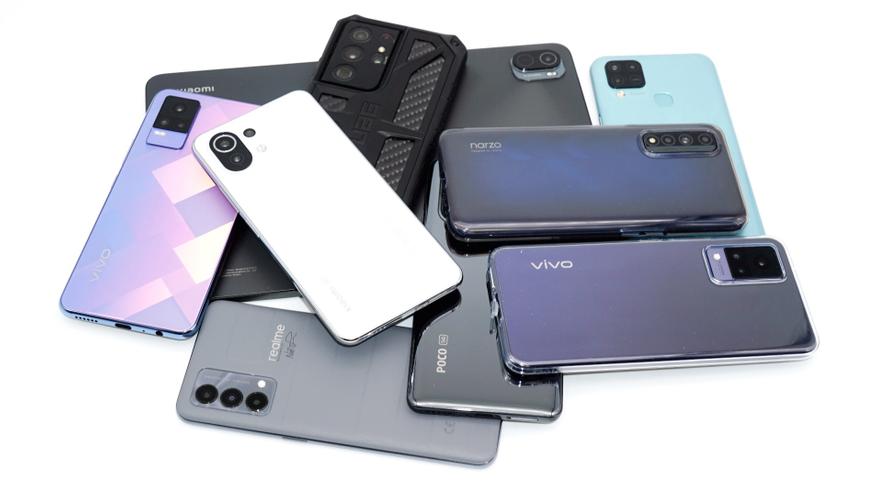
Содержание
- Для чего нужны мегапиксели и камеры высокого разрешения
- Для чего нужна оптическая стабилизация и какие есть способы фокусировки
- Какие бывают сенсоры в комбинированной камере
- Информация о камерах в приложении
- Таблица с характеристиками смартфонов
- Примеры современных смартфонов
- Смартфон Realme GT Master Edition
- Смартфон Samsung S21 Ultra
- Смартфон Vivo X60 Pro
- Смартфоны Vivo V21 и V21e
- Смартфон Xiaomi M11 Pro
- Смартфон TCL 10 Pro
- Смартфон Xiaomi Mi11 Lite 5G NE
- Смартфоны POCO X3 Pro и Xiaomi Black Shark 4
- Проверка камеры методом тестирования
- Примеры съемки Sony IMX
- Примеры съемки Samsung ISOCELL
- Примеры съемки OmniVision
- Примеры оптических искажений
- Свойства файлов фотографий
- Заключение и выводы
Для чего нужны мегапиксели и камеры высокого разрешения
Смартфонов с современными камерами на 50-64-108 и так далее мегапикселей всегда привлекают внимание. В курилке с коллегами или на встрече с подругами удобно показать новинку с необычной камерой. Это всегда вызывает определенный WOW-эффект, чем и пользуются маркетологи брендов. Но чтобы эти мегапиксели в камере оказались действительно «полезными», то следует сделать несколько шагов, которые помогут понять назначение камеры в вашем смартфоне. Я не буду рассматривать откровенные подделки с фейковыми камерами (а таковые до сих пор встречаются в продаже). Поговорим об актуальных моделях, которые могут обеспечить действительно качественную съемку.
Для начала подумайте и определите цели, для которых будет использоваться камеры искомого смартфона. Это могут быть панорамные снимки или снимки на природе при естественном освещении — тут справится обычная камера со средним разрешением. Для групповых снимков уже желательно иметь отдельный широкоугольный сенсор, дополнительно к основной камере. Нужно ли 4К-видео, SlowMo или стабилизация при съемке с рук. Если вы увлекаетесь предметной или макросъемкой, то пригодится отдельный сенсор с соответствующим увеличением. Аналогичная ситуация и с оптическим/цифровым увеличением: некоторые смартфоны могут обеспечивать увеличение кадра до 100 раз (!). Подобный же подход можно применить и для фронтальной камеры. Для детальных селфи-снимков выпускают смартфоны с 20/32/40 Мп фронтальными камерами, даже встречаются сдвоенные фронталки — для широкоугольных групповых селфи.
Ну и самое значимое: сенсоры одинакового разрешения могут совершенно различаться по качеству и давать абсолютно разное изображение. Чаще всего встречаются производители Sony (сенсоры IMX), Samsung (сенсоры ISOCELL), OmniVision.
Для чего нужна оптическая стабилизация и какие есть способы фокусировки
Для качественной съемки с рук во время движения (при ходьбе, на бегу) требуется не только качественная оптика, но и наличие стабилизации. Существует как EIS (электронная стабилизация), так и OIS (оптическая стабилизация). Электронная стабилизация предполагает выравнивание обрезанного кадра в пределах общего снимка. Могут быть использованы специальные технологии электронной стабилизации и сглаживания на основе информации от датчиков ускорения смартфона. Гораздо лучше работает оптическая стабилизация — непосредственное сглаживание колебаний на линзе или матрице камеры. Виды оптической стабилизации могут быть совершенно разные и работать по разным принципам. Ниже приведена схема устройства подвеса (Gimbal 2.0 stabilisation) у флагманов Vivo.

Способы фокусировки также оказывают влияние на качество фотографий, а также на выдержку. При малой выдержке нужна быстрая фокусировка. Обычно используют фазовую автофокусировку, применяя дополнительные фотосенсоры. У более дорогих смартфонов могут быть дополнительно установлены лазерные дальномеры для фокусировки методом LDAF.
Какие бывают сенсоры в комбинированной камере
Современные смартфоны стараются выделиться своими фотосвойствами. Основные камеры включаются в общее дизайнерское оформления тыльной панели, выделяются различным образом, привлекают внимание. Если не брать в расчет элементы дизайна, а говорить конкретно о функциональности, то выделю основную и вспомогательные сенсоры комбинированной камеры. Так же, как правило, рядом с камерами присутствует одно- или двухцветная вспышка, могут располагаться датчики для автофокусировки (лазерные).
Вспомогательные сенсоры могут служить для телефото, макрофото, широкоугольные, сенсоры для создания эффектов (боке), датчики глубины сцены (для увеличения резкости снимка и фокусировки). Основные камеры используются высокого разрешения, причем позволяют снимать как в HighRes (например, 48 Мп, 64 Мп, 108 Мп и т.д.), так и одновременно снимать в стандартном режиме (12 Мп, 16 Мп и т.д.). Последний режим получается в результате объединения информации с соседних пикселей. Информация высокого разрешения с основного сенсора, иногда в комбинации с вспомогательными сенсорами, используется для получения цифрового увеличения (10х, 100х и т.д.).
Ультраширокоугольные сенсоры предназначены для групповых снимков и характеризуются широким углом зрения (FOV ~ 120°). Обратите внимание, ультраширокоугольные сенсоры достаточно заметно искажает изображение по углам кадра и при приличном удалении от объектива. Если речь идет про оптическое увеличения, то могут встречаться отдельные сенсоры для 2х, 5х, 10х с соответствующей линзовой системой. Макросенсоры, как правило, имеют линзы с маленьким фокусным расстоянием. Для фокусировки могут применяться монохромные сенсоры с низким разрешением. Отмечу, что изредка попадаются необычные модели, укомплектованные дополнительно другими типами сенсоров. Например, модель Blackview BV6600 Pro оснащена тепловизионным сенсором FLIR с разрешением 80х60 точек.
В качестве примера можно рассмотреть бюджетный камерофон POCO M4 Pro. Мы видим оформленную в единый блок комбинированную камеру, состоящую из основного сенсора (в самом верху) на базе сенсора Samsung ISOCELL S5KJN1 на 50 Мп (f/1.8), Чуть ниже и левее — ультраширокоугольный сенсор на 8 Мп (f/2.2, FOV 119°). Правее расположена вспышка.
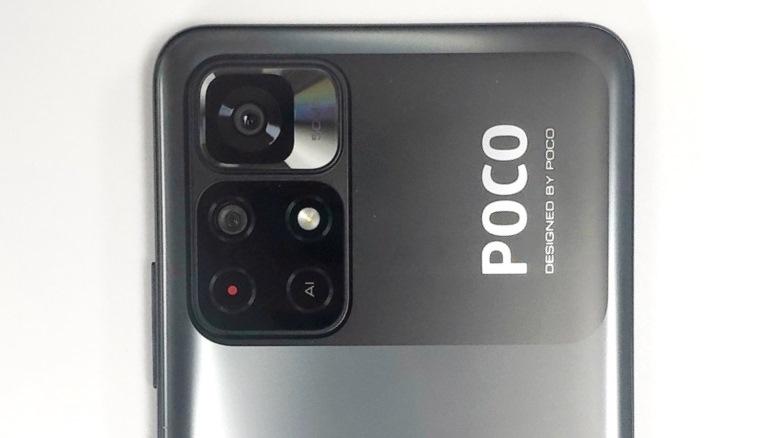
Информация о камерах в приложении
Для того, чтобы не ошибиться и узнать наверняка про используемые сенсоры, можно воспользоваться утилитами для теста. Например, проверка приложением Device Info HW показывает наличие конкретные фотосенсоров в смартфоне.
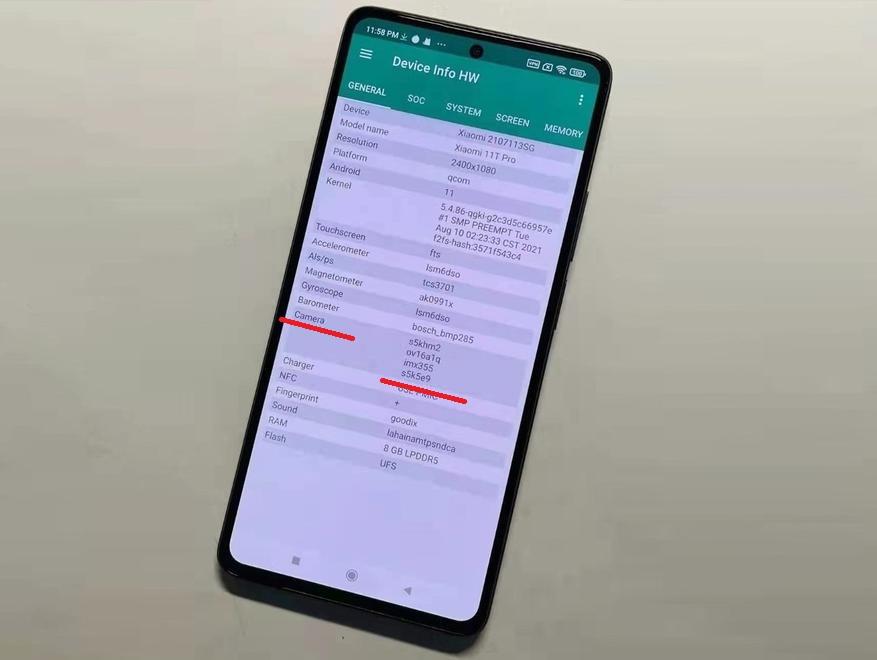
Это может быть и другое приложение, которое обеспечит отображение сенсоров камер. По наименованию всегда можно «вычислить» назначение конкретного сенсора и его разрешение. Например, на скриншоте фигурирует S5KHM2. Это сенсор высокого разрешения Samsung ISOCELL на 108 Мп. На следующем скриншоте сенсор S5K3J1 повторяется два раза — это не ошибка. Два одинаковых сенсора используются для реализации оптического увеличения: один установлен с линзой на 3х увеличения, второй — с линзой на 10х.
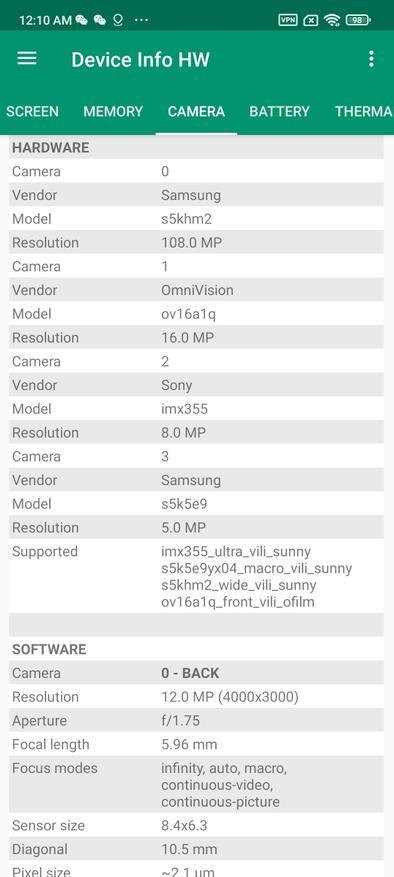

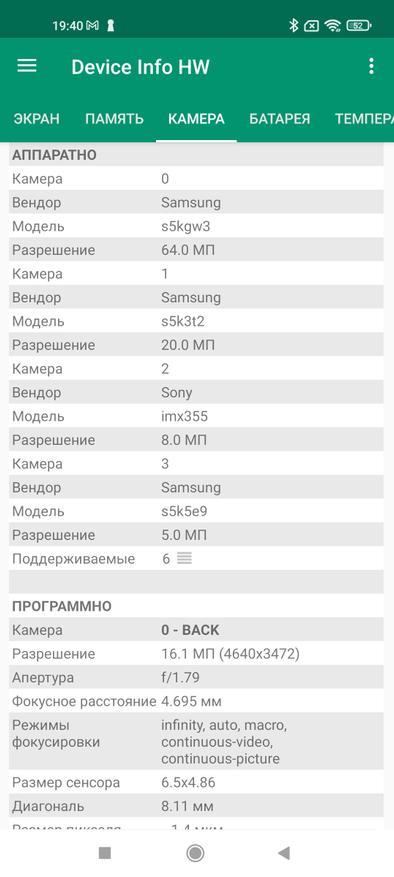

Таблица с характеристиками смартфонов
Для уточнения информации можно воспользоваться любыми доступными источниками информации. Это могут быть не только приложения и тестовые пакеты, но и сторонние сайты (например, gsmarena.com) и обзоры конкретных моделей смартфонов. Для удобства я привел протестированные лично модели в единую таблицу. По ссылкам доступны подробные обзоры и тесты, включая тест камеры.
| Результаты | Antutu | Разрешение камеры | Тип сенсора | Стабилизация |
| Смартфон Samsung S21 Ultra | 697748 | 108 Мп | Samsung ISOCELL S5KHM3 | EIS/OIS |
| Смартфон Vivo V21 | 396870 | 64 Мп | Samsung ISOCELL S5KGW3 | EIS/OIS |
| Смартфон Vivo V21e | 347988 | 64 Мп | Samsung ISOCELL S5KGW3 | EIS/OIS |
| Смартфон TCL 10 Pro | 252545 | 64 Мп | Samsung ISOCELL Bright S5KGW1 | EIS |
| Смартфон Xiaomi M11 Pro | 358076 | 108 Мп | Samsung ISOCELL S5KHM2 | OIS |
| Смартфон Realme GT Master Edition | 538923 | 64 Мп | Omnivision OV64B | EIS |
| Смартфон Xiaomi Mi11 Lite 5G NE | 526917 | 64 Мп | Samsung ISOCELL S5KGW3 | EIS |
| Смартфон Xiaomi Mi11 Lite | 351435 | 64 Мп | Samsung ISOCELL S5KGW3 | EIS |
| Смартфон Vivo X60 Pro | 710723 | 48 Мп | Sony IMX598 | OIS |
| Смартфон ZTE Nubia RedMagic 5G | 638565 | 64 Мп | Sony IMX686 | EIS |
| Смартфон Xiaomi Black Shark 4 | 599502 | 48 Мп | Sony IMX582 | EIS |
| Смартфон Poco X3 Pro | 542953 | 48 Мп | Sony IMX582 | EIS |
| Смартфон POCO X3 NFC | 278665 | 64 Мп | Sony IMX682 | EIS |
| Смартфон POCO M4 PRO | 387476 | 50 Мп | Samsung ISOCELL S5KJN1 | EIS |
| Смартфон POCO M3 PRO | 319078 | 48 Мп | OmniVision OV48B | EIS |
| Cмартфон POCO M3 | 180575 | 48 Мп | OmniVision OV48B | EIS |
| Смартфон POCO F3 5G | 718988 | 48 Мп | Sony IMX582 | EIS |
| Смартфон Xiaomi Redmi Note 10 | 223211 | 48 Мп | Sony IMX582 | EIS |
| Смартфон OnePlus Nord N10 5G | 316006 | 64 Мп | Omnivision OV64B | EIS |
| Смартфон Infinix ZERO 8 | 290582 | 64 Мп | Sony IMX686 | — |
| Смартфон Oppo Reno 4 Lite | 214512 | 48 Мп | Samsung ISOCELL S5KGM1 | — |
Примеры современных смартфонов
А чтобы была возможность сравнить непосредственно популярные модели, я привожу описание тыловых (и фронтальных) камеры для ряда актуальных моделей. Смартфоны ниже оснащены приличными сенсорами на 48…64 Мп (и даже на 108 Мп). Можно наглядно увидеть отличия, особенно в части дополнительных сенсоров (иногда отсутствует ульраширокоугольный сенсоры, иногда — макросенсор).
Смартфон Realme GT Master Edition
Начну с одной из самых интересных моделей 2021 года. Это предтоповый смартфон Realme GT Master Edition с примечательным дизайном от Наото Фукасавы. Тройная тыловая камера представляет собой вертикальный блок с основным сенсором Omnivision OV64B на 64 Мп (f/1.8, 6 линз в пакете) с фазовой автофокусировкой (PDAF). Чуть ниже размещен ультраширокоугольный сенсор Sony IMX355 на 8 Мп (f/2.3, FOV 119°). Далее находится макросенсор Omnivision OV02B10 на 2 Мп (f/2.4).
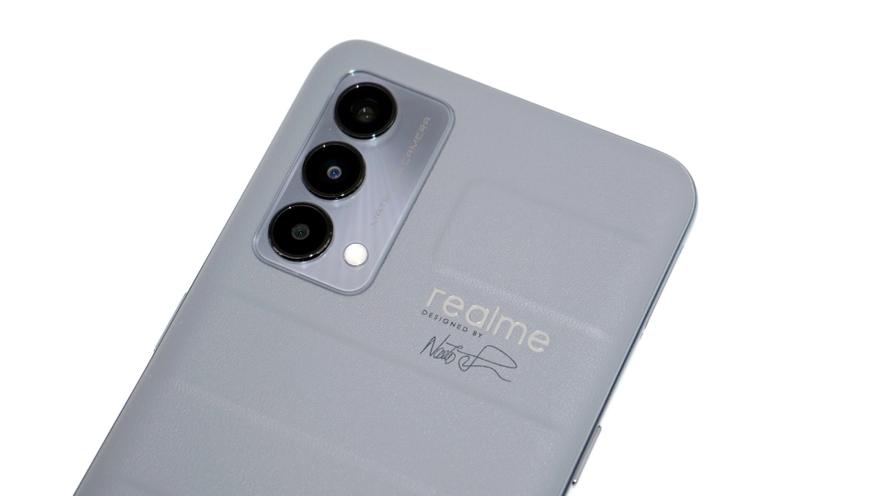
Смартфон Samsung S21 Ultra
Не менее интересно будет взглянуть на флагман от Samsung. В самом верху расположен ультраширокоугольный сенсор Sony IMX563 на 12 Мп (F2.2, FOV 120°). Чуть ниже (в центре) располагается основной сенсор с высоким разрешением — Samsung ISOCELL S5KHM3 на 108 Мп (F1.8). Отмечу фазовую и лазерную автофокусировку. В самом низу располагается перископная камера Samsung S5K3J1 на 10 Мп с оптическим 5х/10х увеличением (F4.9 PDAF, OIS). Справа расположено окно лазерного дальномера для автофокусировки (LDAF), светодиодная вспышка, а также сенсор трехкратного увеличения Samsung S5K3J1 (также на 10 Мп, F2.4). Все сенсоры имеют фазовую автофокусировку, основной и сенсоры оптического увеличения — комбинированную систему стабилизации (OIS+EIS). Фронтальная камера Samsung S5KGH1 на 40 Мп (F2.2).
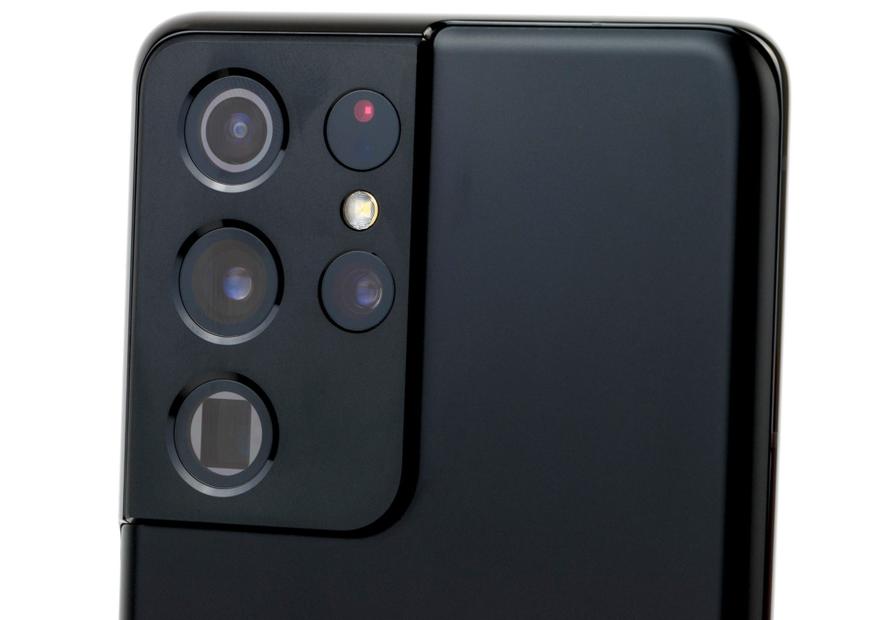
Смартфон Vivo X60 Pro
Еще один флагман — смартфон Vivo X60 Pro, может похвастать оптической стабилизацией на базе подвеса (Gimbal 2.0 stabilisation). Модель примечательна оптикой Carl Zeiss, основной сенсор на базе Sony IMX598 на 48 Мп (f/1.5), ультраширокоугольный сенсор Samsung ISOCELL S5K3L6 на 13 Мп ( f/2.2, FOV 120°). Аналогичный сенсор S5K3L6 на 13 Мп выступает в роли вспомогательного датчик изображения/макрокамеры.
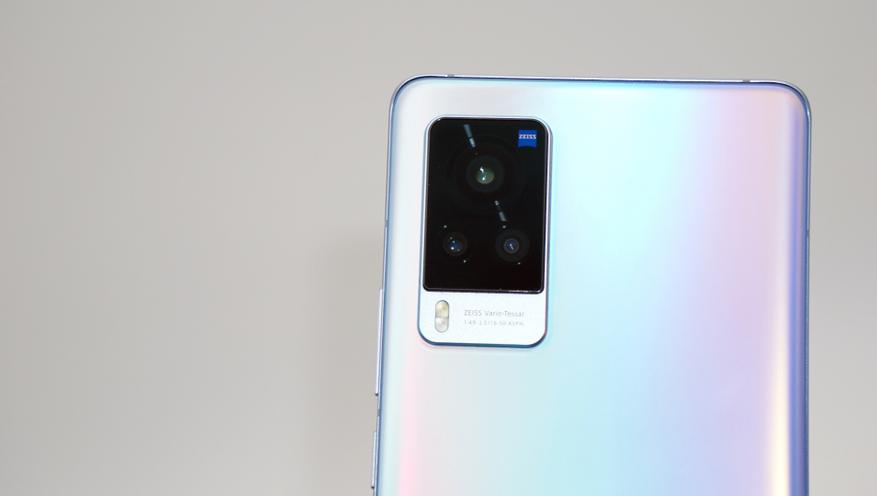
Смартфоны Vivo V21 и V21e
Более доступный вариант камерофонов от Vivo- это модели Vivo V21 и Vivo V21e. Отмечу сенсор высокого разрешения Samsung ISOCELL S5KGW3 на 64 Мп (f/1.8, PDAF, OIS) в качестве основной камеры. Дополнительно установлен ультраширокоугольный сенсор OmniVision OV8856 на 8 Мп (f/2.2, FOV 120°). Cенсор OmniVision OV02B10 на 2 Мп (f/2.4) используется при создании эффектов (боке) и макросъемки.

Смартфон Xiaomi M11 Pro
Для флагмана M11 Pro от Xiaomi используется Samsung ISOCELL S5KHM2 на 108 Мп (f/1.75, 7 линз в пакете). Для широкоугольных снимков используется SONY IMX355 на 8 Мп (f/2.2, FOV 120º), а также вспомогательный сенсор Samsung S5K5E9 на 5Мп (f/2.4).

Смартфон TCL 10 Pro
Дизайн камер может стать частью маркетингового привлечения покупателей. Например, у смартфона TCL 10 Pro крайне необычный дизайн размещения четырех сенсоров и двух отдельных фотовспышек в единый блок. В качестве основного сенсора используется Bright S5KGW1 от Samsung на 64 Мп (f/1.79). Для широкоугольной съемки используется Samsung ISOCELL S5K3P9 на 16 Мп (f/2.4), а сенсоры GalaxyCore GC5035 на 5 Мп (f/2.2) и Omnivision OV02K10 на 2 Мп (f/2.4) обеспечивают макроснимки, эффекты съемки и комбинированный (оптический + цифровой) зум соответственно.
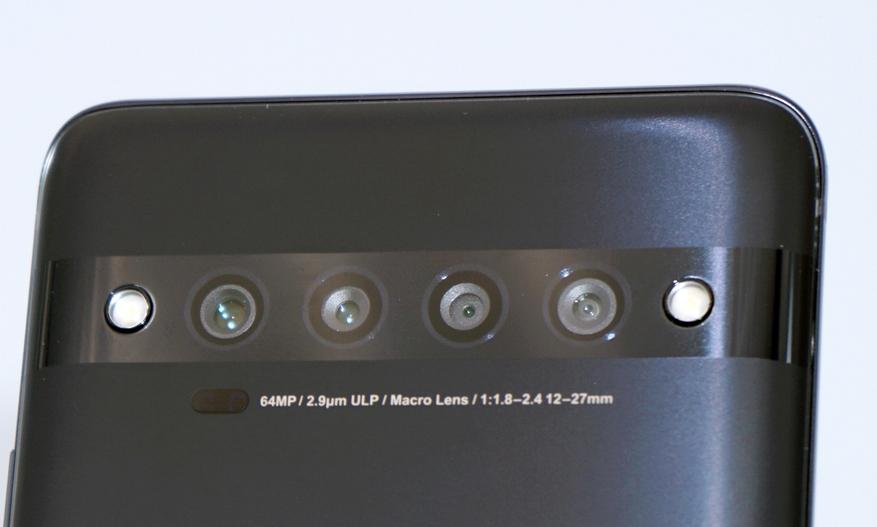
Смартфон Xiaomi Mi11 Lite 5G NE
Достаточно интересный и стильный камерофон Xiaomi Mi11 Lite 5G NE — на базе сенсоров Samsung GW3 S5KGW3 на 64Mп (1/1.8″). За широкоугольную съемку отвечает Sony IMX355 на 8 Мп (f/2.2), а за эффекты и макро — Samsung S5K5E9 на 5Мп (f/2.4).
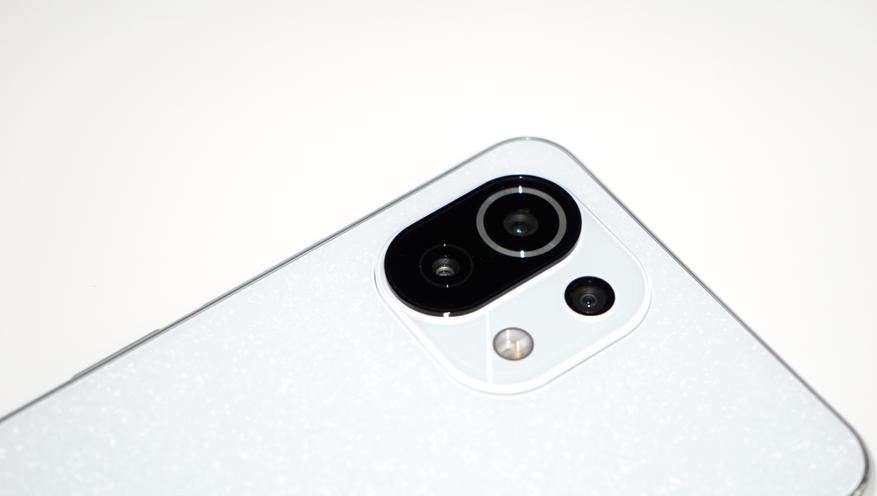
Смартфоны POCO X3 Pro и Xiaomi Black Shark 4
Две проверенных модели: POCO X3 Pro и Xiaomi Black Shark 4 — на базе неплохого сенсора Sony IMX582 на 48 Мп. Отмечу, что базовая версия POCO X3 NFC использует сенсор более высокого разрешения — Sony IMX682 на 64 Мп.
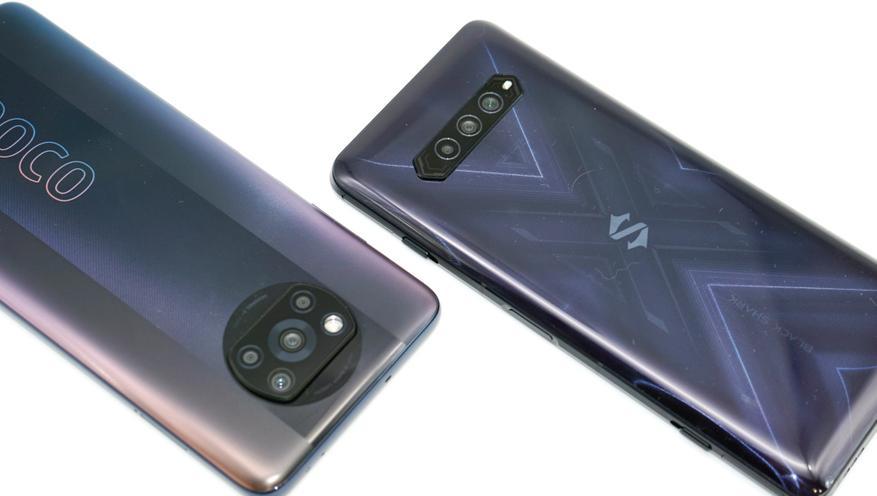
Проверка камеры методом тестирования
Если с характеристиками определились и узнали как проверить конкретные установленные сенсоры в смартфоне, то можно переходить к проверке камеры непосредственно. Во-первых, сделайте тестовые снимки в максимальном разрешении. Для того чтобы активировать настройку HighRes фотографии, нужно поискать соответствующий значок в шторке камеры или на нижней панели. Как вариант — активировать настройку в опциях. Во-вторых, проверьте результат (увеличение, свойства). В-третьих, проверьте необходимые пункты в меню камеры (режимы съемки, настройки, дополнительные функции и т.д.).
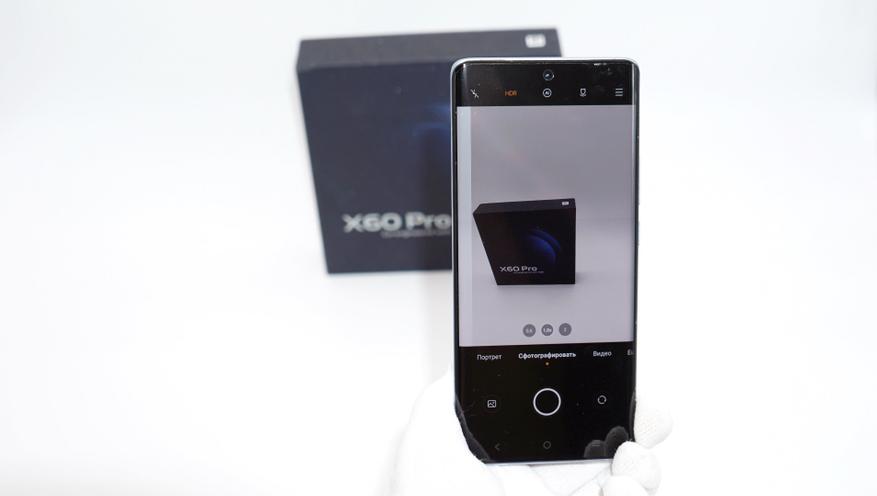
В зависимости от версии программного обеспечения, приложения для камеры могут отличаться по расположению функций, опций и режимов. При наличии широкоугольной камеры будет возможность снять в 0.6х (или ultra wide). При наличии оптического зума будут опции съемки в 2х/5х/10х. Могут присутствовать дополнительные режимы съемки: ночная, портретная, ручная, панорамная и т.д. Как правило, режим съемки в высоком разрешении (48/64/108 Мп) выключен по умолчанию и активируется отдельно в шторке или в меню.
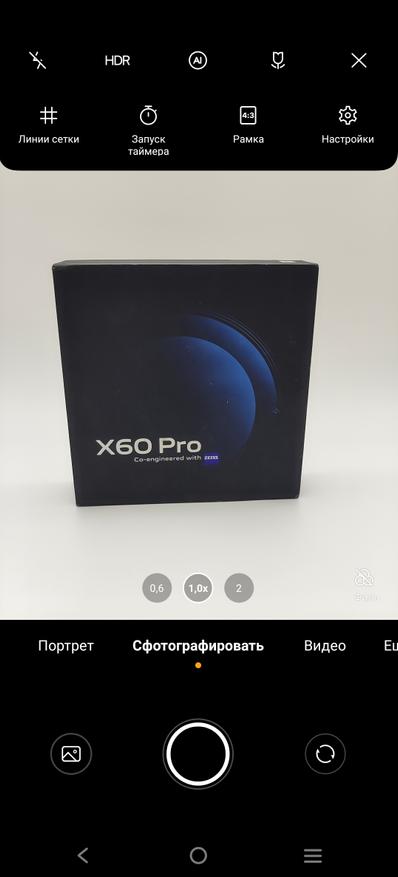
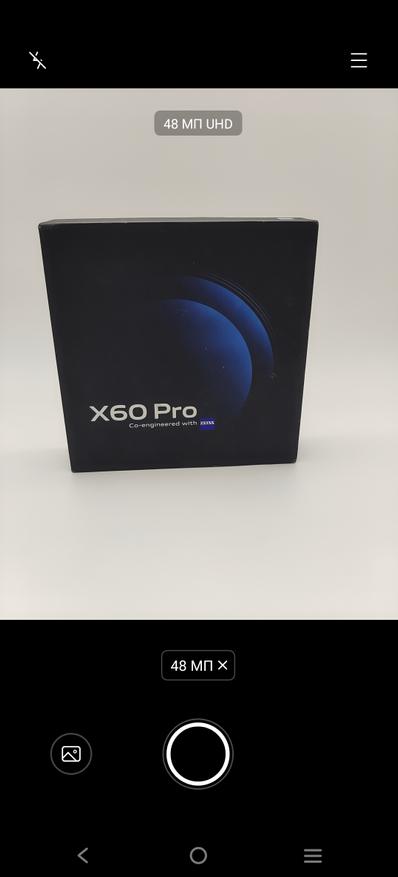
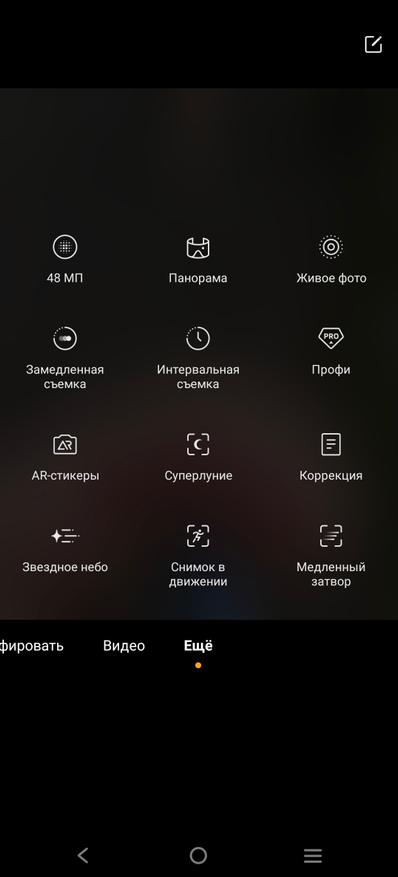
Для теста желательно выбрать ясную солнечную погоду и сфокусироваться на объекте. Увеличьте снимок. Не должно быть размытия или признаков интерполяции. Обратите внимание на прямые линии в перспективе — качественная оптика на дорогих смартфонах будет давать четкое изображение, а на бюджетных моделях, где «сэкономили» можно встретить подобные искажения.
Примеры съемки Sony IMX
Приведу примеры уже сделанных снимков в высоком разрешении, которые изъял из обзоров смартфонов по ссылкам выше. Для начала — пример съемки сенсора Sony IMX598 на 48 Мп со смартфона Vivo X60 Pro.
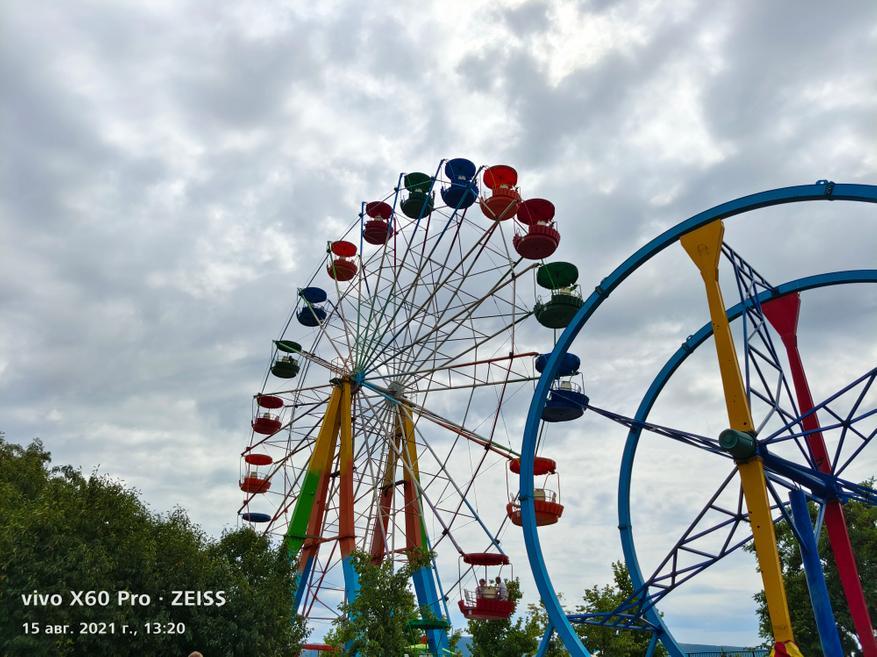

Качество цветопередачи достаточно неплохое, снимки четкие. Если увеличить участок фотографии и сделать кроп, то можно проанализировать снимок в деталях. Отмечу высокую четкость, минимальный шум, приличную резкость на участках фотографий ниже.


Приведу еще один пример со смартфонов POCO X3 Pro и Xiaomi Black Shark 4. Как я уже сказал выше, обе модели оснащаются сенсором Sony IMX582 на 48 Мп.


Цветопередача ничуть не хуже, снимки резкие и четкие. При увеличении можно рассмотреть фотографии в деталях.


Примеры съемки Samsung ISOCELL
Достаточно интересно будет сравнить снимки с аналогичными результатами смартфонов на базе сенсоров Samsung ISOCELL S5KGW3. Например, с Vivo V21 или V21e. Ниже пример съемки Samsung ISOCELL S5KGW3 на 64 Мп.
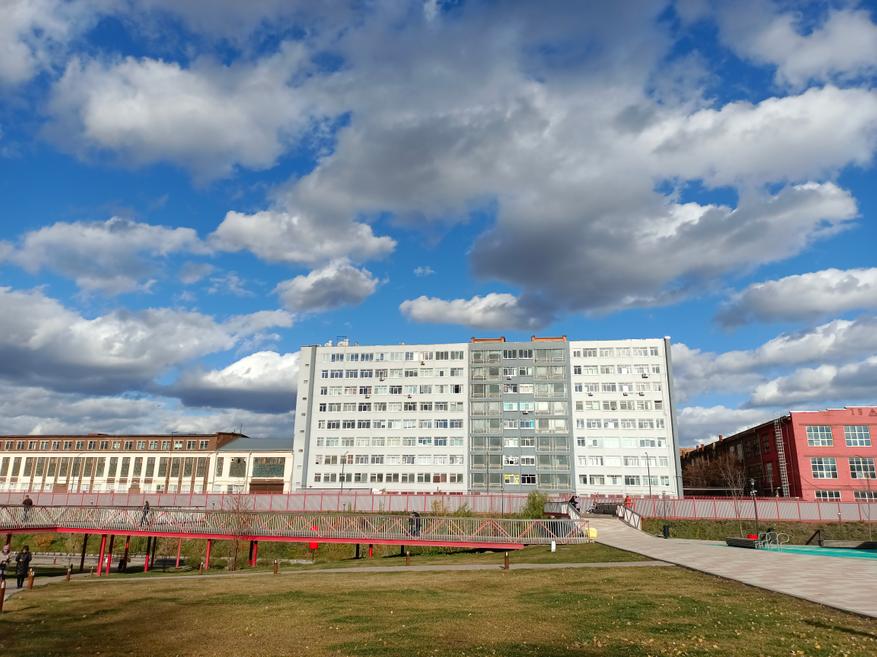

Отмечу несколько другую цветопередачу, но также яркую. Снимки сочные, кропы — детальные. Если увеличить кадр, то увидим прямые линии, отсутствие «мыла», правильную перспективу.

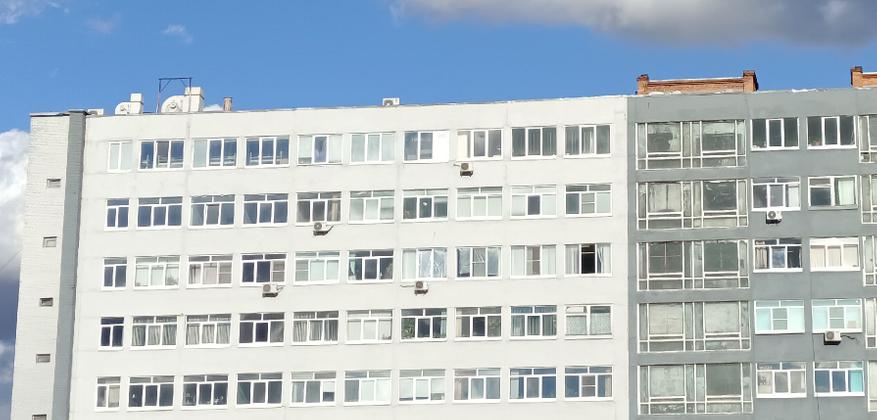
Примеры съемки OmniVision
Еще один пример съемки для сенсоров OmniVision. В качестве «подопытного» смартфона выступает Realme GT Master Edition с OV64B на 64 Мп. Я бы сказал, что OmniVision устанавливается в бюджетные модели, но… качество снимков достаточно приличное и не уступает флагманским моделям.

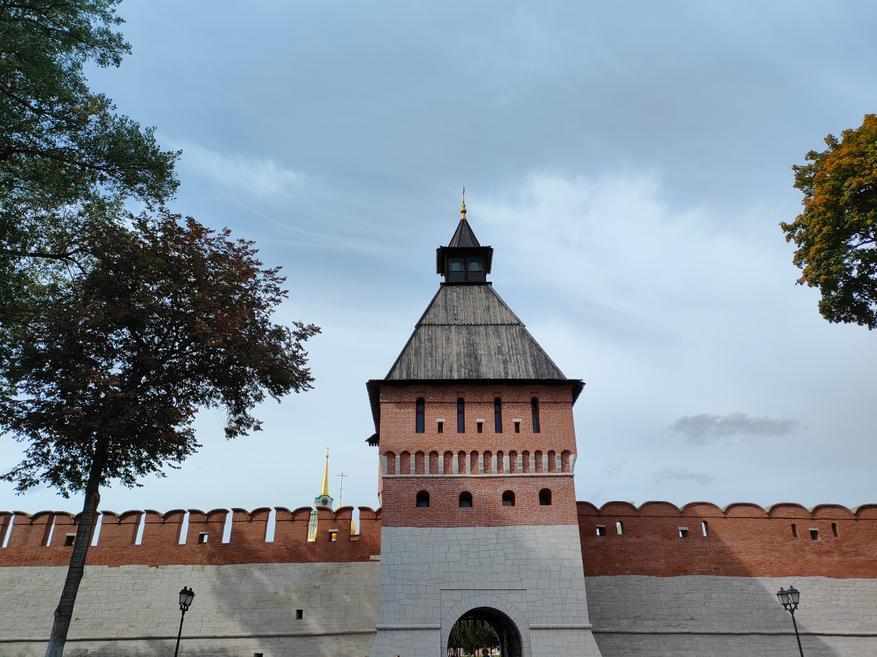
При увеличении OmniVision также показывает высокое качество и детальный снимок.
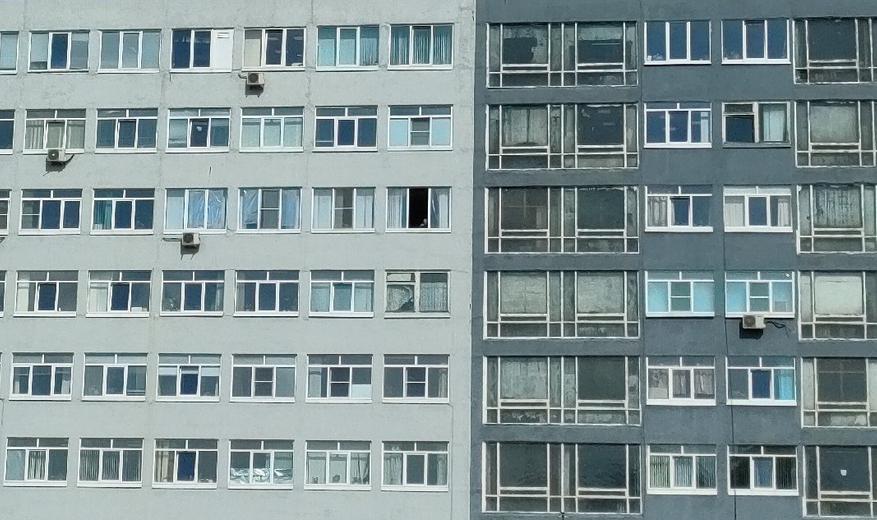
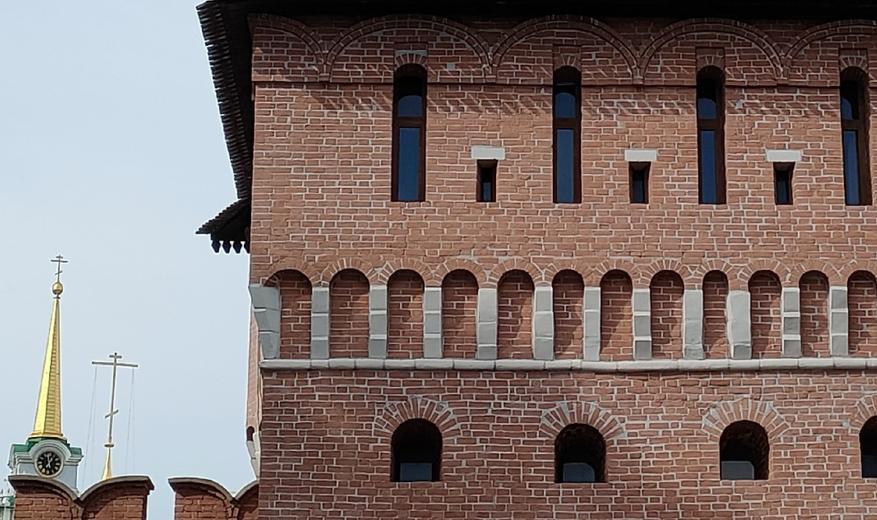
Небольшая ремарка: вполне могут встретиться смартфоны с сенсором высокого разрешения (например, OmniVision на 48 или 64 Мп), но с дешевой оптикой. Такие смартфоны будут выдавать зашумленные снимки, с размытыми деталями. Также отмечу программную обработку фотографий. Ряд производителей, например, Xiaomi могут искусственно повышать цветопередачу, делая снимки ненатурально яркими, искажая картинку. Для кого-то это может быть приемлемо. Для кого-то будет желательна натуральная картинка. Это дело вкуса. Постобработку снимков всегда можно сделать как на компьютере, так и на смартфоне с помощью профильных приложений (LR и т.д.). Для этого удобно, если смартфон умеет сохранять изображения в RAW-формате.
Примеры оптических искажений
Выше я упоминал зависимость результата от используемой оптической системы. Приведу несколько примеров неудачной комбинации сенсора и оптики в смартфоне. Например, в OnePlus Nord N10 несмотря на приличный сенсор Omnivision OV64B картинка по краям искажается. На снимках при увеличении деталей, близких к границе кадра видны искривления прямых линий и перспективы, наклон вертикальных линий в сторону.
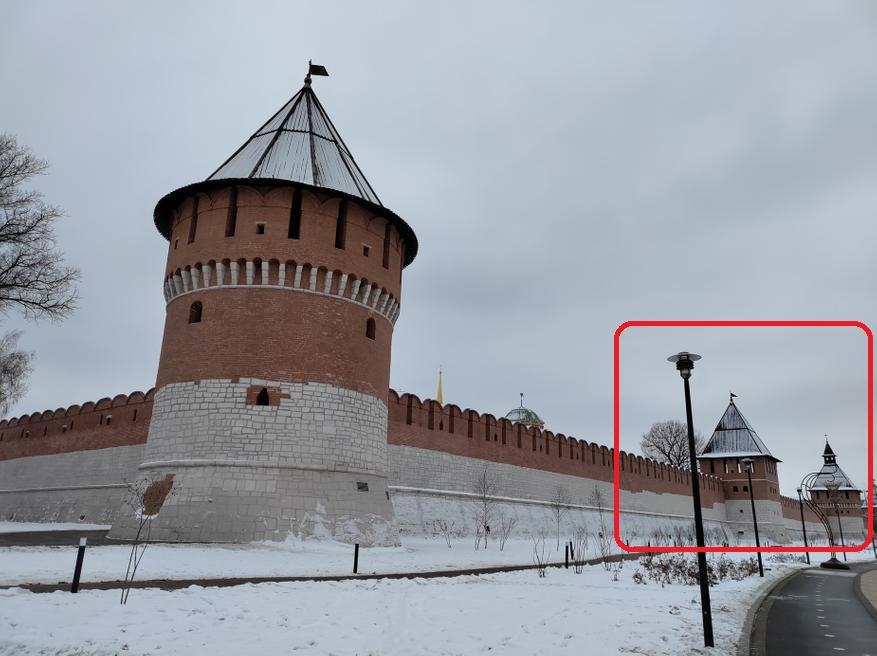

Аналогичная ситуация выглядит и для бюджетного камерофона POCO M3. Если увеличить участок, близкий к границе кадра, то можно увидеть размытые объекты или не в фокусе.


Ситуация еще хуже у смартфона Oppo Reno 4 Lite, несмотря на приличный сенсор Samsung ISOCELL S5KGM1 на 48 Мп. Если взять фотографию, сделанную при хорошем освещении и увеличить участок…
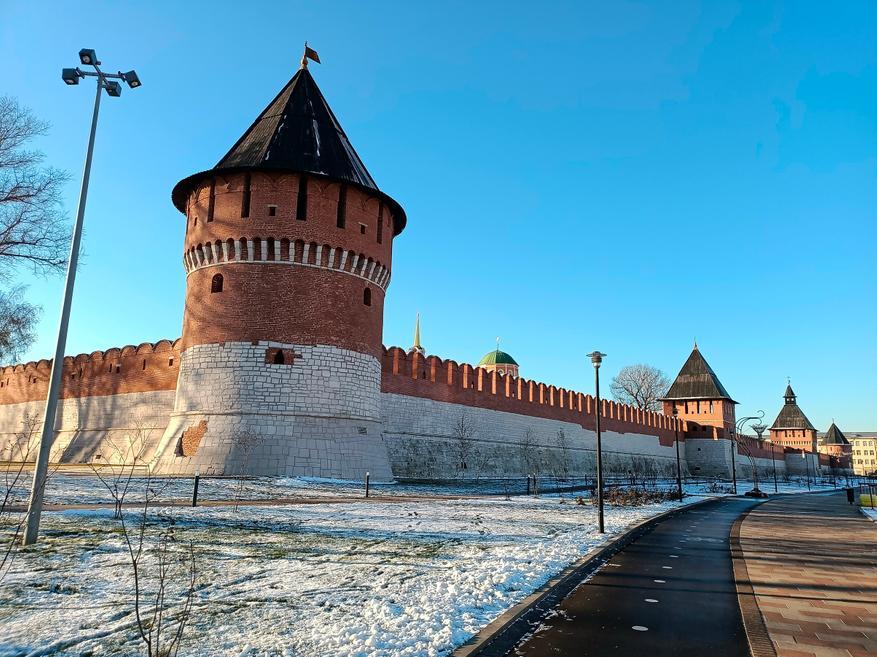
… то увидим, что в кадре обильно присутствует шум, расфокусированы мелкие детали заднего плана, имеется искажения цветопередачи и перспективы. Увы, но это действительно хороший пример, когда количество мегапикселей не имеет значение.
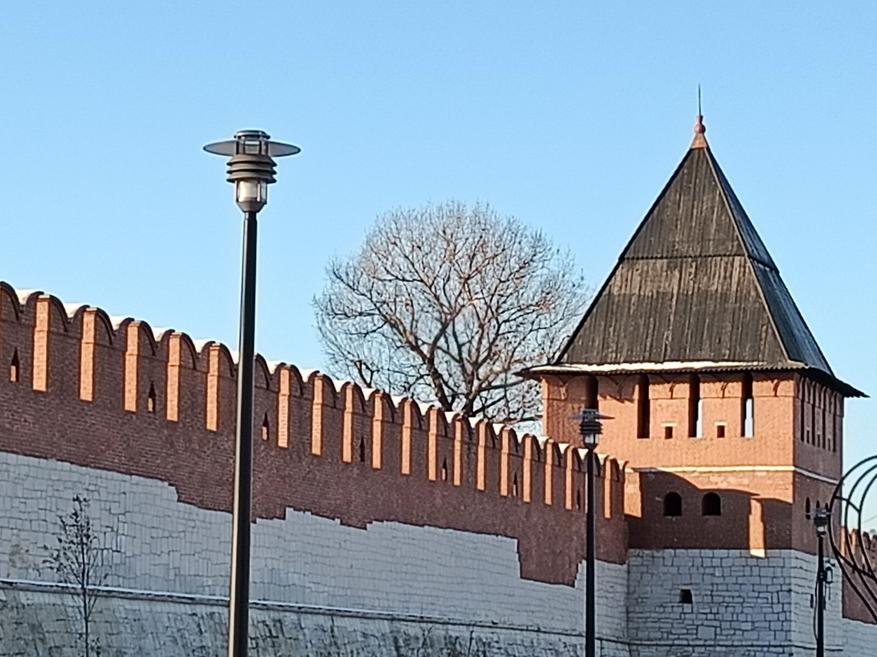

Аналогичная ситуация и у бюджетника Infinix Zero 8. При сильном увеличении появляется шум, размытость и нечеткость.


Какой толк от такой камеры высокого разрешения, если при сильном увеличении теряются абсолютно все мелкие детали и размываются на заднем фоне? Это риторический вопрос.
Свойства файлов фотографий
Достаточно многое могут сказать свойства файлов фотоснимков, которые были сделаны на конкретном смартфоне. Для этого можно открыть файловый менеджер прямо на смартфоне и выбрать «Свойства» в контекстном меню. При максимальном разрешении размер фотографии будет около 8000 х 6000 точек (для камер на 48 Мп) или 9216 х 6912 точек (для камер на 64 Мп). При этом обычное значение будет 4000 х 3000 или 4608 х 3456 точек соответственно. Еще один момент — для топовых камер на 108 Мп разрешение фотографий составляет 9024 х 12032 точек, а размер файла — около 20 Мб. Учитывайте это при выборе.
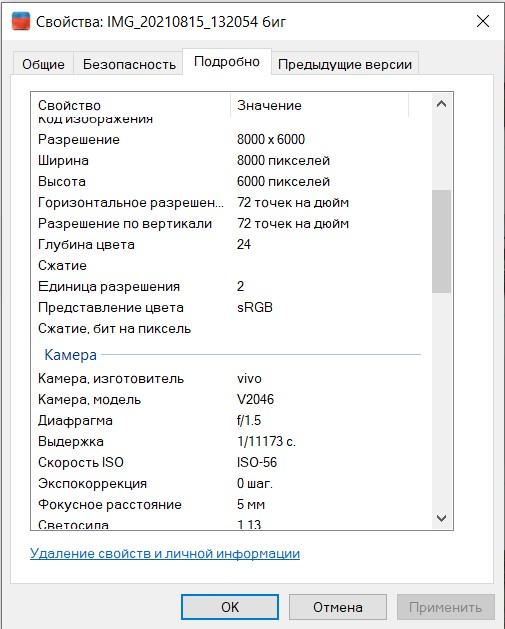
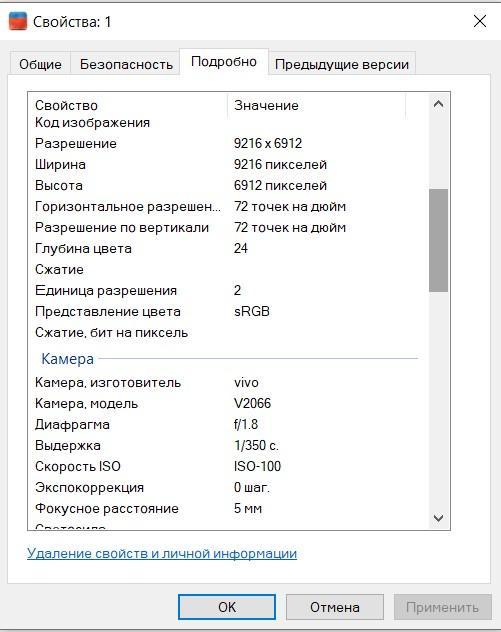

Так что при покупке постарайтесь сделать тестовый снимок и проверьте свойства файлов фотографий. Это всегда можно сделать в шоуруме или при осмотре смартфона. То же самое касается и снимков с фронтальных камер.
Заключение и выводы
Я специально не стал заострять внимание на дополнительных режимах съемки (портретный, специальные режимы), возможностях ручной съемки, а также на видеосъемке. Отмечу, что возможности записать ролик в честном 4К@30fps или SlowMo вполне могут стать ключевым фактором при выборе конкретной модели.
Также хочу обратить внимание на то, почему не стоит гнаться за маркетинговыми новинками аля «новый сенсор на 50 Мп», или «новейшая камера на 108 Мп». Безусловно, новые смартфоны могут дать картинку высокого разрешения, которую можно приближать и приближать. Но в итоге получается что-то вроде мутного пятна с размытыми деталями, искажениями прямых линий и приличным уровнем шума на снимке.
По приведенным примерам выше могу обоснованно сказать, что гораздо проще и надежнее взять смартфон с проверенным сенсором Sony IMX582 на 48 Мп, чем «повестись» на призывы рекламщиков и взять что-то на базе OmniVision. Но качественное отличие будут иметь модели с реально хорошей оптикой. Это не обязательно должна быть брендовая оптика (Hasselblad, Carl Zeiss и прочее), достаточно иметь просчитанный пакет линз для устранения аберраций и других видов искажений, а также изготовленный из приличных материалов.
А если вы занимаетесь профессиональной или любительской съемкой, то постарайтесь выбрать смартфон с поддержкой оптической стабилизации камеры — это будет наиболее заметно по результатам. В любом случае, выбрать смартфон с качественной камерой вполне возможно. Главное — представлять для себя его назначение и правильно ориентироваться в моделях и установленных сенсорах.
Дополнительно можно посмотреть рекомендательные статьи:
Подборка актуальных смартфонов с продвинутой камерой (48-64 Мп).
Подборка полноэкранных смартфонов без чёлок и без отверстий под фронтальную камеру.
Подборка актуальных смартфонов на производительном процессоре Qualcomm Snapdragon.
С другими тестами и обзорами смарт-гаджетов и техники, а также подборками вы можете ознакомиться по ссылкам ниже и в моем профиле.
Узнать, хорошо ли фотографирует и снимает видео смартфон, почти всегда удается только из обзоров — слишком много непонятных характеристик камер. На что, например, влияет размер диафрагмы? Сколько модулей камере нужно? И почему смартфон с камерой на 15 МП стоит дороже другого, у которого 48 МП? Чтобы не пугаться в непонятных терминах и уметь отличать хорошую камеру от плохой без фото, мы и сделали этот гайд.
Сколько мегапикселей нужно?
О том, что не в мегапикселях счастье, уже знают многие пользователи цифровой фототехники. Данная характеристика говорит лишь о том, какие размеры будет иметь фото при просмотре на дисплее, но не более того. Когда разрешение камер смартфонов было 2 – 3 МП, каждый лишний мегапиксель был действительно серьезным преимуществом. Это как с мощность двигателя в первых автомобилях — грузовичок на 20 лошадок мог увезти гораздо больше груза, чем колымага на 5 лошадиных сил. Но когда пересчет пошел на сотни л.с., смысла в этом измерении для простого автолюбителя стало мало. С мегапикселями та же история, заявленное разрешение матриц смартфонов стало таким, что дает возможность печатать снимки приемлемого качества форматом чуть ли не А1. Хотя в большинстве случаев хватило бы обычного HD для инстаграма.
Больше модулей камеры — лучше?
 |
Еще совсем недавно все было предельно просто. Смартфоны обладали фронтальной камерой для селфи, и основной камерой для создания фото и видеороликов. Затем появились двойные камеры со вспомогательным модулем. Зачастую он был просто монохромным, якобы для лучшего восприятия проходящего света через линзу камеры. Это позволяло создавать более качественные и детализированные фотографии либо же делать черно-белые фотографии без применения фильтров.
На начало 2020 года большинство современных смартфонов оснащены тройными камерами с основным модулем, ультрашироким объективом для панорамной съемки и вспомогательным модулем для качественного эффекта размытия. Вообще, качество и предназначение модулей может разниться от модели к модели, а у многих современных камерофонов вместо трех модулей зачастую используются четыре.
Популярные смартфоны с 3 камерами
В целом, существует пять вариантов того, какие камеры могут быть установлены в смартфоне:
- Широкоугольный объектив — объектив для создания широких снимков. Во многих современных моделях основной объектив является широкоугольным. В таком случае дополнительный объектив становится сверхширокоугольным, позволяя захватить в кадр еще больше объектов. Полезная штука при съемке панорам или больших компаний.
- Телеобъектив — объектив с узким полем зрения для съемки с увеличением;
- Черно-белый сенсор — позволяет снимать с большей резкостью, получать более глубокие тени и яркие блики;
- Датчик для ночной съемки — позволяет создавать четкие снимки в темноте и при слабом освещении;
- Дополнительный сенсор для анализа глубины — помогает двум основным объективам создавать снимки с правильной глубиной резкости.
 |
Что все это дает нам? В теории несколько камер делают снимки, а затем ПО сшивает их вместе для пост-обработки. Так мы соберем больше света, получим несколько снимков с разной глубиной резкости, а также сможем одинаково четко снимать и самые темные, и самые светлые детали. Но тут есть множество нюансов, которые зависят от конкретной модели. К примеру, в недорогих смартфонах камеры зачастую работают отдельно друг от друга, а в режиме фотографии вы просто выбираете нужную. То есть, это скорее вопрос вариативности, а не качества. В камерофонах подороже модули могут быть связаны самым разным образом, хитро переключаясь друг между другом и т.д.
Главное, что тут нужно понимать — это то, что количество самих модулей напрямую не влияет на качество фотографии, а смартфон за $200 не будет снимать на уровне Galaxy S10 только потому, что в обоих тройные камеры. Тем более, что тот же Samsung Galaxy S8 2 SIM или Google Pixel 2 64 ГБ / Dual снимали шикарные кадры, используя один модуль. Поэтому много камер — это хоть и важный фактор, но отнюдь не критический.
На что смотреть вместо мегапикселей?
 |
Плотность пикселей
Как мы уже разобрались, много пикселей не дают никакой гарантии, что смартфон будет делать крутые кадры. Поэтому лучше, чтобы в камере смартфона было меньше толковых пикселей, чем много бестолковых. Размер пикселя в камере измеряется в микрометрах (мкм/µm). Сегодня время экспериментов прошло и производители пришли к обобщенным цифрам: 1.2 мкм для недорогих моделей, 1.4 и выше для камерофонов.
Диафрагма
Как и растениям, камере смартфона нужен свет: чем больше света, тем проще работать матрице. Показатель того, насколько широко раскрыты «глазища» камеры, называют диафрагмой, апертурой, либо светосилой и обозначают дробью с буквой f. Чем она меньше, тем лучше. На начало 2020 года даже в недорогих смартфонах калибра Xiaomi Redmi Note 8 32 ГБ светосила основной камеры составляет f/1.8. Хотя еще пару лет назад такие показатели были в основном у флагманских моделей. У нынешних камеровфонов типа Samsung Galaxy S10 128 ГБ и Huawei Mate 30 Pro 128 ГБ / 5G показатель светосилы обычно держится на уровне f/1.5 или f/1.6.
Только примите во внимание, что сама по себе диафрагма не гарантирует качество фото как на обложке глянца — это просто размер смотрового окна, через которое камера смотрит на мир. Более важными показателями является качество сенсора и линз, но при прочих равных лучше выбирать смартфоны с лучшими показателями светосилы, чтобы камере не приходилось «щуриться».
 |
Диагональ матрицы
Диагональ матрицы традиционно указывается в дробных частях дюйма — соответственно, к примеру, сенсор на 1/2.3″ будет крупнее, чем 1/2.6″. Более крупные матрицы считаются более продвинутыми, так как при том же разрешении они позволяют добиться лучшего качества изображения.
Фокусное расстояние
Фокусное расстояние — физическая характеристика оптической системы, определяющая ее основные свойства и, главным образом, увеличение и угловое поле. Идеальных параметров тут нет: большее фокусное расстояние дает меньший угол обзора и более крупный размер предметов в кадре, а небольшое фокусное расстояние наоборот позволяет уместить в кадре больше происходящего. Для современных смартфонов на несколько камер этот показатель не так критичен, так как для каждого модуля камеры подбирается свое оптимальное фокусное расстояние. К примеру, у основного объектива этот показатель составляет 18 – 28 мм, а у ультраширокого 12 – 16 мм.
Модель сенсора
 |
В теории, знание названия сенсора камеры здорово упростило бы выбор. Ищи себе хороший сенсор, который использовали во флагманах, и радуйся отличным фото. Однако теорию быстро размазывает по скалам реальности, многие производители недорогих смартфонов покупают популярные сенсоры Sony, кричат в рекламной компании «у нашего смартфона камера как в Galaxy S10», а на деле оказывается пшик — линзы у камеры паршивые, софт кривой и все в этом духе.
Если же вдаваться в подробности, то мы увидим, что большую часть рынка занимает Sony. Именно ее сенсоры стоят в большинстве современных камерофонов. Следом за ней идут Samsung и OmniVision. Одними из самых популярных вариантов на конец 2019 года был Sony IMX586, который помог развеять предубеждение о том, что только флагманы обладают приличными камерами. Отличительная черта – это возможность объединять 4 небольших пикселя в один большой, что в теории дает более яркие и детализированные фотографии.
Популярные смартфоны с ТОП камерой по версии DxOMark
Его главным конкурентом является Samsung Galaxy Bright GM1, который умеет создавать кадры размером 4000х3000 пикселей (это соответствует камере с 12 миллионами эффективных пикселей размером 1,6 мкм). С этим сенсором, чье физическое разрешение составляет 12 МП, смартфон действительно сможет выдавать снимки разрешением 48 МП.
Также изредка встречаются не совсем очевидные варианты. К примеру, для Huawei P30 Pro китайские инженеры использовали сделанный вместе с Leica сенсор с матрицей на 1/1.7 дюйма и необычным методом распознавания света RYYB, который позволил увеличить показатель ISO до фантастических 409600.
От чего еще зависит качество камеры?
 |
Качество софта
Отточенная программная часть смартфона учитывает потенциал камеры так же умело, как опытный портной шьет брюки с учетом толщины и длины ног. К примеру, старенький Apple iPhone 7 32 ГБ с матрицей 1/3″ и 12 МП снимал гораздо лучше Sony Xperia XZ1 64 ГБ с лучшими цифрами (1/2.3″ и 19 МП). А все потому, что хорошо написанный софт камеры может сыграть не менее важную роль, чем все остальные показатели вроде модели сенсора, количества камер или размера диафрагмы основного модуля.
Sony упоминается здесь неспроста, ведь будучи главным производителем фотосенсоров, она раз за разом выпускает посредственные камерофоны, которые снимают хуже конкурентов именно из-за непродуманной программной части. В том же Sony Xperia XZ «автоматика» камеры постоянно ошибалась с подбором настроек для съемки, а запас «четкости и зоркости» камеры сводился на нет увеличенным количеством мегапикселей, которые увеличивали зернистость. Обратный пример — линейка Google Pixel, которая долгое время ставила рекорды в фототестах, используя камеру всего с одним модулем и качественным софтом. К сожалению, качество софта камеры нельзя определить количественно, только смотреть обзоры и пробовать самому.
Оптическая стабилизация
 |
В момент съемки камера смартфона «целится» в окружающий мир, пытаясь четко сфокусироваться на объекте и поймать как можно больше света. В этот момент он должен быть неподвижным, чтобы картинку не размазало. Уедет хотя бы на долю миллиметра — кадр окажется испорчен. Алгоритмы стабилизации пытаются решить эту проблему, высчитывая идеальное время между моментами, когда камера получила нужное количество света, но еще не успела сдвинуться в пространстве. Этот временной промежуток называется выдержкой. Поэтому оптическая стабилизация является весьма полезной фичей. Без нее тоже можно, но будет грустно — камера должна быть качественной «с запасом», а автоматике придется укорачивать (ухудшать) выдержку, потому что страховки от тряски в смартфоне нет.
Смартфонов, которые снимают без стабилизации также качественно, как и с ней, в последние годы становится критически мало. Последними из этих могикан были Apple iPhone 6S 32 ГБ , OnePlus 5T 64 ГБ и первое поколение Google Pixel 32 ГБ . При этом оптические стабилизаторы заметно сложнее и дороже обычных софтверных решений, поэтому они применяются в основном в смартфонах топового уровня, оснащенных высококлассными камерами. Использовать их в моделях за $200 попросту нет смысла из-за посредственного качества сенсора, линз и всего прочего.
Популярные смартфоны с оптической стабилизацией камеры
Оптический зум
Как правило, в обычных недорогих смартфонах нет оптического зума, есть просто несколько камер, между которыми процессор меняет фокусное расстояние. Если камера одна, то это обычный цифровой зум, когда телефон просто вырезает кадр из общей картины и увеличивает его в размере. Если же говорить о мастистых камерофонах, то там зачастую есть полноценный оптический зум. К примеру, в Huawei P30 Pro 128 ГБ / Dual / ОЗУ 6 ГБ , камера которого славится 5-кратным увеличением, установлен большой объектив перископного типа, позволяющий творить небольшие чудеса с зумом.
Помогает ли искусственный интеллект?
 |
Это вопрос остро-дискуссионный. С одной стороны это красивая картинка будущего, в которой виртуальный фотограф живет в вашем смартфоне, помогая делать лица людей красивыми, траву зеленой, а небо голубым. С другой стороны реальность уже не раз доказывала, что нынешний ИИ нельзя называть интеллектом, это скорее относительно простая нейронная сеть, которая научилась выполнять роль обычного фильтра — подсветить, докрутить, подстроить контраст и все. При этом зачастую он не только не помогает, а наоборот мешает, неверно оценивая ситуацию, подсвечивая и без того светлые фотографии или добавля HDR туда, где все и так выглядит достаточно пестро.
Значит ли что ИИ — это еще одна маркетинговая уловка. Никак нет. Просто это совсем новая технология, которая только проходит обкатку. Для производителей смартфонов прямо сейчас это скорее дополнительная головная боль, так как необходимо не просто спроектировать камеру и настроить софт под нее, но еще и поселить между ними виртуального помощника, который будет помогать верными решениями. А на его тренировку нужно время. К примеру, к выходу Huawei P20 Pro ИИ натренировали определять 19 категорий снимков и 500 разных сценариев. В Mate 20 Pro число категорий увеличилось до 25, а общее число сценариев превысило 1500. В данный момент их число еще больше, и оно постоянно растет. Поэтому прямо сейчас работу ИИ стоит оценивать отдельно по каждой модели смартфона, а в будущем ждать каких-то общих стандартов качества, улучшенных алгоритмов обучения и более мощных процессоров, способных в полной мере раскрыть потенциал ИИ.
Общие советы по выбору камеры
 |
В качестве вывода можно было бы сделать какую-то обобщенную формулу идеальной камеры смартфона, но это к, сожалению, невозможно. Просто потому, что переменных очень много, а сами по себе они не гарантируют высокое качество. Так как выбрать?
Для начала вы можете перейти в раздел «Камерофоны», выставить фильтр по популярности и выбрать подходящую модель самому. Встретить что-то неудачное у вас там вряд ли выйдет.
Там же можно выставить фильтр «ТОП DxOMark» и вы увидите список самых удачных моделей, попавших в топ авторитетного рейтинга DxOMark. Это довольно точное мерило качества камерофона, особенно если у вас нет времени вникать во все нюансы мобильной фотографии. Если же сухие цифры вам не интересны, на DxOMark можно посмотреть подробный разбор камеры с кучей тестовых фото и видеороликов.
Ну и обязательно почитайте обзоры и отзывы в сети. Да, это банальный совет, но он работает. Потратив немного времени на подобный анализ вы получите много полезной информации, которой не дадут таблички с характеристиками или рекламные фотографии.
О чём говорят характеристики камер смартфонов и можно ли им доверять
Лайфхакер рассказывает, как разобраться в десятках мегапикселей и разных фокусных расстояниях.

На заре становления смартфонов выделялась отдельная категория — камерофон: в этих гаджетах камере уделялось максимум внимания. Сейчас же каждая флагманская модель практически любого бренда старается привлечь внимание наиболее сложной и интересной реализацией камеры. Характеристики устройств маскируются громкими словами, смелыми слоганами, огромными цифрами и собственными названиями технологий. Но можно ли в них вычитать что‑нибудь полезное и понять, способна ли эта камера выдать достойное изображение? Сейчас разберёмся.
Основные характеристики камер смартфонов
Характеристики камеры смартфона по сути не отличаются от характеристик любой цифровой камеры. Но нужно понимать, за что отвечает тот или иной параметр.
Мегапиксели
Именно им в рекламных кампаниях производители уделяют больше всего внимания. Пиксель — это светочувствительный элемент на сенсоре камеры, или фотодиод. Он состоит из четырёх субпикселей, каждый из которых за счёт светофильтров пропускает только свет своего оттенка. Чаще всего это красный, синий и зелёный. Из комбинации этих цветов и получается точка необходимого оттенка и нужной яркости.
Некоторые производители отходят от наиболее популярной схемы и к светофильтрам красного, синего и зелёного цветов добавляют белый или жёлтый. В таком случае фотодиод улавливает больше света и изображения получаются более яркими.
Мегапиксели показывают, с каким разрешением камера способна снимать фотографии, то есть из скольки миллионов пикселей будет состоять конечное изображение.
Сегодня многие производители представляют смартфоны с камерами на 48, 64 или 108 Мп, которые работают в режиме объединения точек. В таких сенсорах пиксели состоят не из четырёх, а из 16 субпикселей, объединённых по четыре. Если в классическом сенсоре, например, один пиксель состоит из одного синего, двух зелёных и одного красного субпикселя, то в камерах с высоким разрешением он состоит из четырёх синих, восьми зеленых и четырёх красных субпикселей.
За счёт увеличения числа пикселей повышается светочувствительность и вырастает динамический диапазон изображения — разница между самым тёмным и самым светлым участком на фотографии. Но при этом камеры на 48 Мп за счёт такого объединения по факту создают изображения с разрешением в 12 Мп. И тут нет ничего плохого: это тот случай, когда количество переходит в качество, и снимков с разрешением 4 000 × 3 000 (те самые 12 Мп) вполне достаточно для публикации в соцсетях.
Размер сенсора
Пожалуй, это самый важный элемент камеры смартфона. Размер сенсора показывает, на какой площади расположились светочувствительные диоды. Чем крупнее сенсор, тем больше могут быть сами пиксели, а чем больше пиксель, тем лучше он улавливает свет. Типичные размеры пикселей в современных сенсорах мобильных камер — от 0,8 до 2,4 мкм, правда, последний как раз и достигается объединением субпикселей, о котором мы рассказали в предыдущем пункте.
Чем больше света может поймать сенсор, тем лучше будут изображения, созданные камерой. Особенно это важно при съёмке в условиях плохого освещения. И в такой ситуации может оказаться, что сенсор с меньшим числом более крупных пикселей выдаст изображение качественнее, чем сенсор с большим числом менее крупных пикселей, потому что каждый фотодиод поймал больше света и, соответственно, больше информации.
То есть камера, у которой в характеристиках указано меньше пикселей, может превзойти по качеству камеру с огромным числом пикселей за счёт того, что сами пиксели крупнее.
В современных смартфонах габариты сенсоров указываются в дробных частях дюйма. Самый крупный сенсор — 50‑мегапиксельный Samsung ISOCELL GN2 — установлен в Xiaomi Mi 11 Ultra: его диагональ составляет 1/1,12 дюйма.
Объективы
Немалое влияние на качество изображения оказывают используемые объективы. Они состоят из линз — прозрачных пластинок с определёнными оптическими свойствами. Основная функция линзы — правильным образом исказить попадающий на неё луч света. Тип искажения зависит от формы пластины.
Объективы чаще всего состоят из нескольких линз, поскольку одной недостаточно. Между собой чередуются выгнутые и вогнутые линзы разной плотности. Их правильный подбор и расположение в объективе влияют на чёткость изображения и контрастность. С кривыми линзами можно получить оптические искажения. В некоторых линзах, например широкоугольных, искажения, наоборот, стали стилистической особенностью. Правда, некоторые устройства программно их корректируют на этапе постобработки.
В современных смартфонах модули камер состоят из нескольких объективов, у каждого из которых свой сенсор, подходящий под определённую задачу. Чаще всего это стандартный, широкоугольный и макрообъектив. При этом нельзя сказать, что смартфоны с несколькими объективами снимают заведомо лучше, чем с одним: это зависит от реализации конкретного устройства. Может случиться так, что среди множества камер в одном модуле ни одна не даст приемлемого результата и количество не перейдёт в качество.
Фокусное расстояние и апертура
Чем ниже фокусное расстояние, тем выше угол обзора объектива, и наоборот — объективы с высоким фокусным расстоянием снимают далеко, но при этом с малым углом обзора.
Апертура показывает, сколько света попадает на сенсор камеры через линзу. У большинства смартфонов апертура фиксированная, она представляет собой соотношение фокусного расстояния к размеру входного отверстия камеры.
Чем больше света попадает на сенсор и чем больше входное отверстие камеры, тем меньше глубина резкости, то есть в фокусе будет только объект съёмки, а фон за ним будет размыт.
Чтобы увеличить глубину резкости, нужно уменьшить входное отверстие, правда, с этим понизится и яркость. В смартфонах это чаще всего достигается программным образом. Однако в современных устройствах используются модули с несколькими объективами — с линзами разных размеров, разными фокусными расстояниями и апертурами. Поэтому вместо того, чтобы полагаться на программную обработку, можно переключаться между объективами.
Сегодня смартфоны оснащены продвинутыми системами автоматической фокусировки. Например, в технологии PDAF часть точек на сенсоре камеры используется в качестве фокусных. Два находящихся рядом пикселя расположены так, что один из них воспринимает световой поток, идущий сверху, а другой — снизу, и система корректирует фокусировку в том случае, если на пиксели падает разное количество света.
Также есть лазерная и автофокусировка, основанная на контрастности. Некоторые компании используют в камерах технологии, которые позволяют фокусироваться на конкретных объектах в кадре, например распознают лица и делают их более чёткими.
Зум
Зум показывает, насколько можно приблизить изображение. Существуют два варианта зума: цифровой и оптический. Цифровой попросту увеличивает и обрезает полноразмерное изображение. Оптический же для увеличения использует специальные объективы, которые за счёт правильной системы линз могут смотреть далеко.
С развитием камер в смартфонах всё чаще начали появляться модули с оптическим зумом — обычно 2X или 3X. Однако есть и варианты, которые производители называют перископами. Такие объективы используют систему из линз и зеркал, расположенных в корпусе смартфона боком, и за счёт них можно получить, например, пятикратный зум. То, насколько сильно можно приблизить изображение, зависит от фокусного расстояния.
Максимальный оптический зум, который сегодня предлагают смартфоны, — 10‑кратный. Он встречается в Huawei P40 Pro+ (именно в нём использован тот самый «перископ») и в отдельных объективах Samsung Galaxy S21 Ultra. Для тех случаев, когда такой сильный зум не нужен, у этих смартфонов также предусмотрены объективы с меньшим увеличением — трёхкратным.
Вспомогательные датчики
Датчики света, глубины, дальномеры, лидары — все эти системы помогают смартфону понять, где расположены фотографируемые объекты, как они освещены, двигаются или нет. Полученные данные смартфон использует и в видоискателе, и в процессе постобработки, достраивая и редактируя изображение.
Разрешение датчиков далеко не самый важный параметр: для качественного выполнения своих функций им достаточно совсем небольшого количества пикселей. Поэтому не стоит удивляться, увидев, например, датчик глубины с разрешением 2 Мп: для его работы их хватает.
Разрешение и частота кадров видео
Разрешение видео показывает, сколько пикселей будет содержаться в одном кадре. А частота кадров — сколько таких кадров в секунду будет снято.
С ростом пикселей улучшается детализация и чёткость изображения. С увеличением частоты кадров уменьшается эффект размытия, видео выглядит чётче и лучше воспринимается человеческим глазом. Более того, видео, снятое с высокой частотой кадров, затем можно замедлить до привычных 24 кадров в секунду и получить интересный эффект слоу‑мо.
HDR
HDR означает «высокий динамический диапазон», то есть большую разницу между самыми тёмными и самыми светлыми участками изображения. Камера в HDR‑режиме делает несколько снимков (в случае съёмки видео — кадров) с разной экспозицией и потом их объединяет, балансируя светлые и тёмные участки. За счёт этого удаётся достичь более высокой контрастности и детальности изображения.
Магия постобработки
Сухие характеристики камер смартфонов, конечно, путают и пугают. А самая главная проблема заключается в том, что понять исключительно по этим цифрам, как будет снимать камера смартфона, нереально.
Помимо самой системы объективов и сенсоров вокруг камеры есть ещё обвязка из процессора обработки изображений и ПО постобработки — алгоритмов, анализирующих полученные данные и применяющих различные фирменные улучшайзеры. В итоге у компаний, использующих одни и те же сенсоры, из‑за разных систем постобработки могут получаться абсолютно разные изображения.
У каждого производителя свой подход к цветопередаче и анализу границ предметов. Каждая компания использует различные фишки и технологии для того, чтобы получить в итоге такое изображение, которое соответствует их чувству прекрасного. Некоторые бренды используют машинное обучение для правильного определения предметов в кадре и того, как они в идеале должны выглядеть, и это всё тоже входит в обработку.
Возьмём простой пример среди достаточно популярных смартфонов. У Realme 7 Pro и Samsung Galaxy M51 основные камеры построены на одних и тех же сенсорах — Sony IMX682. Это 64‑мегапиксельный сенсор, работающий по системе объединения субпикселей Quad Bayer и выдающий изображение разрешением в 16 Мп (но также способный работать и в полноразмерном режиме). Несмотря на то что сенсоры у них одинаковые, сами изображения получаются совершенно разными.
Цветопередача Samsung при дневном освещении более сочная, яркая, хоть и без излишней перенасыщенности. Фотографии с Realme 7 Pro получили чуть более мягкую и реалистичную гамму, но иногда в них теряются границы мелких деталей, например отдельных травинок, снятых относительно далеко. У Samsung же система постобработки и избавления от шумов определяет границы чётче, что, правда, иногда создаёт ощущение искусственности. Перепутать фотографии, снятые на эти телефоны, не выйдет, несмотря на одинаковые сенсоры.
Как работает постобработка изображений на конкретном телефоне, нельзя понять по характеристикам. Здесь помогут только обзоры профессионалов с тестовыми фотографиями, снятыми в различных режимах.
Нет веры мегапикселям
Характеристики не гарантируют качественного изображения. Нельзя утверждать, что камера на 108 Мп будет снимать лучше, чем камера на 64 Мп, потому что помимо мегапикселей на результате сказываются и другие параметры камеры.
Первым делом стоит обращать внимание на размер сенсора: чем он крупнее, тем больше света он получает, а от количества света напрямую зависит качество изображения. Следом по важности идёт железная часть системы постобработки изображения, а затем — ПО. Как они работают, можно понять, только увидев фотографии, снятые телефоном с этой системой.
Единственный вариант — довериться обзорам, в которых публикуются тестовые фотографии в разных условиях съёмки: при разном освещении, в движении, на разном расстоянии и так далее. И не стоит забывать о том, что главные инструменты фотографа и оператора — это прямые руки и умение поймать момент. А остальное вторично.

